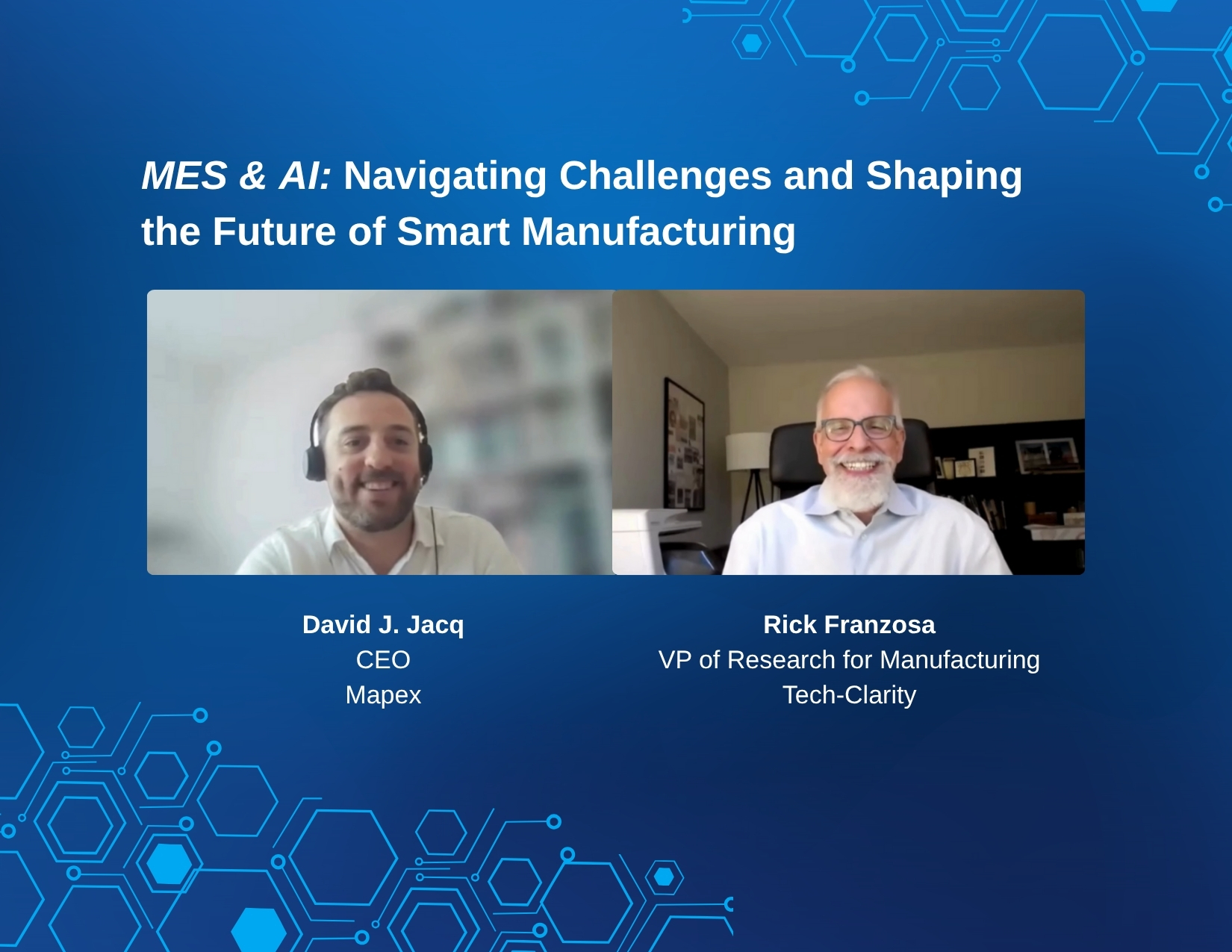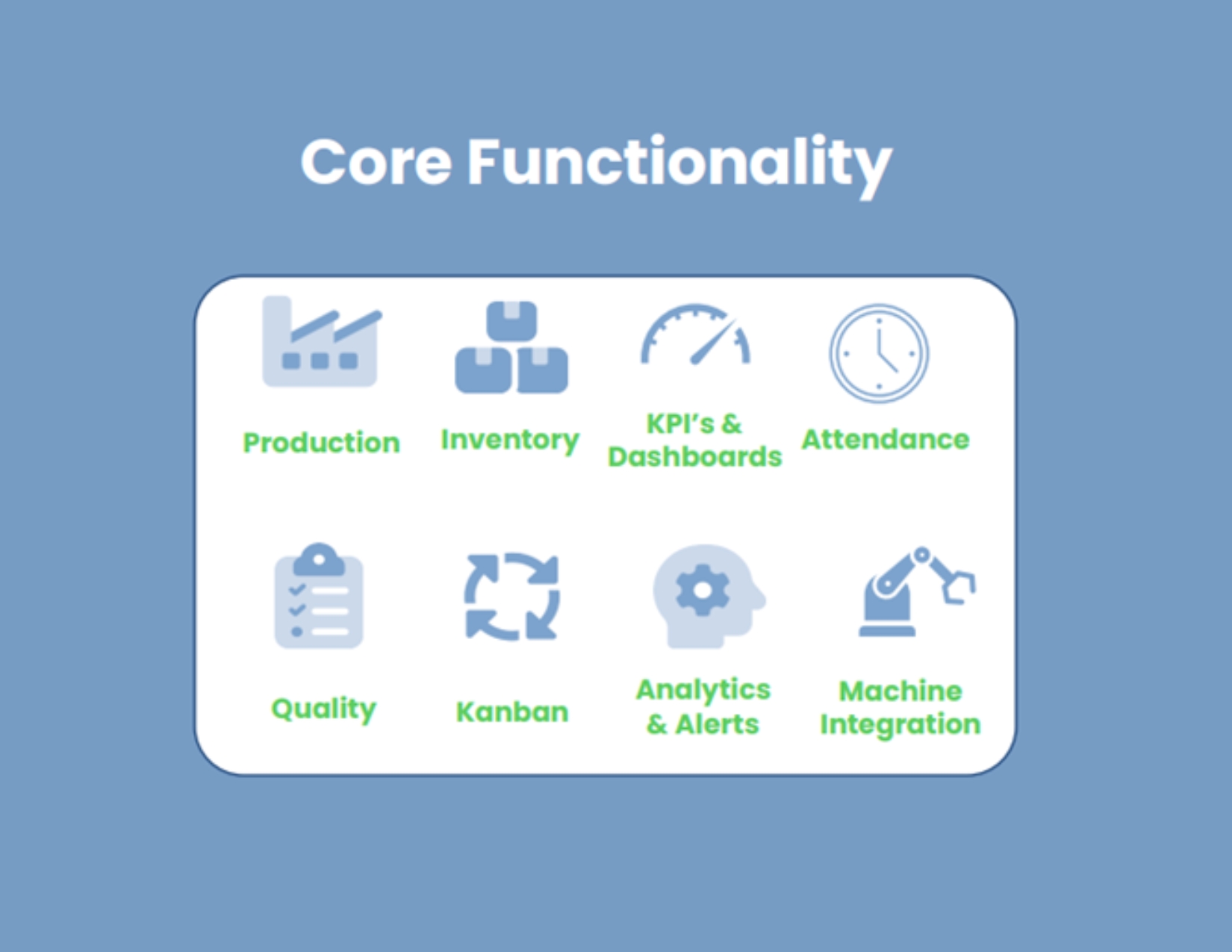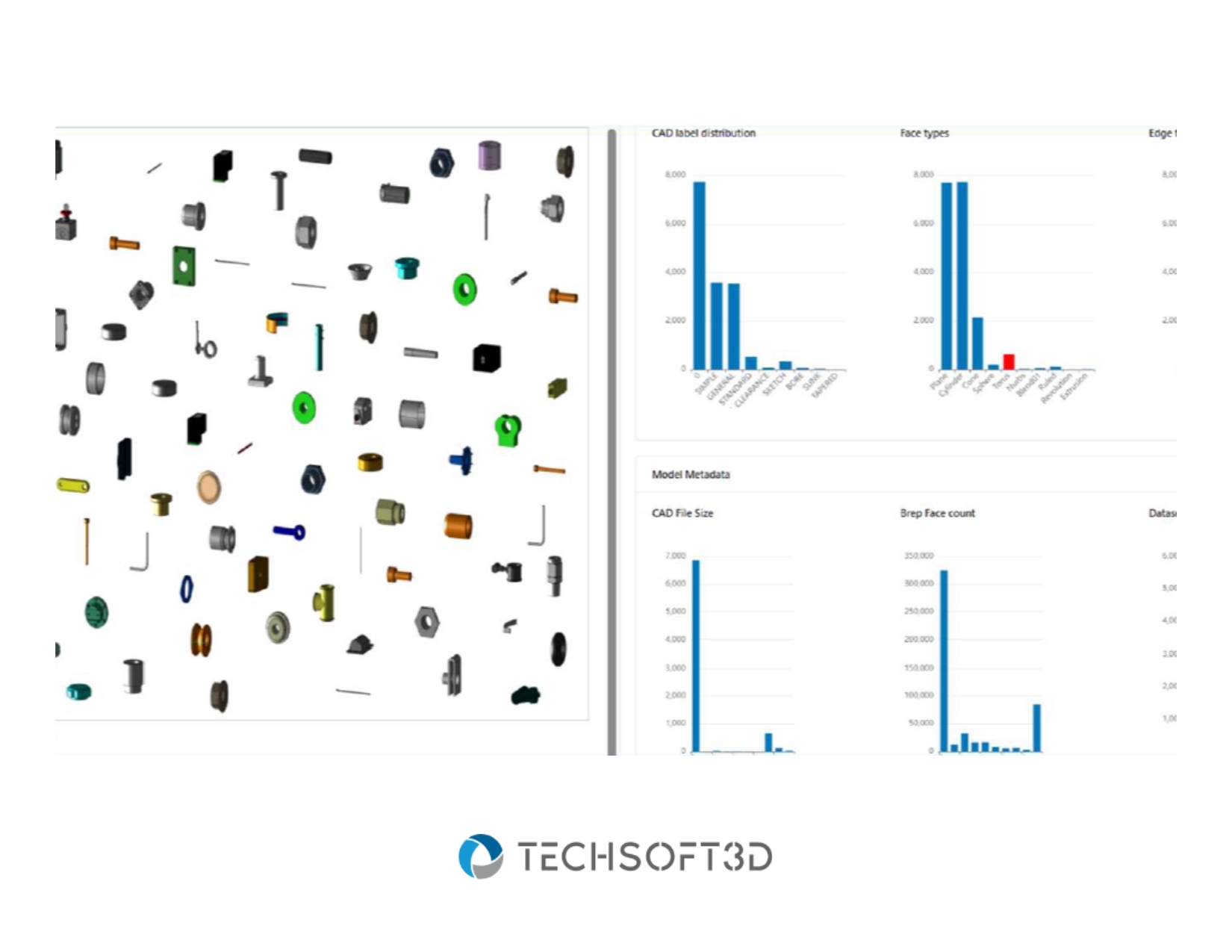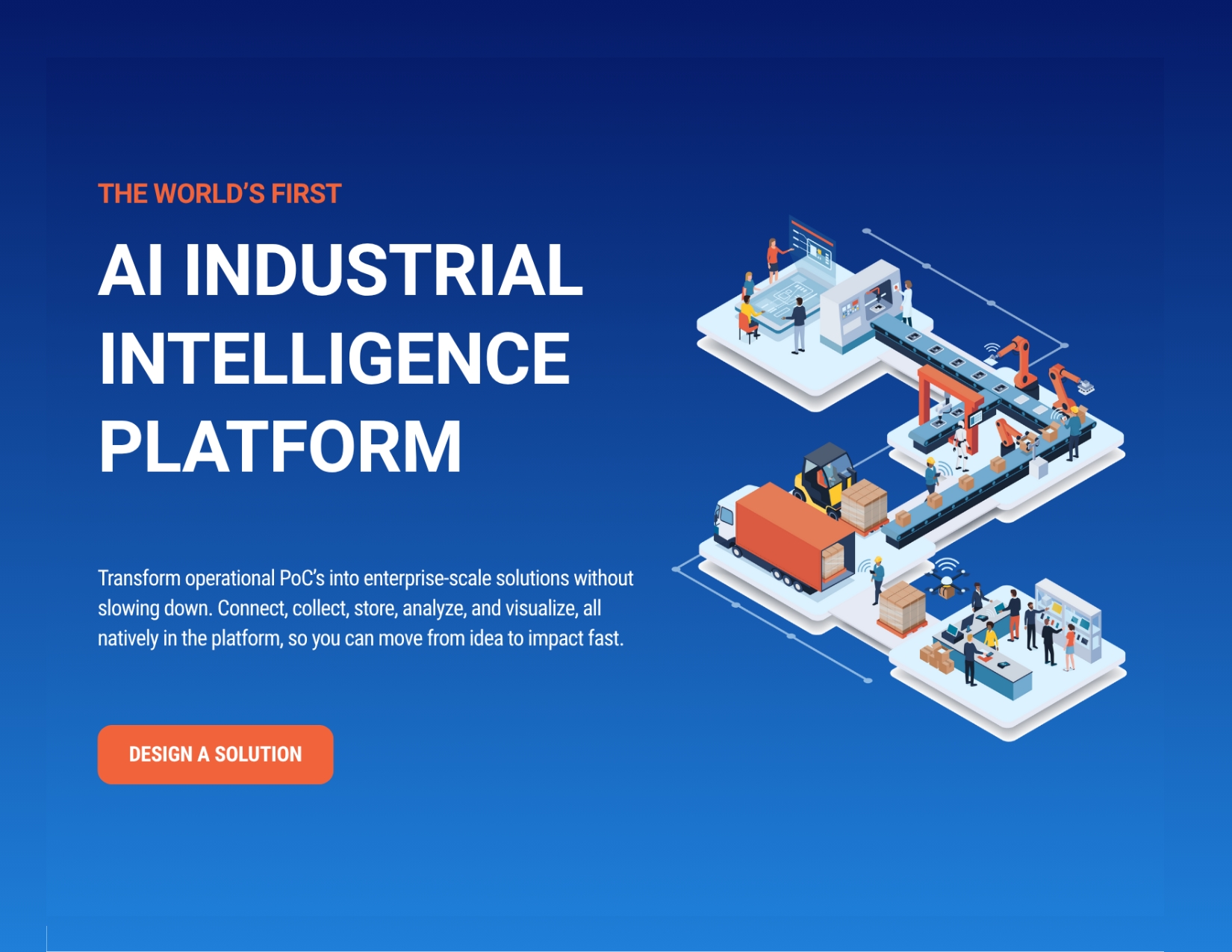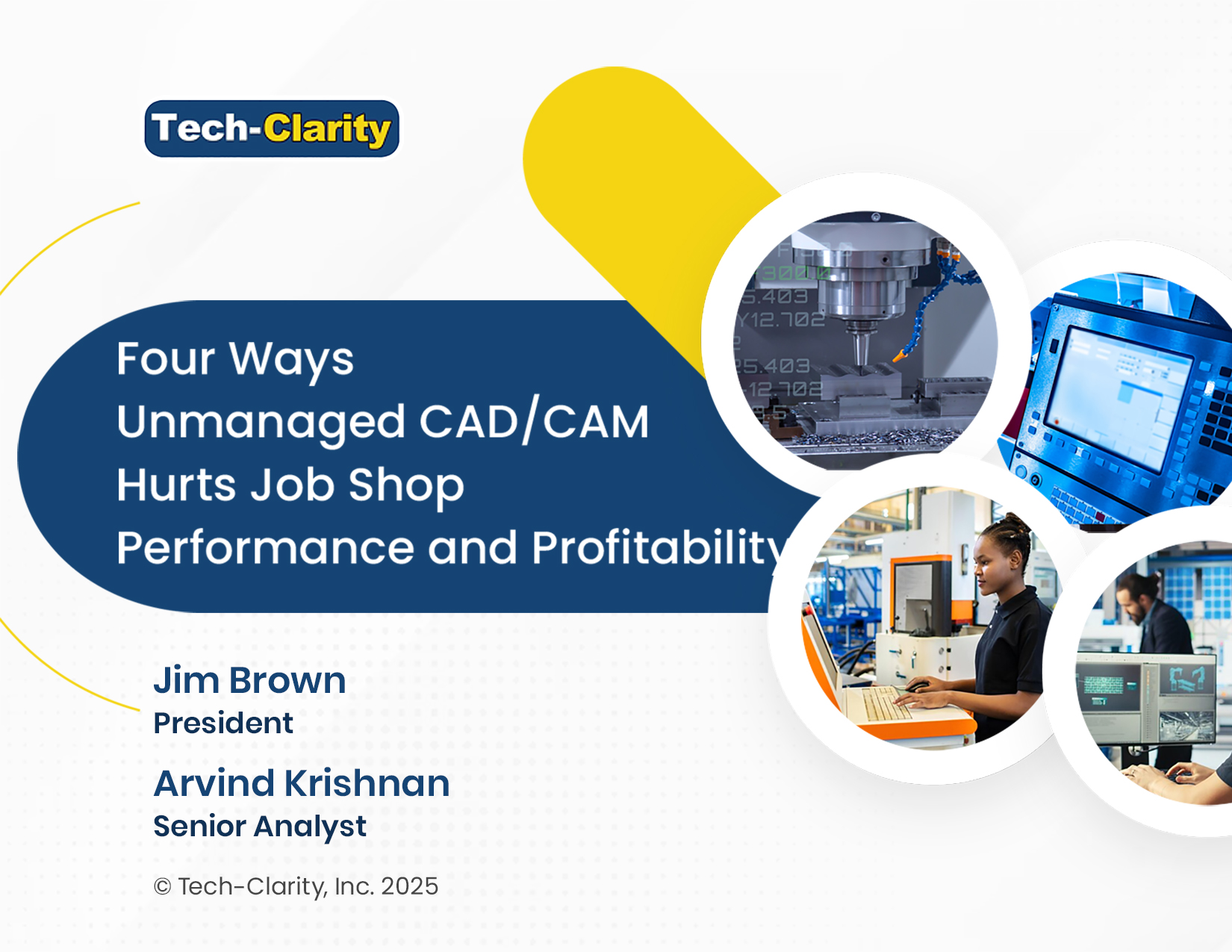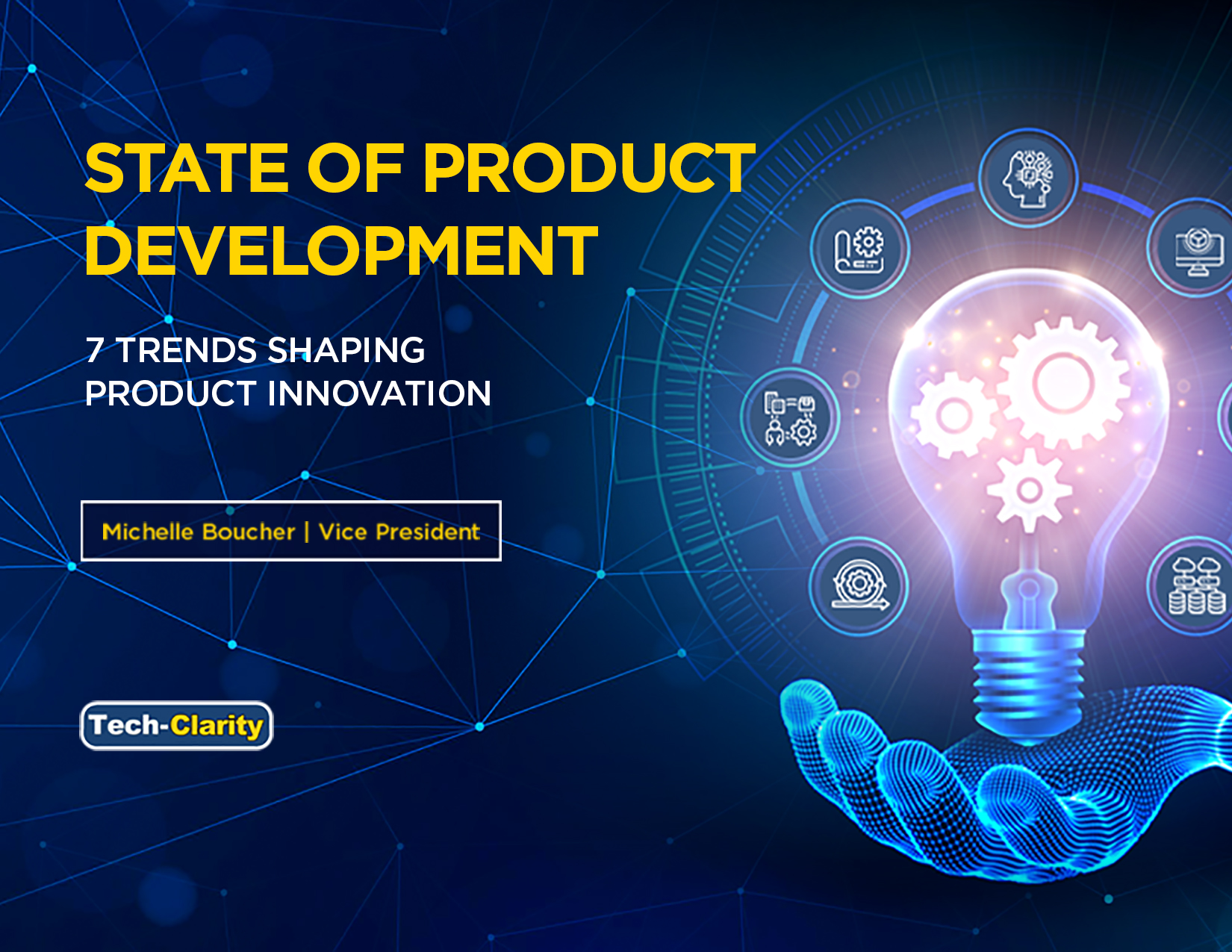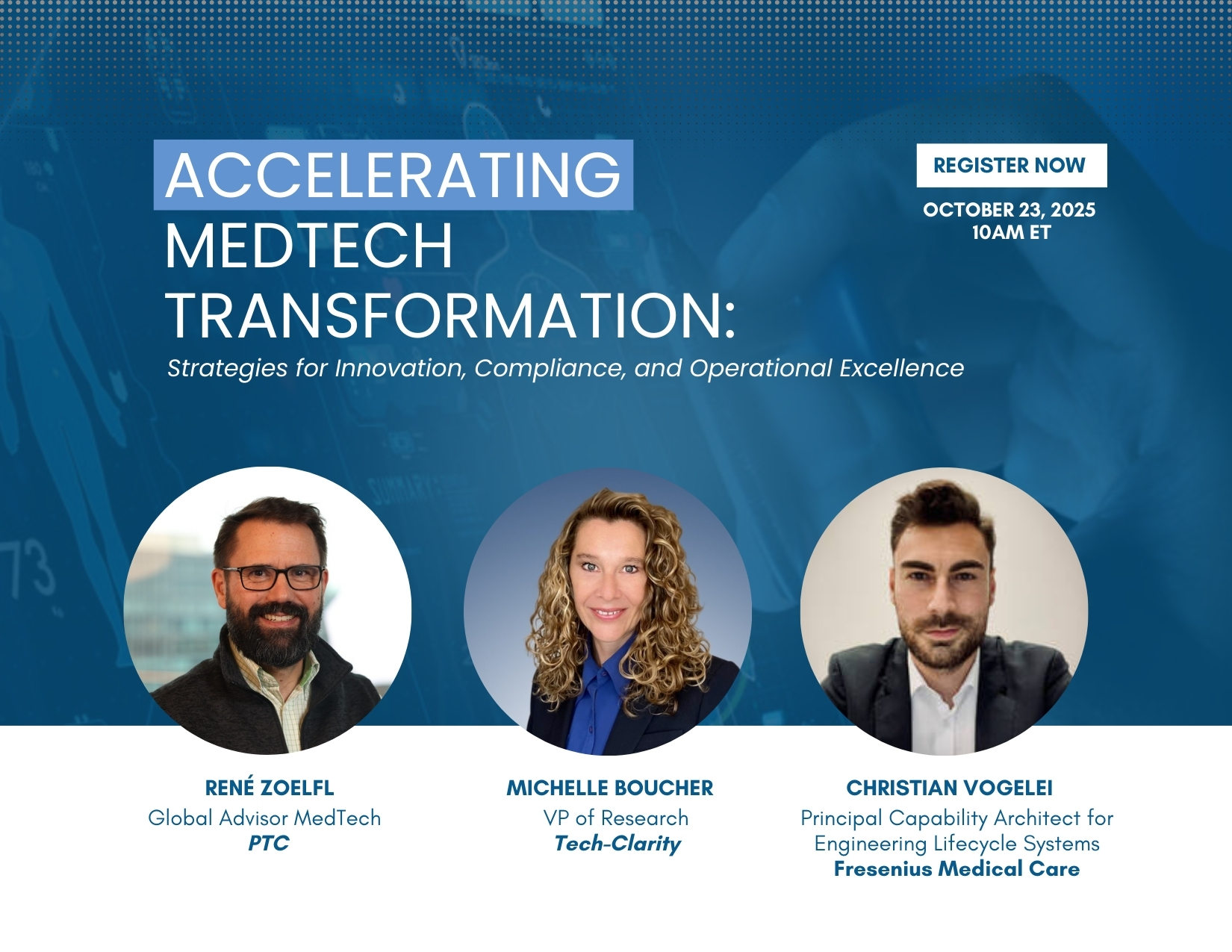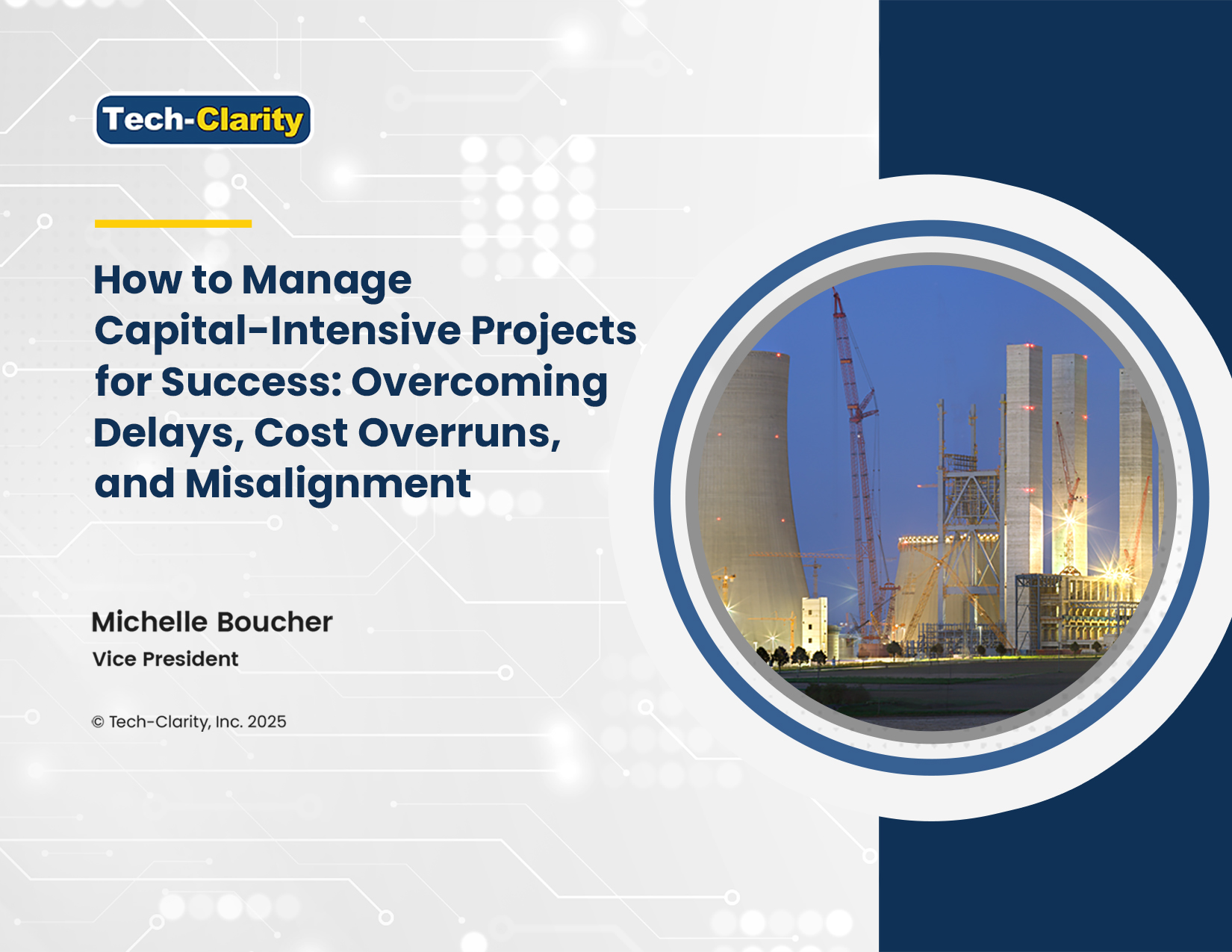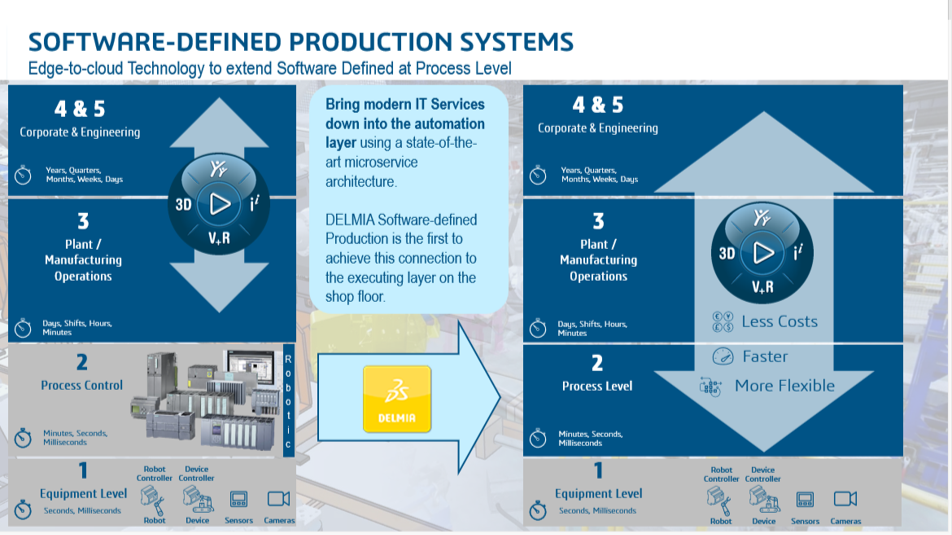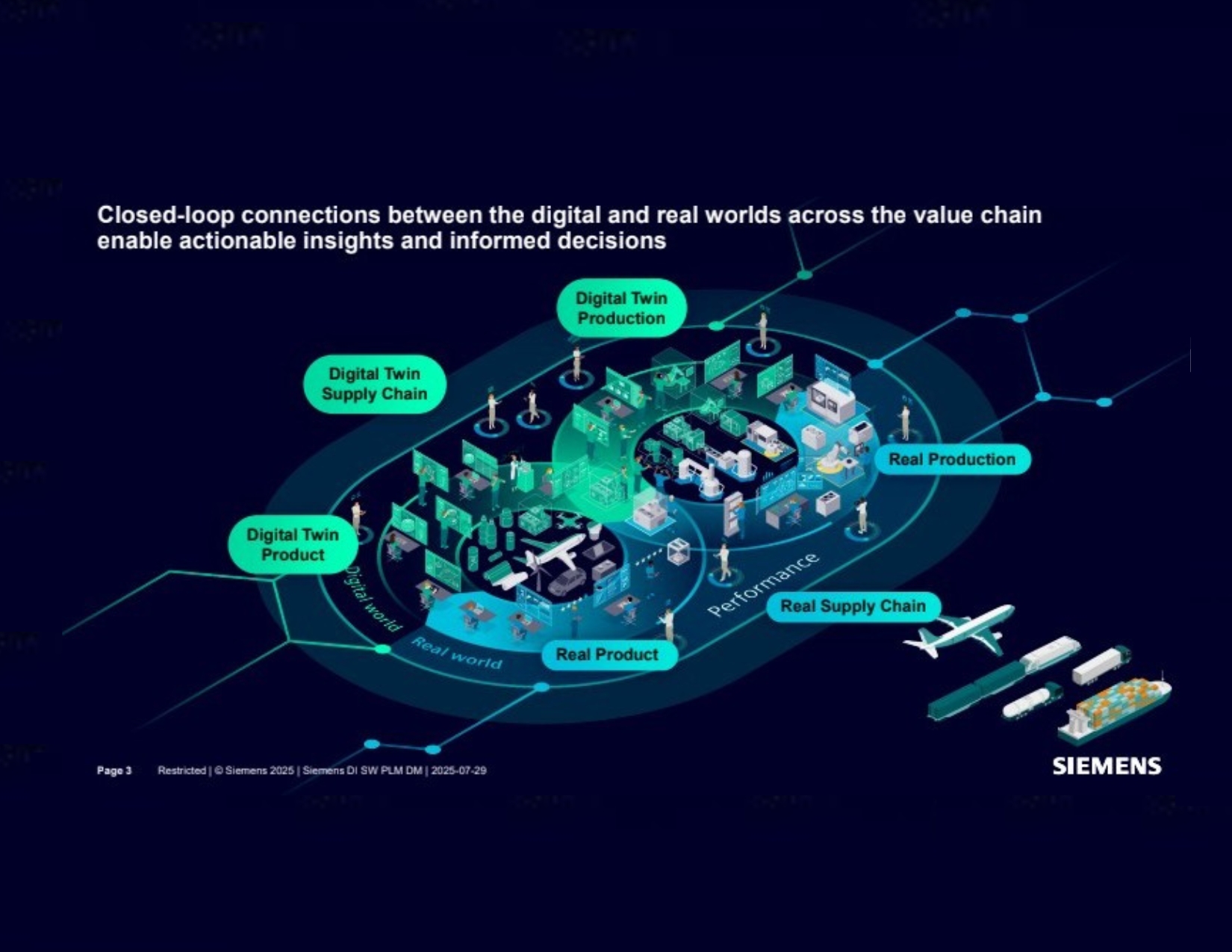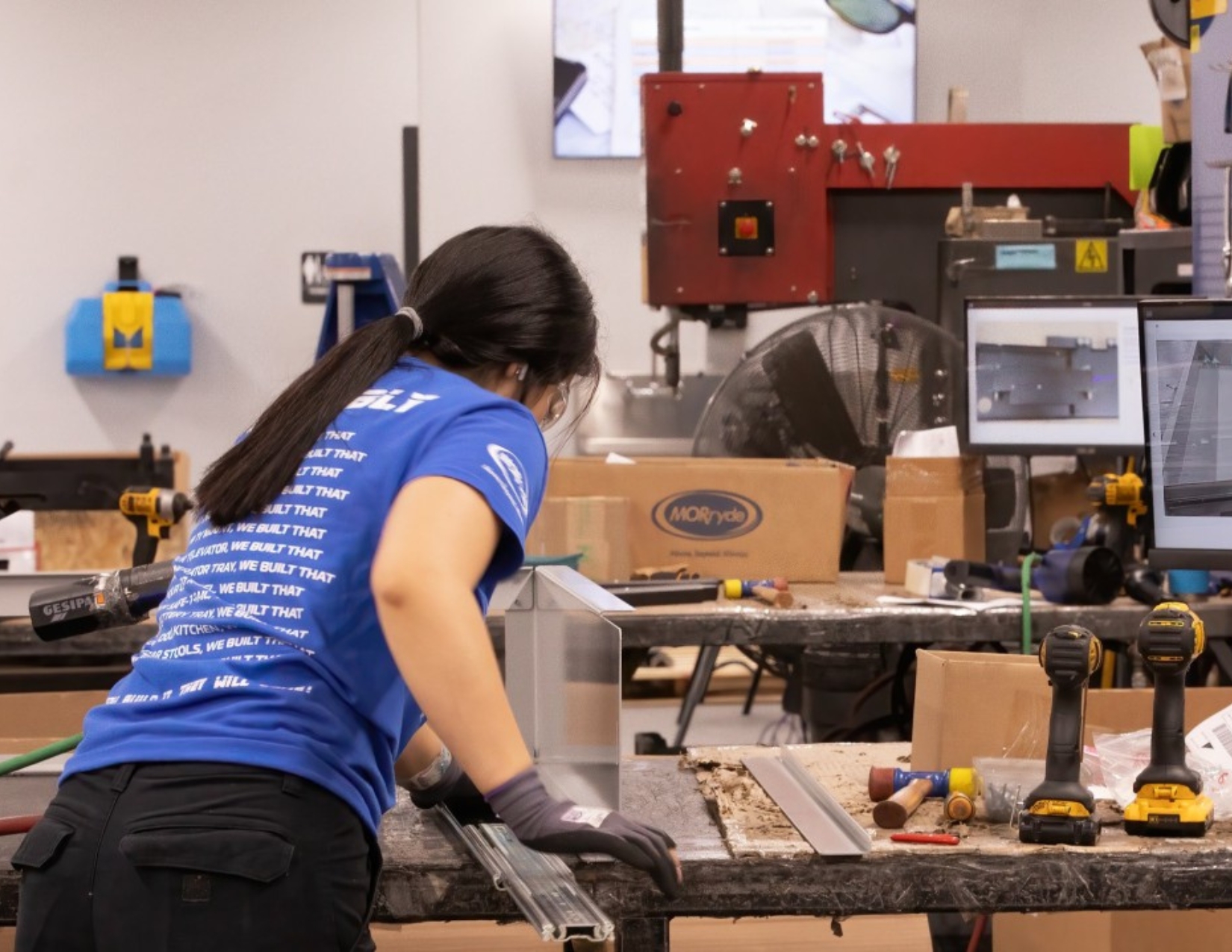Is your manufacturing organization ready for AI? In this conversation David J. Jacq, CEO of Mapex, and Rick Franzosa, VP of Research for Manufacturing at Tech-Clarity, Inc., will bring their deep expertise in digital transformation, operations, and advanced manufacturing to explore the challenges and opportunities in smart manufacturing in the age of AI. Listen as…
- Simplicity & User Adoption: Customers highlighted how MV2’s straightforward interface allows users to quickly learn the solution and adopt it in their production facilities. They also reported that it is easily tailored to fit business needs without requiring someone with strong IT skills.
- Cultural transformation: Customers said that MV2 is fostering a mindset of continuous improvement and empowering their shop floor teams to drive change.
- Efficiency gains: There were reports of a significant reduction in manual data entry with MV2, helping to enable proactive management. One customer reportedly eliminated 20 hours a week spent manually keying in data.
- Inventory Accuracy: One customer went from 70% data accuracy to averaging 90% accuracy over the past two years. Another touted the elimination of their annual physical inventory by achieving 95% daily accuracy on their cycle counts with MV2.
- Data-driven decisions: Customers reported increased accuracy in quoting, pricing, and labor cost analysis due to accurate production data in MV2.
Looking Forward
The evolution of MV2 is centered around three main pillars: scalability, interoperability, and user-centric design. Scalability ensures the MV2 product can grow alongside its customers' operations, accommodating increasing complexity without compromising performance. Interoperability focuses on seamless integration with other enterprise software systems, ensuring adaptability to different technological ecosystems. Ultimately, the user-centric approach prioritizes intuitive interfaces and streamlined processes, enabling manufacturers to optimize efficiency with minimal training and support requirements. Together, these pillars form the foundation for ISE's vision of delivering its comprehensive MV2 MES solution tailored to the distinct needs of smaller manufacturers.
Thanks to Jay Gentle, Erin Bonde, Chris McLean, Dan Van Kempen, Jim Rozewicz, and Rick Reith at ISE for catching us up on the latest news.
[post_title] => ISE MV2 Provides MES Functionality for an Underserved Market [post_excerpt] => [post_status] => publish [comment_status] => open [ping_status] => open [post_password] => [post_name] => ise-mv2 [to_ping] => [pinged] => [post_modified] => 2025-11-11 21:17:26 [post_modified_gmt] => 2025-11-12 02:17:26 [post_content_filtered] => [post_parent] => 0 [guid] => https://tech-clarity.com/?p=23150 [menu_order] => 0 [post_type] => post [post_mime_type] => [comment_count] => 0 [filter] => raw ) [2] => WP_Post Object ( [ID] => 23136 [post_author] => 2582 [post_date] => 2025-11-07 12:00:27 [post_date_gmt] => 2025-11-07 17:00:27 [post_content] =>Software Components and AI
Developing 3D engineering applications is seldom fast or easy. One way to ease development is to use commercially available software components. Software components are developer toolkits that provide standard application capabilities such as modeling, visualization, and data exchange. By using components, development resources can focus on the secret sauce that makes their application more valuable, different, or better at solving end-user challenges.
Today, it seems every application must include AI. Not only does AI enable unique, modern, and highly useful capabilities for companies doing internal software development, but it has also become table stakes for new applications entering the market. AI-enabled functionality will differ across applications. However, software components could provide some fundamental frameworks for AI development. Enter HOOPS AI.
Preview of HOOPS AI
Recently, Jonathan Girroir from Tech Soft 3D gave us a preview of HOOPS AI, a framework to help developers jumpstart their AI development. HOOPS AI is a set of tools built on top of HOOPS Exchange that support machine learning and AI research and development. Rich data sources are at the heart of machine learning. As a long-term provider of data interoperability tools, Tech Soft 3D toolkits process a robust set of translators that can provide rich engineering data to feed machine learning models. HOOPS AI can be used to clean, segment, and organize CAD data. This framework has the potential to quickly allow developers to build their own unique ML workflows.
Unlike typical text-based datasets for LLMs, HOOPS AI works with 3D engineering data such as surface geometry (B-rep), topology, metadata, and assembly relationships. HOOPS AI converts this data into machine-learning formats and connects to popular ML libraries. The machine learning framework includes additional tools for recording, storing, and optimizing workflows.
It should be noted that users of HOOPS AI will need to have their own training data. Tech Soft 3D provides an application development framework for connecting this data to ML algorithms. Tech Soft 3D does not have direct access to this data.
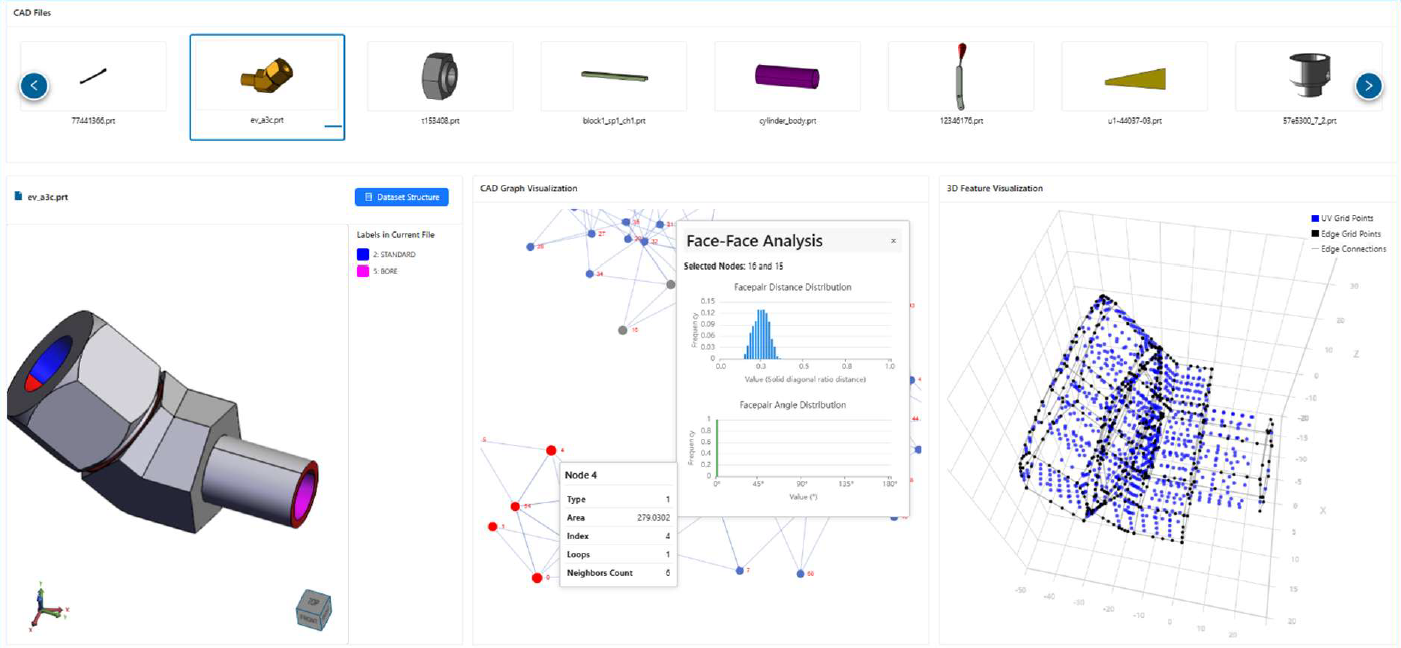
While the toolkit applies across a wide variety of applications and industries, Tech Soft 3D is currently focusing on early adopters in manufacturing, including internal development teams and commercial software vendors.
Our Take
Large independent software vendors likely have the data and resources to accomplish what Tech Soft 3D provides on their own; however, small to medium-sized companies with limited resources and data may find HOOPS AI to be a way to jumpstart their AI-enabled application development. Of course, it takes time for applications to leverage new toolkits and incorporate software components into their offerings. It will be fascinating to see the AI-enabled applications and corresponding capabilities that emerge leveraging HOOPS AI.
Thank you, Charrise Dalton, Fiona Minchella, and Jonathan for the briefing on HOOPS AI!
[post_title] => Tech Soft 3D Introduces HOOPS AI for Accelerated AI Adoption [post_excerpt] => [post_status] => publish [comment_status] => open [ping_status] => open [post_password] => [post_name] => hoops-ai-for-accelerated-ai-adoption [to_ping] => [pinged] => [post_modified] => 2025-11-11 21:19:26 [post_modified_gmt] => 2025-11-12 02:19:26 [post_content_filtered] => [post_parent] => 0 [guid] => https://tech-clarity.com/?p=23136 [menu_order] => 0 [post_type] => post [post_mime_type] => [comment_count] => 0 [filter] => raw ) [3] => WP_Post Object ( [ID] => 23126 [post_author] => 2574 [post_date] => 2025-11-06 21:00:51 [post_date_gmt] => 2025-11-07 02:00:51 [post_content] =>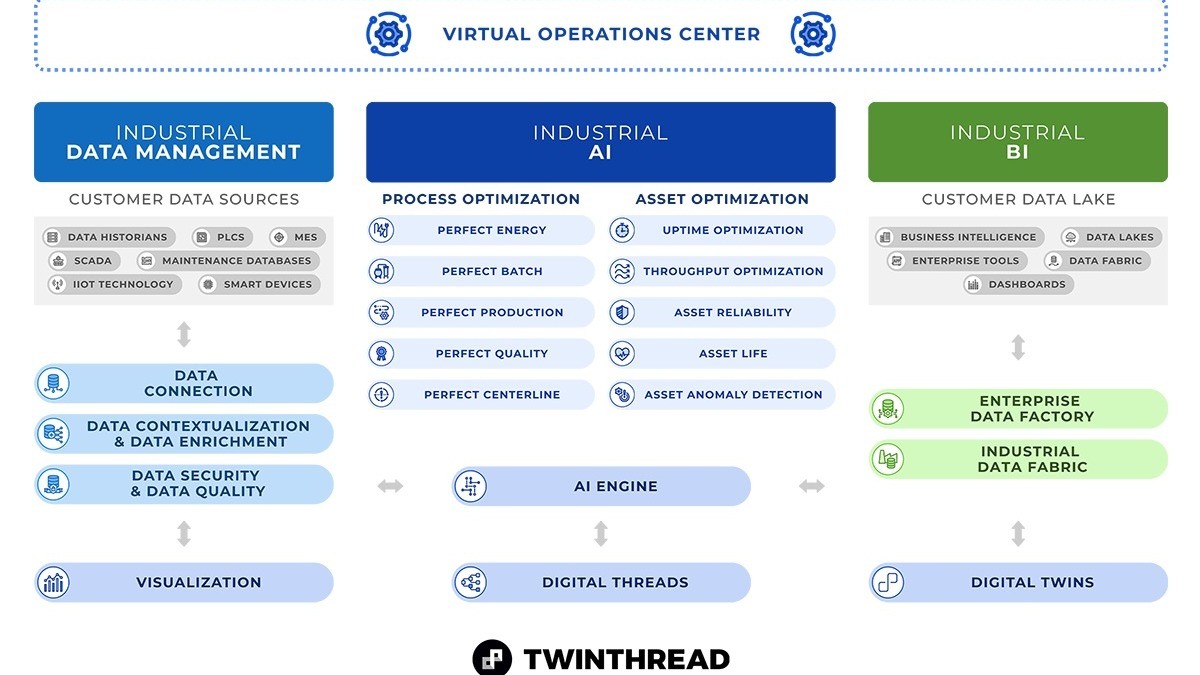 Once you have a digital twin of a plant that includes predictive and prescriptive AI capabilities, how could you improve it? TwinThread is doing that by adding genAI and agentic AI in Advisor to help accelerate model interpretation, as well as a new solution aptly named Perfect Centerline to help manage and stabilize the process effectively. These can both improve time-to-value for customers.
Once you have a digital twin of a plant that includes predictive and prescriptive AI capabilities, how could you improve it? TwinThread is doing that by adding genAI and agentic AI in Advisor to help accelerate model interpretation, as well as a new solution aptly named Perfect Centerline to help manage and stabilize the process effectively. These can both improve time-to-value for customers.
Additional AI: Advisor
The TwinThread Industrial AI platform is founded on pulling in operational data to build a comprehensive digital twin. To optimize performance, this PaaS includes predictive AI (as machine learning), and to take it a step further and close the loop, it also includes prescriptive AI. In addition to the core platform, TwinThread offers
- a virtual operations center enabling a manufacturing engineer anywhere to support the operation
- pre-built solutions for an even faster start.
You can find the basics about TwinThread and its offerings in our Insight posted in May 2025.
What’s new in this release is TwinThread Advisor, which includes both GenAI and Agentic AI capability. These language-based AI capabilities are context-aware, helping people interact with and interpret the results from the numbers-based predictive and prescriptive models in the core platform. This, in turn, can accelerate time to value, as anyone who has used AI to leverage a vast pile of information has experienced.
Incorporating the Advisor on top of TwinThread’s rich data set in a complete digital twin live model of a production site offers many potential benefits. Supporting understanding is a foundation. Process engineers, operators, and digital teams, as well as data scientists, can all benefit. It enables Q&A in their native language, performs global search, and builds analytical content. The agents in Advisor can integrate with various systems, and each has a specific persona that works in conjunction with other agents in a context-aware manner.
Advisor can use the TwinThread knowledge base of that customer’s operation, plus, if desired, the Internet. The customer has complete control of where the system pulls data. Using the corporation’s own data only is an option that can actually reduce spending on the cloud hosting service. It has complete security, is designed for privacy, and does not entail the sharing of one customer’s data with others. Advisor is currently available as a preview, an optional capability.
Perfect Centerline
Engineers in process industries are almost certainly familiar with centerlining to minimize variability from run to run. Most companies do it, but this new pre-built TwinThread Perfect Centerline solution automates managing the centerlining process and improves it with each run. These advanced capabilities are now fully launched to make it simpler to derive and manage centerlines with confidence.
The customer can set up to five target KPIs. The system will then monitor and automatically optimize to those objectives. The system enables overriding automated setpoints and displays the centerline, current readings, and statistics about the run in real-time. To avoid users being overwhelmed, the system can also simply display centerline deviations. TwinThread projects a 50-75% increase in process stability, which can yield significant benefits.
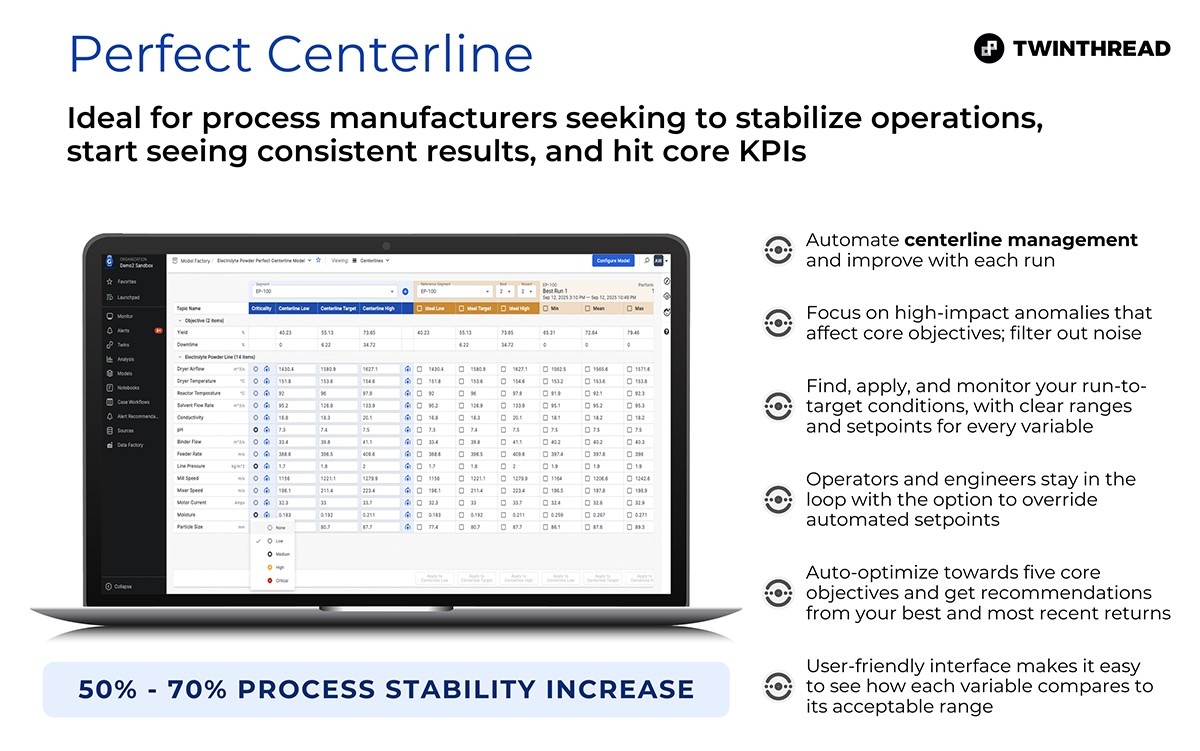
TwinThread expects this to be a point of entry for most customers, as a baseline. The process model first derives a centerline, which process engineers can modify, if desired. Once the data is all connected in the platform, centerline analysis can be performed in minutes, indicating how much the process might improve. If the financial impact per percentage of each objective KPI is established upfront, the system can deliver a value-based view of optimizing to the centerline. TwinThread states that if the company has a historian, this transition from legacy to advanced approach may even occur within a week.
Deeper Insights for Value
Once implemented, TwinThread’s proven predictive and prescriptive industrial AI and digital twin platform has a comprehensive and up-to-date data set. This is a rich starting point for genAI and agentic AI to deliver value. It is also a perfect home for advanced centerlining capabilities.
Thank you, Elise Loffredo, Jason Dietrich, and Andrew Waycott, for briefing Rick Franzosa and Julie Fraser.
on these new capabilities. We are excited to see both the added AI and the streamlined centerlining. We look forward to learning what you add next.
[post_title] => TwinThread Adds Advisor, Centerline Solution [post_excerpt] => [post_status] => publish [comment_status] => open [ping_status] => open [post_password] => [post_name] => perfect-centerline [to_ping] => [pinged] => [post_modified] => 2025-11-11 21:09:59 [post_modified_gmt] => 2025-11-12 02:09:59 [post_content_filtered] => [post_parent] => 0 [guid] => https://tech-clarity.com/?p=23126 [menu_order] => 0 [post_type] => post [post_mime_type] => [comment_count] => 0 [filter] => raw ) [4] => WP_Post Object ( [ID] => 23071 [post_author] => 2 [post_date] => 2025-11-05 10:06:12 [post_date_gmt] => 2025-11-05 15:06:12 [post_content] => Product innovation today is driven by an orchestration of mechanical, electrical, and software components working together as a system. So why hasn’t ECAD data management gotten the attention compared to MCAD data management with PDM? ECAD designs have gone uncontrolled in most engineering organizations for too long. It’s time for manufacturers to modernize how they manage EDA designs. This eBook shares five key ways that companies can bring ECAD into the product digital thread.
Please enjoy the summary* below. For the full research, please visit our sponsor, Accelerated Designs (registration required).
Product innovation today is driven by an orchestration of mechanical, electrical, and software components working together as a system. So why hasn’t ECAD data management gotten the attention compared to MCAD data management with PDM? ECAD designs have gone uncontrolled in most engineering organizations for too long. It’s time for manufacturers to modernize how they manage EDA designs. This eBook shares five key ways that companies can bring ECAD into the product digital thread.
Please enjoy the summary* below. For the full research, please visit our sponsor, Accelerated Designs (registration required).
Table of Contents
- The Business Imperative to Improve Electronic Design
- The Role of ECAD and PLM in the Digital Thread
- 1) Enable Efficient Engineering
- 2) Enable Better Design Decisions
- 3) Manage the ECAD Digital Thread
- 4) Collaborate on the Full Product Design
- 5) Connect the Holistic Digital Thread
- Conclusion / Call to Action
- About the Author
The Business Imperative to Improve Electronic Design
Today’s Processes are too Slow and Disconnected Today’s products are more hardware and software-driven across almost every industry. This raises the bar on efficient, effective electronic design to rapidly bring quality, innovative products to market. ECAD (electronic computer-aided design) solutions have enabled great strides for individual engineers, but there is still too much inefficiency and non-value-added work in electronic design, slowing design cycles. Beyond inefficiency impacting individual engineers, current processes and tools typically lead to disconnected design efforts across teams and disciplines. Combined, these inefficiencies further slow design times and time to market, resulting in reduced market share and profit margins. Improving Time to Market How can manufacturers improve their electronic design processes to bring products to market faster and drive profitable revenue? We identified five keys to help.The Role of ECAD and PLM in the Digital Thread
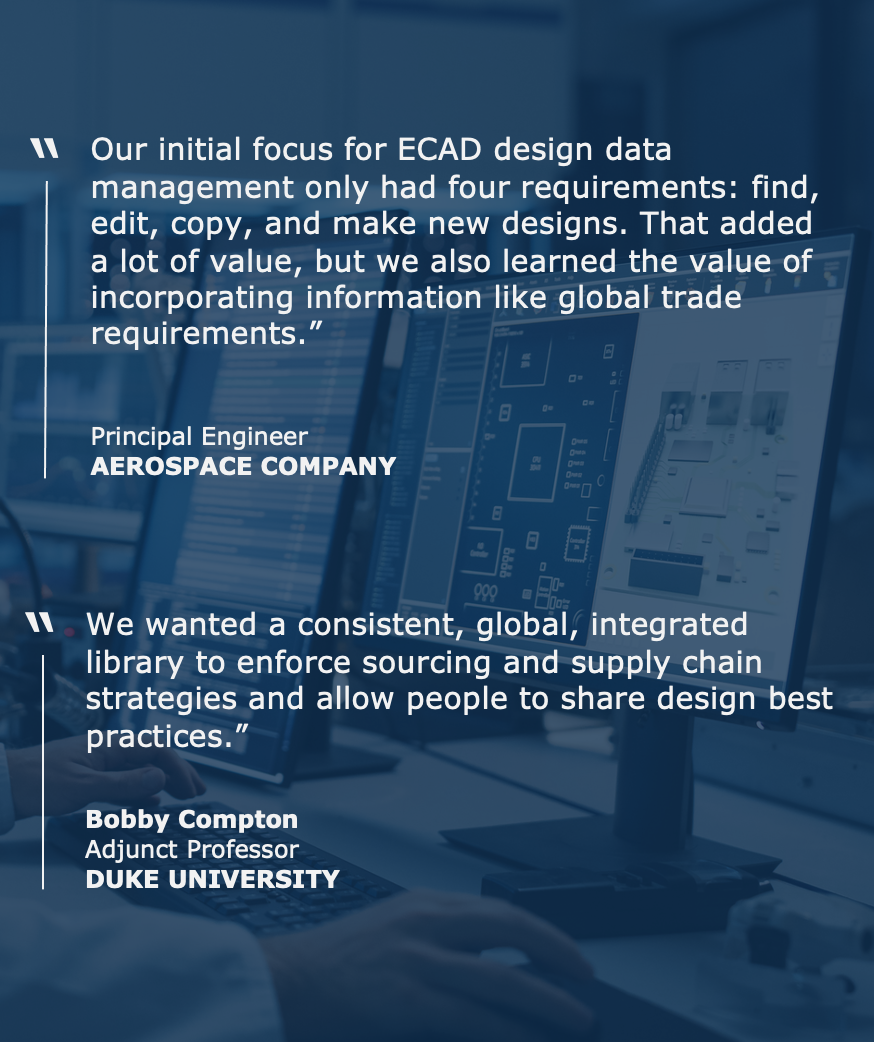 The Status Quo
Why are design cycles slow? Today’s status quo is disconnected processes and disconnected systems. Engineers too frequently make decisions without accurate, timely information. Further, lack of integrated design processes, ECAD systems, and electronic design data leads to suboptimal decisions that require costly and time-consuming rework. Finally, lack of ECAD interoperability limits design reuse and hampers sharing and collaboration across design teams and the supply chain.
It’s Time to Change
Companies must increase the efficiency of their engineers and engineering teams. They can’t do it without integrating electronic design data into the full product digital thread. First, engineers must have data readily available to make design decisions to get products right the first time. They should have accurate, up-to-date information in a common environment and centralized ECAD data management across teams, locations, and systems to enable collaboration and reuse. As a principal engineer for an aerospace company explains, “Ideally, I want one master system that talks to all ECAD systems, manages the whole ecosystem, and talks to multiple toolsets and PLMs.”
Electronic designs should be centrally managed across ECAD solutions. Then, the design data should be made available in a broader product context to facilitate collaboration across design disciplines and enable other applications, including AI. Unfortunately, there are no ECAD and PLM solutions available as part of a single platform. The best path to include ECAD in the digital thread in the foreseeable future is to consolidate ECAD design data, manage data from different design disciplines separately, and then create a holistic view at the product level in PLM.
Improving the Status Quo
So how can companies get the most out of ECAD and PLM investments to drive time to market? We propose five ways companies can improve processes and we’ll review each of these in detail:
The Status Quo
Why are design cycles slow? Today’s status quo is disconnected processes and disconnected systems. Engineers too frequently make decisions without accurate, timely information. Further, lack of integrated design processes, ECAD systems, and electronic design data leads to suboptimal decisions that require costly and time-consuming rework. Finally, lack of ECAD interoperability limits design reuse and hampers sharing and collaboration across design teams and the supply chain.
It’s Time to Change
Companies must increase the efficiency of their engineers and engineering teams. They can’t do it without integrating electronic design data into the full product digital thread. First, engineers must have data readily available to make design decisions to get products right the first time. They should have accurate, up-to-date information in a common environment and centralized ECAD data management across teams, locations, and systems to enable collaboration and reuse. As a principal engineer for an aerospace company explains, “Ideally, I want one master system that talks to all ECAD systems, manages the whole ecosystem, and talks to multiple toolsets and PLMs.”
Electronic designs should be centrally managed across ECAD solutions. Then, the design data should be made available in a broader product context to facilitate collaboration across design disciplines and enable other applications, including AI. Unfortunately, there are no ECAD and PLM solutions available as part of a single platform. The best path to include ECAD in the digital thread in the foreseeable future is to consolidate ECAD design data, manage data from different design disciplines separately, and then create a holistic view at the product level in PLM.
Improving the Status Quo
So how can companies get the most out of ECAD and PLM investments to drive time to market? We propose five ways companies can improve processes and we’ll review each of these in detail:
- Enable efficient engineering
- Enable better design decisions
- Manage the ECAD digital thread
- Collaborate in full product design context
- Connect the holistic digital thread
Conclusion / Call to Action
Status Quo It’s time to get beyond today’s status quo of disconnected systems for electronic design. Instead, companies should adopt centralized ECAD data management and leverage PLM to orchestrate the full design process without owning the electronic design process or managing detailed ECAD data. We identified five ways to improve over the status quo that can help create an integrated digital thread, reduce errors, corrective actions, and rework to get products to market faster. At the same time, these approaches improve designs by optimizing design decisions early to design in greater supply chain resilience, better compliance, lower cost, and lower risk. Enable the Change These changes must be supported by the right combination of technology, including ECAD data management to manage multi-CAD electronic data, a consolidated component library to improve design decision-making, and integration with PLM to create a holistic product digital thread. Ideally, this would all be on a single platform from a single vendor, but that’s not the reality today. Today, the better way to operate is to:- Put the right data directly into the ECAD environment, regardless of the ECAD tool, to create a central source of truth for electronic design data
- Provide component library data inside the ECAD environment to provide data ranging from technical specifications to business and supply chain data
- Manage the ECAD digital thread across ECAD tools to improve collaboration, efficiency, and reuse
- Collaborate in the full product design context
- Connect the holistic digital thread in PLM
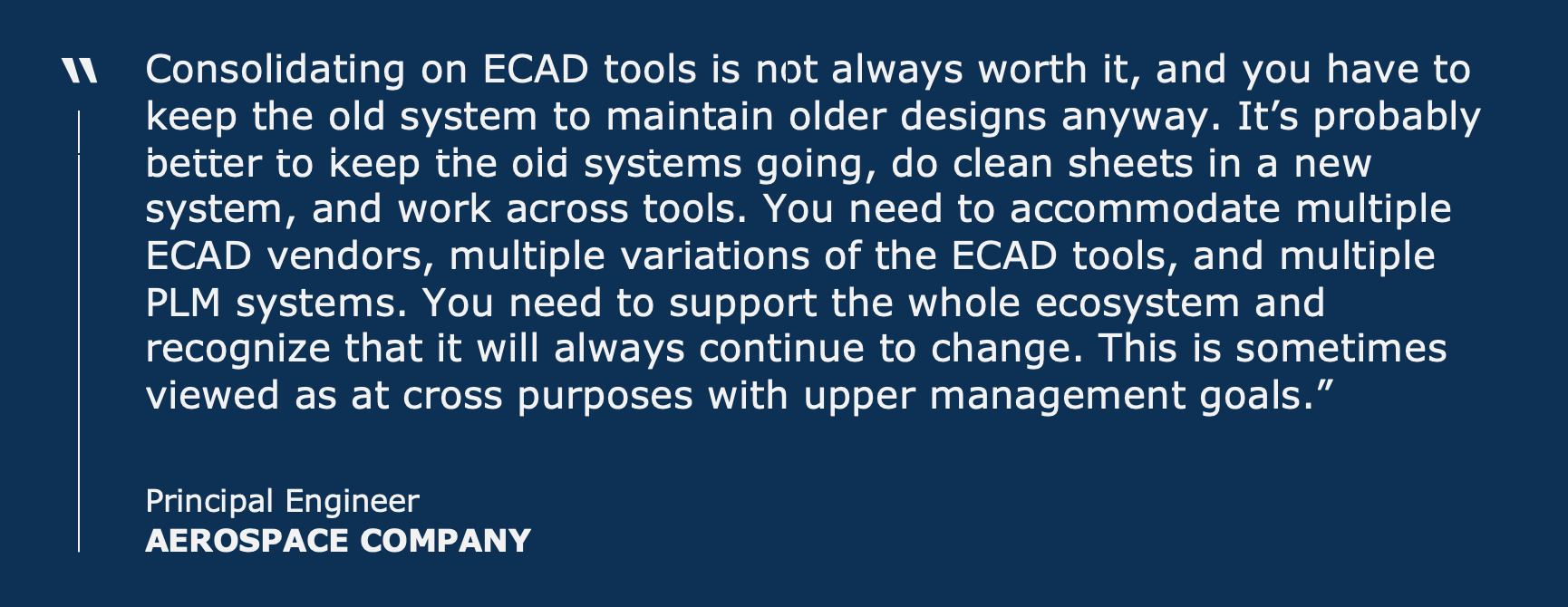 *This summary is an abbreviated version of the ebook and does not contain the full content. For the full report, please visit our sponsor Accelerated Designs.
If you have difficulty obtaining a copy of the research, please contact us.
[post_title] => Five Keys to Bring ECAD into the Digital Thread
[post_excerpt] =>
[post_status] => publish
[comment_status] => open
[ping_status] => open
[post_password] =>
[post_name] => ecad-into-the-product-digital-thread
[to_ping] =>
[pinged] =>
[post_modified] => 2025-11-05 10:56:21
[post_modified_gmt] => 2025-11-05 15:56:21
[post_content_filtered] =>
[post_parent] => 0
[guid] => https://tech-clarity.com/?p=23071
[menu_order] => 0
[post_type] => post
[post_mime_type] =>
[comment_count] => 0
[filter] => raw
)
[5] => WP_Post Object
(
[ID] => 23039
[post_author] => 2
[post_date] => 2025-10-15 09:27:25
[post_date_gmt] => 2025-10-15 13:27:25
[post_content] =>
*This summary is an abbreviated version of the ebook and does not contain the full content. For the full report, please visit our sponsor Accelerated Designs.
If you have difficulty obtaining a copy of the research, please contact us.
[post_title] => Five Keys to Bring ECAD into the Digital Thread
[post_excerpt] =>
[post_status] => publish
[comment_status] => open
[ping_status] => open
[post_password] =>
[post_name] => ecad-into-the-product-digital-thread
[to_ping] =>
[pinged] =>
[post_modified] => 2025-11-05 10:56:21
[post_modified_gmt] => 2025-11-05 15:56:21
[post_content_filtered] =>
[post_parent] => 0
[guid] => https://tech-clarity.com/?p=23071
[menu_order] => 0
[post_type] => post
[post_mime_type] =>
[comment_count] => 0
[filter] => raw
)
[5] => WP_Post Object
(
[ID] => 23039
[post_author] => 2
[post_date] => 2025-10-15 09:27:25
[post_date_gmt] => 2025-10-15 13:27:25
[post_content] => 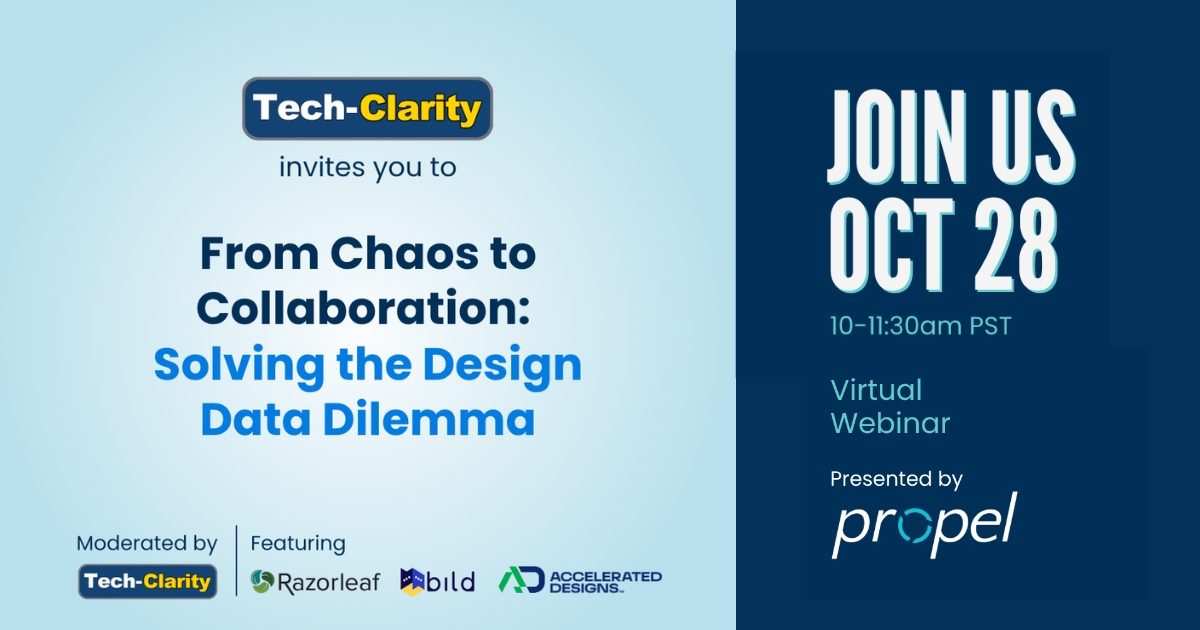 How can manufacturers manage their complex design data, including both MCAD and ECAD files, to streamline design, eliminate wasted time looking for design data, and improve collaboration? Jim Brown will moderate a webinar, From Chaos to Collaboration: Solving the Design Data Dilemma, to hear from Propel and their partners on how they can seamlessly manage CAD data of different formats.
Learn from:
How can manufacturers manage their complex design data, including both MCAD and ECAD files, to streamline design, eliminate wasted time looking for design data, and improve collaboration? Jim Brown will moderate a webinar, From Chaos to Collaboration: Solving the Design Data Dilemma, to hear from Propel and their partners on how they can seamlessly manage CAD data of different formats.
Learn from:
- CEO of Propel, Ross Meyercord
- CPO of Propel, Eric Schrader
- President & Founder of Tech-Clarity, Jim Brown
- Head, Value Engineering & Services for Accelerated Designs, Sanjay Keswani
- CEO of Bild, Pradyut Paul
- VP of Product, Razorleaf, Tim Noce
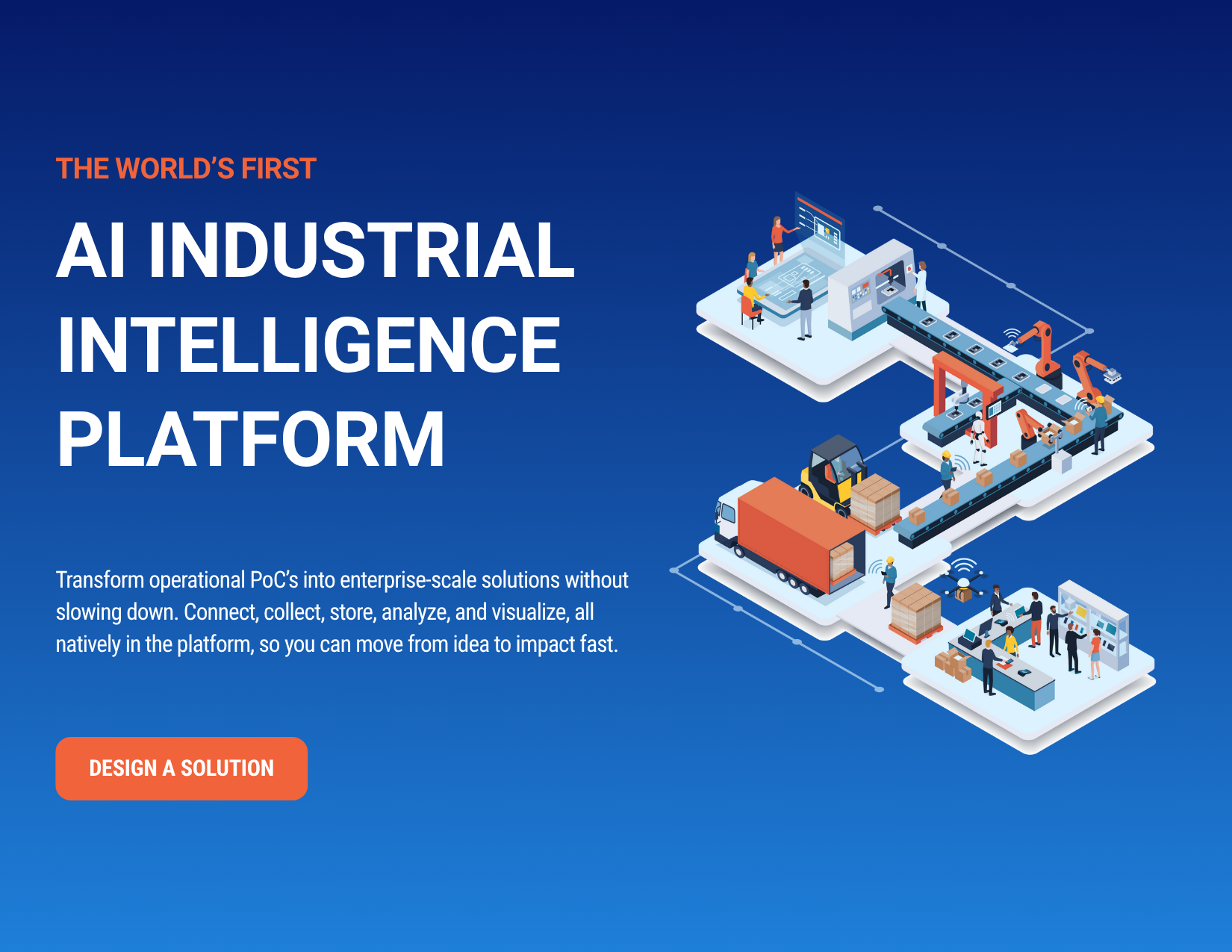
How far can large enterprises go in consolidating their software stack from IIoT and data foundations to apps? Could a startup EV OEM run its business on just two pieces of software? Fuuz, by MFGx, aims to answer that second question with a yes, using just Fuuz and Oracle NetSuite. We recently had an update briefing with Fuuz, and their focus has changed since our last conversation. They don’t fit neatly into a category and are calling what they do an industrial intelligence platform. Fuuz includes IIoT, a comprehensive data stack, no-code/low-code rapid application development tools, and MES, WMS, APS, Quality, CMMS, as well as Production and Process Monitoring solutions.
Fuuz initially aimed its platform and applications offering at small and medium businesses (SMBs) who wanted to extend their ERP to the shop floor. It still serves many SMBs with greenfield operations; however, they discovered that manufacturers with over $300 million in revenue are more mature. Their experience typically means they have a deeper understanding of why the combination of IIoT, a modern full-stack data management platform, and Purdue Model or ISA95 Level 3 applications can deliver immediate and lasting benefits.
The Fuuz platform is within multi-tenant SaaS, where each customer has their own segmented resources and database. This delivers cloud benefits while also accommodating highly regulated industries. Its Gateway enables edge connection for devices such as industrial controls, printers, scales, and CMMs, as well as edge computing. The Fuuz team claims to be winning against OT software players, IT data platform players, and manufacturing IT application powerhouses.
IT Consolidation with Intelligence
Many larger companies have been attempting to build out their architecture for years. One Fuuz customer is planning to replace 12 different software products with one. Some of the recent customer announcements include large and startup companies in pet food (planning to replace eight applications), EVs, auto parts, aviation, and life sciences.
Fuuz offers consolidation at many levels.
- Industrial device and IIoT connection and data structuring
- Unified name space (UNS) where OT systems data all feed into a single, structured data model
- Manufacturing IT data ontology, management, and governance, where IT and OT data come together in a comprehensive, managed way for clean data with clear provenance and lineage
- Manufacturing applications, including MES, WMS, APS, Quality, CMMS, Production and Process Monitoring
- Supply chain partner visibility – this is a new area that an automnning to replace 12 different software products with one. Some of the recent customer announcements include large and startup companies in pet food (planning to replace eight applications), EVs, auto parts, aviation, and life sciences.

Customers Choose
Tailor UIs, Workflows, and Apps – The Fuuz Platform offers tools, including a responsive UI builder, a workflow builder, and its own apps, as well as low-code app-building capabilities. A key differentiator is that they built these tools to address the scaling challenges of low-code/no-code solutions, implementing them as an SI before shifting entirely to a software company.
Unified Data Ontology – Each customer can select whether to use ISA95 or another structure for their enterprise data. The ontology is based on a no-code MongoDB and can span the entire enterprise.
AI Tools – The Fuuz team has decided not to build AI into the system. Customers can use its GraphQL APIs, data flows, and native MCP cloud or edge capabilities to integrate with any LLMs or AI tools they choose.
High-Value Starting Points – Since the platform encompasses everything an app needs, companies can start with their high-priority applications and obtain the entire infrastructure required for them to function. This is in stark contrast to many enterprise infrastructure approaches, which can require years before the high-value applications work well.
Continued Growth
Fuuz’s strategy to sell and implement through partners remains strong. The ecosystem is growing, and partners have substantial control over the IP they put out on the Fuuz marketplace.
Partners have traditionally included ERP companies and their service partners. These include NetSuite, PwC, CohnReznick, Strategic Information Group, Western Computer, and Guidepath Consulting. Other partners are from IIoT, OT, or PLM backgrounds, such as Razorleaf Corporation, Castor Engineering, and newly-launched Abelara. Some have used the Fuuz platform to build their own MES, WMS, and EDI applications. Recently, Fanuc Robotics America Inc has started building Fuuz into its products to enable remote monitoring and predictive maintenance.
Fuuz’s partners often have deep and lasting relationships with customers. The partner vetting process is rigorous, ensuring that partner solution architects can help companies envision their future digital support. The goal is to grow with customers through these strong partner relationships.
Looking to the Future
Fuuz built to a vision a decade ago that few others had. At the core of the platform are flexible, modern, scalable technologies. They continue to improve, but are not flitting from one new technology trend to the next. They are building out from the original vision in a versionless approach, where upgrades never entail downtime, and customer implementations continue to support evolution.
Thank you, Craig Scott, Brad Hafer, and Steve Modrall, for briefing us on the state of the Fuuz and where Fuuz is igniting value.
[post_title] => Fuuz Doubles Down on Enterprise for Industrial DataOps and Level 3 Apps [post_excerpt] => [post_status] => publish [comment_status] => open [ping_status] => open [post_password] => [post_name] => industrial-intelligence-platform [to_ping] => [pinged] => [post_modified] => 2025-11-03 20:34:30 [post_modified_gmt] => 2025-11-04 01:34:30 [post_content_filtered] => [post_parent] => 0 [guid] => https://tech-clarity.com/?p=23104 [menu_order] => 0 [post_type] => post [post_mime_type] => [comment_count] => 0 [filter] => raw ) [7] => WP_Post Object ( [ID] => 23025 [post_author] => 2574 [post_date] => 2025-10-14 08:26:03 [post_date_gmt] => 2025-10-14 12:26:03 [post_content] => How mature is your digital approach to manufacturing operations? What are the next steps you need to take on your journey to improve digital support for the plant floor and support teams? Take our Manufacturing Operations Digital Maturity Assessment to find out.
The assessment leverages our research to assess your company’s digitalization progress in manufacturing operations. What could you do to build out from where you have already invested and succeeded? How are Top Performers doing things differently?
The assessment asks about your top objectives and challenges. It also considers five pillars of manufacturing operations digital maturity.
How mature is your digital approach to manufacturing operations? What are the next steps you need to take on your journey to improve digital support for the plant floor and support teams? Take our Manufacturing Operations Digital Maturity Assessment to find out.
The assessment leverages our research to assess your company’s digitalization progress in manufacturing operations. What could you do to build out from where you have already invested and succeeded? How are Top Performers doing things differently?
The assessment asks about your top objectives and challenges. It also considers five pillars of manufacturing operations digital maturity.
- Industry 4.0 Progress
- MES Effectiveness
- Data Capabilities
- Decision Making
- Empowered Workforce
 [post_title] => Manufacturing Operations Digital Assessment
[post_excerpt] =>
[post_status] => publish
[comment_status] => open
[ping_status] => open
[post_password] =>
[post_name] => manufacturing-operations-digital-maturity
[to_ping] =>
[pinged] =>
[post_modified] => 2025-10-14 08:26:03
[post_modified_gmt] => 2025-10-14 12:26:03
[post_content_filtered] =>
[post_parent] => 0
[guid] => https://tech-clarity.com/?p=23025
[menu_order] => 0
[post_type] => post
[post_mime_type] =>
[comment_count] => 0
[filter] => raw
)
[8] => WP_Post Object
(
[ID] => 22999
[post_author] => 2580
[post_date] => 2025-10-09 08:38:24
[post_date_gmt] => 2025-10-09 12:38:24
[post_content] =>
[post_title] => Manufacturing Operations Digital Assessment
[post_excerpt] =>
[post_status] => publish
[comment_status] => open
[ping_status] => open
[post_password] =>
[post_name] => manufacturing-operations-digital-maturity
[to_ping] =>
[pinged] =>
[post_modified] => 2025-10-14 08:26:03
[post_modified_gmt] => 2025-10-14 12:26:03
[post_content_filtered] =>
[post_parent] => 0
[guid] => https://tech-clarity.com/?p=23025
[menu_order] => 0
[post_type] => post
[post_mime_type] =>
[comment_count] => 0
[filter] => raw
)
[8] => WP_Post Object
(
[ID] => 22999
[post_author] => 2580
[post_date] => 2025-10-09 08:38:24
[post_date_gmt] => 2025-10-09 12:38:24
[post_content] => 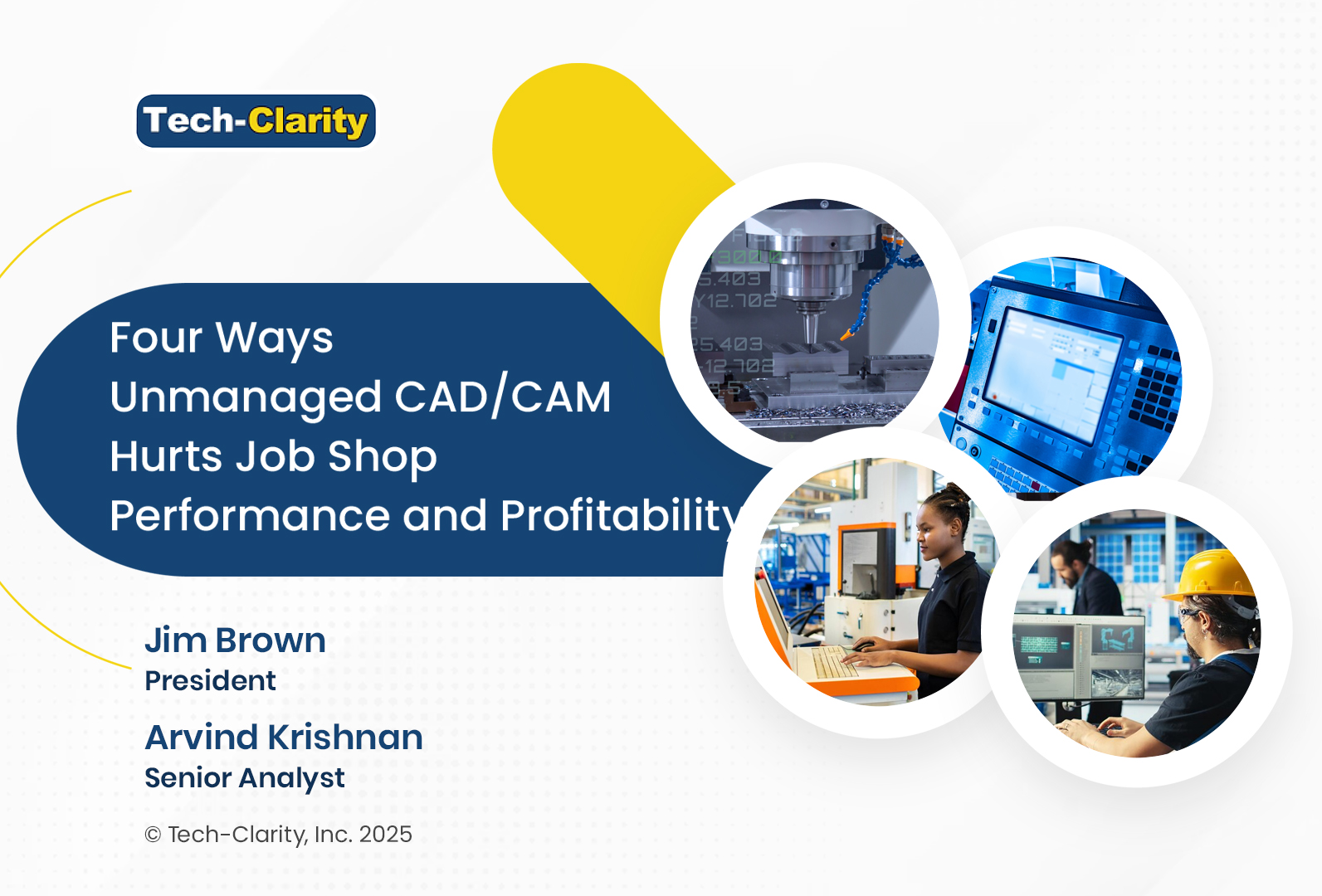 Why is managing CAD/CAM important to job shops? How does poor manufacturing data management negatively impact job shop performance and profits? More importantly, what lessons learned can they from managing product data to add control without burdening already busy resources?
Read the full report here, or download the full PDF, courtesy of Siemens.
You can also learn more from Siemens Digital Industries Software here. Thank you Siemens for supporting our work and helping us educate manufacturers on the value of improving CAD/CAM data management.
Why is managing CAD/CAM important to job shops? How does poor manufacturing data management negatively impact job shop performance and profits? More importantly, what lessons learned can they from managing product data to add control without burdening already busy resources?
Read the full report here, or download the full PDF, courtesy of Siemens.
You can also learn more from Siemens Digital Industries Software here. Thank you Siemens for supporting our work and helping us educate manufacturers on the value of improving CAD/CAM data management.
Table of Contents
- CAD/CAM Data Management is often Underappreciated
- Manufacturing is Data Intensive
- Unmanaged CAD/CAM Data Hurts Performance
- How to Improve Data Management
- 1 — Stop Wasting Time
- 2 — Eliminate Mistakes
- 3 — Estimate with Confidence
- 4 — Create a Compelling Customer Experience
- Prepare for the Future
- Control, Access, and Share with PDM
- Manage CAD/CAM Data without the Big Investment
- Acknowledgments
CAD/CAM Data Management is often Underappreciated
Agility is Crucial for Job Shops Job shops play a critical role in the manufacturing supply chain by producing low-volume, high-variety, or custom parts. These shops need to be fast, responsive, and efficient. Agility is essential whether the shop is prototyping or delivering production runs. However, speed can't come at the expense of the quality, cost, and customer relationships that drive profitability and repeat business. Job shops, whether internal departments or independent businesses, need to strive for operational excellence in all ways to be trusted partners. CAD/CAM Data Management is Essential Accessible, trusted data is a proven contributor to operational excellence, and job shops create a significant amount of manufacturing data to produce their customers' designs. Keeping this data in sync is critical, but job shop leaders typically don't want to slow down or add overhead to implement enablers like formal design and manufacturing data management. Our data, though, indicates that inadequate data management wastes time and impacts results. How can job shops adopt the basic data management capabilities they need to avoid the downfalls of unmanaged CAD and related manufacturing data? We explore four ways job shops can leverage the cloud to gain control and protect their customers' IP without adding counterproductive cost and overhead.Manufacturing is Data Intensive
Customer Design Data Needs Control Job shops receive a lot of engineering and PMI data from their customers. Customers typically send, at a minimum, the design intent for their orders. They may send this in a formal manufacturing package or more informal methods like compressed files, shared drives, and emails. This information, which may include job specs, quality standards, 3D CAD models, drawings, GD&T, and material specifications, must be securely stored and controlled so the right people can access it. Further, the shop has to manage design changes to ensure that they produce to the right final specs. Manufacturing Runs on Data Beyond design data received from customers, job shops create an even greater amount of data to order materials, create tooling, produce the items, and inspect them for quality. This data may include NC code, STL files, shop drawings, tool paths, cut sheets, fixture designs, inspection plans, and additional information needed to produce parts right the first time. This information is typically more varied and larger than the customer's original data. This is in addition to downstream production data that may be managed in systems like ERP, MES, or QMS if they are in place.Unmanaged CAD/CAM Data Hurts Performance
Linking Design and Manufacturing Data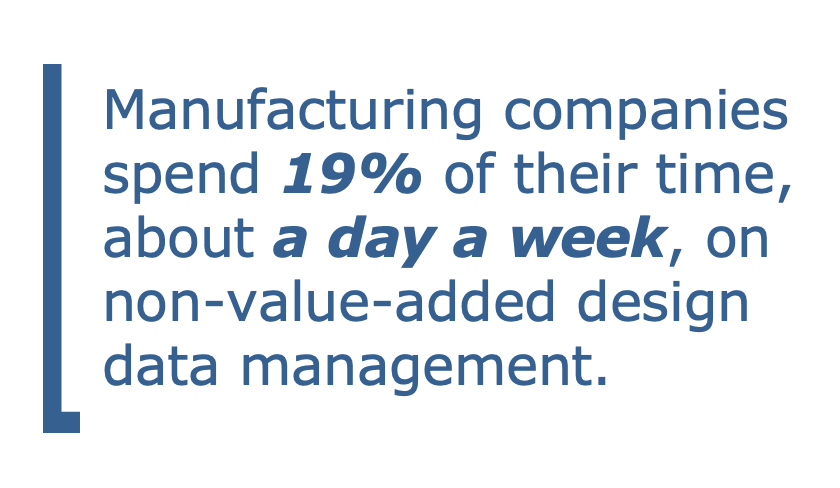 Design and production data are intrinsically related, and the data created by the shop should be managed in the context of the customer's CAD design. Unfortunately, job shops don't always manage this data and data relationships well because they don't want to be slowed down by cumbersome enterprise data management solutions. Some may not even have IT departments or the resources to implement formal data management solutions like PDM or PLM. This leads to disconnected data that is difficult to find and nearly impossible to manage as changes are received.
Unmanaged CAD/CAM Costs the Shop
Despite the challenges adopting data management, unmanaged CAD/CAM data causes frustration and reduces productivity. Our research on non-value-added time shares that technical resources only spend about one-half of their time on technical work on a typical project. They spend 19% of their time, about one day a week, on non-value-added (NVA) data management tasks such as finding information, working with the wrong data, recreating data, translating formats, and other common time wasters.1
Unmanaged CAD/CAM hurts a job shop's performance and profitability in four ways:
Design and production data are intrinsically related, and the data created by the shop should be managed in the context of the customer's CAD design. Unfortunately, job shops don't always manage this data and data relationships well because they don't want to be slowed down by cumbersome enterprise data management solutions. Some may not even have IT departments or the resources to implement formal data management solutions like PDM or PLM. This leads to disconnected data that is difficult to find and nearly impossible to manage as changes are received.
Unmanaged CAD/CAM Costs the Shop
Despite the challenges adopting data management, unmanaged CAD/CAM data causes frustration and reduces productivity. Our research on non-value-added time shares that technical resources only spend about one-half of their time on technical work on a typical project. They spend 19% of their time, about one day a week, on non-value-added (NVA) data management tasks such as finding information, working with the wrong data, recreating data, translating formats, and other common time wasters.1
Unmanaged CAD/CAM hurts a job shop's performance and profitability in four ways:
- Wasting time
- Causing mistakes
- Creating estimating / quoting challenges
- Delivering a poor customer experience
How to Improve Data Management
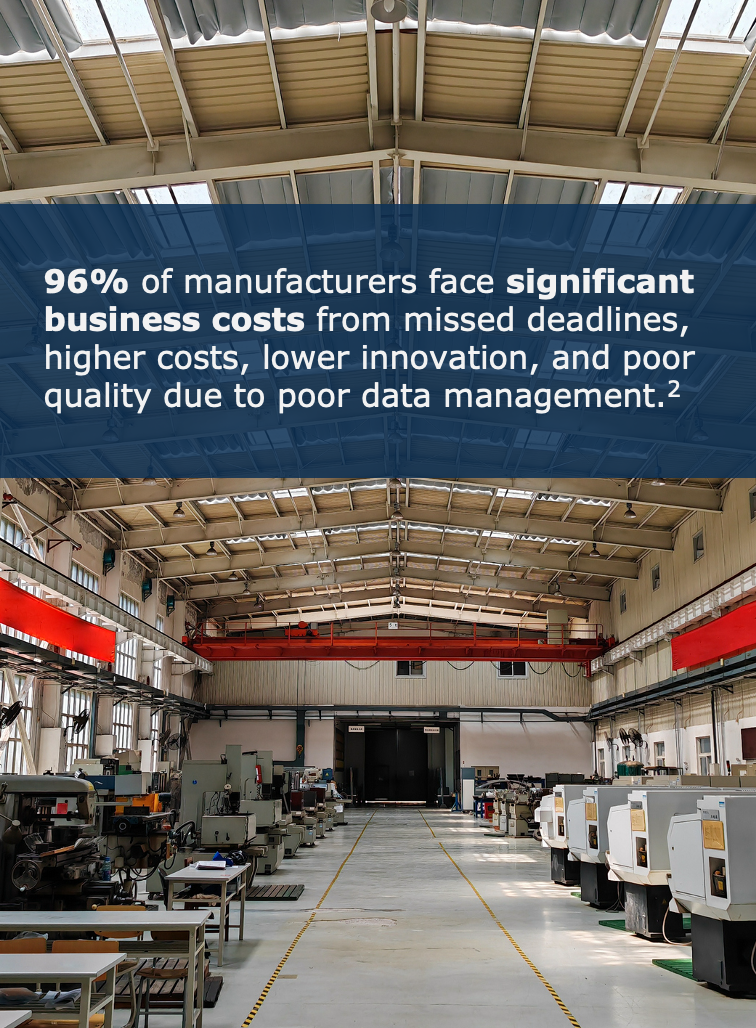 Four Ways to Improve
Now that we've discussed how poor data management negatively impacts job shops let's talk about how to fix it. Few job shop leaders would disagree that they should have effective control over their data, be able to reuse existing work, and capture learnings to continuously improve and avoid repeating mistakes. These factors are important to running an efficient, profitable shop. However, they can't always achieve the control they need over their CAD/CAM data because of the potential overhead of data management solutions.
In this eBook, we'll discuss four ways to increase profitability, performance, and customer satisfaction with minimal disruption and investment by taking a lightweight data management approach that manages CAD and related data like NC programs and CAM project files so they can:
Four Ways to Improve
Now that we've discussed how poor data management negatively impacts job shops let's talk about how to fix it. Few job shop leaders would disagree that they should have effective control over their data, be able to reuse existing work, and capture learnings to continuously improve and avoid repeating mistakes. These factors are important to running an efficient, profitable shop. However, they can't always achieve the control they need over their CAD/CAM data because of the potential overhead of data management solutions.
In this eBook, we'll discuss four ways to increase profitability, performance, and customer satisfaction with minimal disruption and investment by taking a lightweight data management approach that manages CAD and related data like NC programs and CAM project files so they can:
- Stop wasting time by effectively managing CAD/CAM and related manufacturing data
- Eliminate mistakes by improving collaboration and control
- Estimate accurately by using facts from prior projects
- Enrich customer experiences by building trust and confidence
1 – Stop Wasting Time
Unmanaged Data Wastes Time Let's step back to understand the problem. We've already shared that technical resources waste significant time due to unmanaged data. There are a number of ways this occurs. One of the most common is time lost searching for the appropriate data in different folders, on different computers, or on shared drives. Another significant inefficiency is taking the time to ask others for data or responding to data requests from others. Further, even if an engineer, CNC programmer, or operator finds what they are looking for, they are unsure if the data is correct or the latest revision. They still need to ask others for confirmation. Even worse is when CAD or manufacturing data gets lost, and people must recreate it from scratch or go back to the customer for it. All of these non-value-added activities waste precious time and resources. Control, Access, and Share Data
Tech-Clarity's research shows that engineering and manufacturing teams must put three key capabilities in place to reduce wasted, non-value-added work. These basic capabilities include effectively controlling, accessing, and sharing information (see details on page "Control, Access, and Share with PDM").
PDM is a critical enabler to centralize and manage CAD/CAM and other related manufacturing data. It's proven to enable job shops to control, access, and share information effectively. PDM centralizes data to limit the time wasted on non-value-added tasks. It ensures that data stays current and updated, so there is no need to question or recreate work. It also allows other technical resources to have easier access to needed CAD/CAM or other data in a self-service model so they don't have to interrupt others who have their own jobs to do. Lastly, without PDM, CAM and other manufacturing data are not managed, and it is likely recreated every time a job comes in, instead of reusing NC data when the CAD is the same revision or using the manufacturing as a starting point if only minor details have changed.
Control, Access, and Share Data
Tech-Clarity's research shows that engineering and manufacturing teams must put three key capabilities in place to reduce wasted, non-value-added work. These basic capabilities include effectively controlling, accessing, and sharing information (see details on page "Control, Access, and Share with PDM").
PDM is a critical enabler to centralize and manage CAD/CAM and other related manufacturing data. It's proven to enable job shops to control, access, and share information effectively. PDM centralizes data to limit the time wasted on non-value-added tasks. It ensures that data stays current and updated, so there is no need to question or recreate work. It also allows other technical resources to have easier access to needed CAD/CAM or other data in a self-service model so they don't have to interrupt others who have their own jobs to do. Lastly, without PDM, CAM and other manufacturing data are not managed, and it is likely recreated every time a job comes in, instead of reusing NC data when the CAD is the same revision or using the manufacturing as a starting point if only minor details have changed.
2 — Eliminate Mistakes
Mistakes Cost Time and Money Inefficiency is not the only way that job shops suffer from ineffective data management. Operational excellence relies on a trusted digital thread of data, starting with the customer's CAD designs and continuing through inspection. Poor CAD/CAM data and poor collaboration around it can lead to costly mistakes. For example, if the shop starts manufacturing planning using the wrong CAD revision to develop CAM toolpaths or uses the wrong CAM data to manufacture, they must rework and/or deal with scrap. At a minimum, they have to rework manufacturing plans. But they can miss first-time quality goals if it's not caught before manufacturing. Of course, the worst scenario is when quality issues due to incorrect CAD/CAM data lead to part quality problems that leave the shop and get rejected by the customer. This situation compromises the job shop's reputation and hurts customer relationships. Improve Collaboration For effective collaboration within a shop and between a job shop and their customers, it must be easy for everyone involved to collaborate easily and effectively. All related data should be available and easily accessible in one place, not lost in emails or in unmanaged shared folders. Everybody should be able to securely access what they need, securely, in a format they can understand and use for their work. People should only see what they need based on security and release status, and changes must be tracked to make it easy to see the latest information. Effectively collaborating on a single source of information also improves reviews and DfM (design for manufacturability) processes so the shop can proactively identify and report potential issues to provide early feedback regarding manufacturability and cost. Improved 3D collaboration with customers' engineering teams sets the conditions for companies to "shift left" to improve the value of the shop to the customer.3 — Estimate with Confidence
Poor Information Leads to Poor Estimates Poor data management issues are not limited to the shop, they can also impact the front office. For example, effective estimates and quotes, whether for internal or external purposes, have enormous consequences. First, it's important to develop quotes quickly. Slow quote response time can result in lost business opportunities. But speed alone is not sufficient. Inaccurate or low-confidence estimates hurt the business in other ways. Either the quote is too low and the shop loses money, or the shop inflates quotes to compensate for low confidence in the estimates and the shop misses business opportunities. Guide Quotes with Facts Quick access to past projects with all the associated data can help job shops quote accurately and maintain margins without reinventing the wheel each time a quote is needed. If data management extends beyond technical data, estimators can leverage past quotes and actual outcomes to see the results of similar jobs. In addition, shops can access related manufacturing data in context with the 3D CAD model and associated manufacturing data. If the shop can easily retrieve data such as the equipment/machines used, quality defects, actual cost of production, tooling cost, and manufacturing time, they can develop quotes with confidence. Connecting CAD/CAM data with manufacturing information allows estimators to guide estimates and quotes with facts to rapidly develop accurate quotes that lead to more business, create higher customer confidence, and protect budgets or margins.4 – Create a Compelling Customer Experience
Lack of Control Reflects Poorly on the Job Shop As we've discussed, poor CAD/CAM data management can lead to internal problems, including outdated revisions and miscommunication that result in costly rework, quality leaks, and production delays. It may also prevent them from meaningfully participating in continuous improvement exercises with customers. These issues indirectly impact the job shop's customers, whether they are part of the same company or independent entities. Beyond that, poor CAD/CAM data management practices put customers' engineering data at risk of being accidentally shared. Inefficient CAD/CAM data management does more than just waste resources. It also signals a lack of discipline and organizational excellence to customers that can potentially jeopardize future business opportunities. These issues can tarnish the shop's reputation, erode customer trust, and raise doubts about the firm's competence. Build Customer Trust and Confidence The ability for a job shop to manage CAD, CAM, and other manufacturing data, along with industrial-grade data security, proves it can comply with the requirements that its customers expect. Effective data management makes it easy for the shop to feel they have a reliable partner and are confident their IP is safe. It can also help them demonstrate compliance with industry standards to improve their marketability and qualify for more projects. Finally, improving customer experience by increasing data management maturity leads to more repeat business and new customers through referrals.Prepare for the Future
Don’t Get Left Behind We discussed four ways that managing CAD/CAM data helps the business, and we'll add a fifth about how it creates a foundation for even greater benefits. For example, everyone is talking about how AI has the potential to change work as we know it. As a progressive job shop, you may already be using AI to analyze complex manufacturing data to optimize machining parameters, tool paths, and cutting conditions in CAM software. Effective CAD/CAM data management sets the stage for AI to leverage that data in novel ways. For example, AI could help job shops quickly and accurately estimate and generate quotes based on prior project data.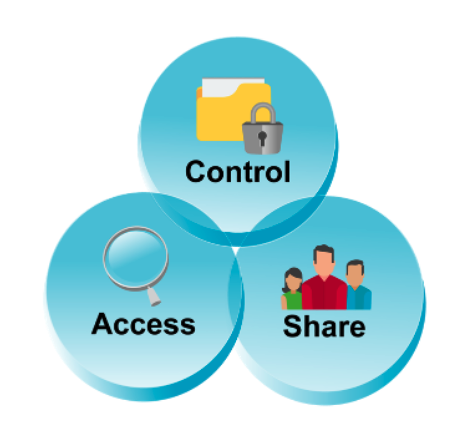 Beyond internal value, customers may be more inclined to work with tech-savvy partners who can deliver more data and data-driven insights. Customers may value this information to train their own AI or improve their design process. On the other hand, job shops that are not leveraging AI have the potential to be perceived as outdated or less capable. Beyond AI, better managing CAD/CAM data sets the foundation for broader PLM capabilities. Our data shows that PDM / PLM improves operational control leading to reduced cost and higher profitability. However, the most important step is to get started by controlling, accessing, and sharing CAD/CAM data with PDM.
Build a Foundation for Future Value
Effective CAD/CAM data management is a core capability that drives agility and operational excellence internally. It also sets the stage for higher value and positive customer perception. One thing is sure, if AI does become a necessity, companies will want to have their CAD and manufacturing data in order so that AI can learn from it and leverage it. And if customers begin demanding PDM or PLM capabilities, you will have the foundation in place to support them. Mature CAD/CAM data management prepares the shop to answer questions about what they're doing about AI and PLM – internally and externally.
Beyond internal value, customers may be more inclined to work with tech-savvy partners who can deliver more data and data-driven insights. Customers may value this information to train their own AI or improve their design process. On the other hand, job shops that are not leveraging AI have the potential to be perceived as outdated or less capable. Beyond AI, better managing CAD/CAM data sets the foundation for broader PLM capabilities. Our data shows that PDM / PLM improves operational control leading to reduced cost and higher profitability. However, the most important step is to get started by controlling, accessing, and sharing CAD/CAM data with PDM.
Build a Foundation for Future Value
Effective CAD/CAM data management is a core capability that drives agility and operational excellence internally. It also sets the stage for higher value and positive customer perception. One thing is sure, if AI does become a necessity, companies will want to have their CAD and manufacturing data in order so that AI can learn from it and leverage it. And if customers begin demanding PDM or PLM capabilities, you will have the foundation in place to support them. Mature CAD/CAM data management prepares the shop to answer questions about what they're doing about AI and PLM – internally and externally.
Control, Access, and Share with PDM
PDM Helps Drive Operational Excellence for Job Shops Before we wrap up, let's take a deeper look at how PDM supports job shops. Most manufacturers leverage PDM to control, access, and share engineering data. Job shops can leverage these same capabilities to store their customers' CAD data in context with the volumes of data they create to produce parts with quality. For a job shop, PDM offers:- Control supports managing CAD models, CAM files, and other engineering and manufacturing data through version control, standardized naming conventions, and revision histories. It ensures that data is not lost, overwritten, or corrupted, changes are tracked, previous versions can be retrieved, and everyone works from the latest approved information. It also includes managing related data, such as manufacturing and inspection data, in context with designs for easy access and to make sure changes are reflected downstream.
-
Access allows retrieval of information needed by others and defines who can view or modify data, including CAD/CAM files. By setting permissions and user roles, organizations can provide efficient access to information, allowing engineers and operators to quickly find design and manufacturing data so they can update or reuse it while restricting modifications to authorized personnel and protecting the integrity and confidentiality of their customers' design data.
-
Share enables distributing CAD/CAM data among team members, departments, or external collaborators. It enables collaboration and ensures all users work with consistent, up-to-date files.
Manage CAD/CAM Data without the Big Investment
 Put the Basics in Place
Job shops need to control, access, and share their CAD/CAM and related manufacturing data in context in order to drive agility and operational excellence, but it does not have to be burdensome and require deep IT resources. Job shops that are concerned about the overhead of managing CAD/CAM should consider a lightweight data management solution that keeps all data in a centralized location, contextualizes it, protects it, and allows people to securely collaborate on it. Today, job shops can implement basic PDM capabilities by taking a simpler, less burdensome approach. At the same time, they can leverage a solution that can scale with their needs over time.
Leverage the Cloud
Job shops looking for a lightweight PDM data management solution to manage CAD/CAM data should look to the cloud. Cloud solutions are more accessible than ever. They offer a low-cost option and reduce adoption barriers for small job shops. The path doesn't have to be burdensome. An overwhelming 78% of respondents who characterized their PLM implementation as 'Easy' had deployed a cloud-based solution compared to only 15% with onsite implementations.
Additionally, cloud solutions make it easier to securely collaborate with customers, both internally and externally. In fact, our research shows that the cloud provides value in several different ways:
Put the Basics in Place
Job shops need to control, access, and share their CAD/CAM and related manufacturing data in context in order to drive agility and operational excellence, but it does not have to be burdensome and require deep IT resources. Job shops that are concerned about the overhead of managing CAD/CAM should consider a lightweight data management solution that keeps all data in a centralized location, contextualizes it, protects it, and allows people to securely collaborate on it. Today, job shops can implement basic PDM capabilities by taking a simpler, less burdensome approach. At the same time, they can leverage a solution that can scale with their needs over time.
Leverage the Cloud
Job shops looking for a lightweight PDM data management solution to manage CAD/CAM data should look to the cloud. Cloud solutions are more accessible than ever. They offer a low-cost option and reduce adoption barriers for small job shops. The path doesn't have to be burdensome. An overwhelming 78% of respondents who characterized their PLM implementation as 'Easy' had deployed a cloud-based solution compared to only 15% with onsite implementations.
Additionally, cloud solutions make it easier to securely collaborate with customers, both internally and externally. In fact, our research shows that the cloud provides value in several different ways:
- System implementation, leading to lower risk and barriers to entry
- System operation / usage, allowing better data control, access, and sharing
- IT factors, such as better performance, security, and scalability
- Business / strategic benefits, including supporting future value from AI
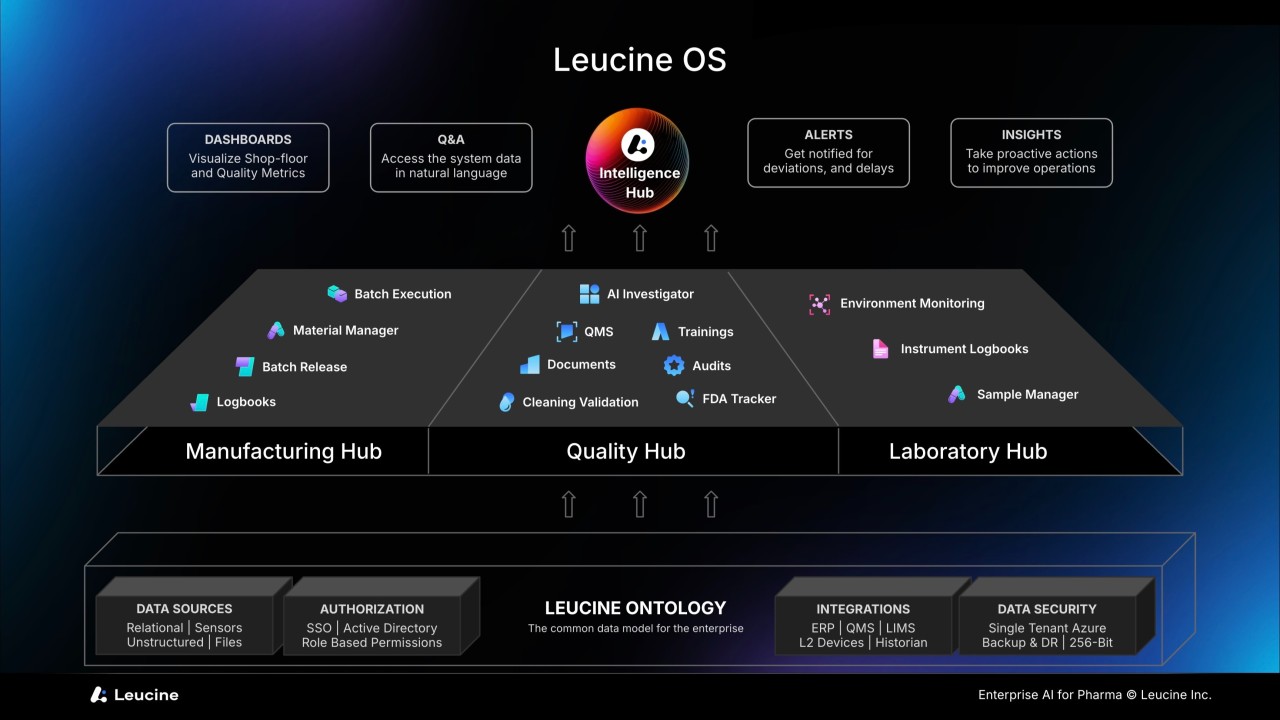
What do pharmaceutical manufacturers most need? To be compliant with government regulations without wasting time and effort. Leucine set out to deliver that with its SaaS software suite, which includes hubs for Manufacturing, Quality, and, most recently, Laboratory, with Intelligence (including AI) serving it all. The company launched in 2019 and joined forces with Ecolab to sell in the US and Europe in 2022. In late 2023, Ecolab, an established cleaning and contamination control provider in the pharmaceutical industry with a digital arm, invested in Leucine.
Software Scope
Leucine is determined to stay focused on manufacturing and quality software for pharmaceutical companies. They aim to help customers achieve two goals:
- Being FDA compliant
- Complying efficiently
That may sound straightforward. Yet, as they point out, most processes are inherently multidisciplinary, so the Leucine suite includes functions for manufacturing, quality, and quality lab activities. On top of the specific functional hubs sits the Intelligence Hub for dashboards, natural language Q&A based on GenAI, alerts, and insights. The Cortex Command Center includes GenAI for goal-based analytics and is typically used by process engineers, production supervisors and operational excellence professionals. Beneath is a common platform to ensure data is shared and in full context across all disciplines.
Manufacturing Hub
In the Manufacturing Hub, where our briefing focused, Leucine’s MES includes:
- Pre-assembled batch recipes with built-in compliance that go all the way to drug-modality specific unit operations such as dispensing, granulation, fermentation and filtration, with weigh and dispense connected via OCR
- Compliant batch execution with over 300 process interlocks and over 1,000 data validations, guided tasks and flows, automated deviation alerts, and escalations to support compliance by design
- WIP material management with two-way reconciliation between ERP and MES, with QR and bar code scanning for lower inventory costs
- Integrated logbooks with automatic time stamps, and not just basics for equipment, but all logs needed for a fully compliant eBR in a cleanroom environment, including cleaning, environmental, and calibration interlocks
Any of these elements can be the starting point for a customer, and as they add functional elements, they seamlessly integrate with in-context data from the ontology. They assert that both data and context are dynamic and took on the challenge of that path to evolution and growth, as well as openness and connectivity.
The MES is designed for operators to have minimal friction. It includes hands-free voice-guided workflows, IoT-connected Andon light integration for process-ready signals, and proactive voice and visual alerts. This includes task timers and audible and visible escalation cues.

Keys to Compliant Software Agility
SaaS, with 99.9% uptime plus ongoing upgrades and security capabilities that the cloud offers, is just the start for agility and data flow. This platform has SOC 2 Type 2 Certified data security for privacy, availability, and security. Both Leucine and Ecolab have specialized expertise in FDA-ready audits, software validation and 21 CFR Part 11.
The platform streamlines connecting to varied data sources. It includes enterprise connectors with OPC-UA and SQL, APIs to QMS and LIMS, RFC and FTP to level 2 systems such as data historians, and OPC-UA or MQTT for analytical balances, plus the native logbooks in the system.
From the company’s inception, they developed a Leucine Ontology or single data model for the enterprise. This ontology has a semantic understanding of the objects involved in pharma manufacturing and quality. Increasingly, we find that an ontology is crucial to effective deployment, integration, and long-term value from manufacturing software.
One thing that stood out to us is the company’s inclusion of an FDA Tracker. This tool keeps up to date with the definition of compliance as it changes. Of course, the analytics intelligence hub and Cortex also support continuous improvement and agility.
Strong Partners
Leucine is a US registered company and has already signed up a strong customer base worldwide since its inception six years ago. It claims over 350 GMP sites and nearly 50 pharmaceutical enterprise customers.
Ecolab brings 30 years of digital innovation, 1,400 employees in the digital group, 100,000 connected sites across 40 industries, 1,000,000 connected devices, and over 120 billion data points go through the Ecolab cloud platform every year.
We think Leucine was brilliant to bring in a strong partner as its channel to market. Ecolab has been making its mark in pharmaceuticals for years, and the decontamination and cleaning processes are a clear part of compliant manufacturing and quality.
Thank you to Leucine co-founder and CEO Vivek Gera, plus Ecolab’s Michael Cates, William Goodman, and Sarah Otterstetter for briefing Rick Franzosa and Julie Fraser on this modern approach to pharmaceutical industry production, quality, and compliance.
[post_title] => Leucine Pharma MES for Efficient Compliance Grows with Ecolab [post_excerpt] => [post_status] => publish [comment_status] => open [ping_status] => open [post_password] => [post_name] => mes-for-efficient-compliance [to_ping] => [pinged] => [post_modified] => 2025-10-02 23:00:05 [post_modified_gmt] => 2025-10-03 03:00:05 [post_content_filtered] => [post_parent] => 0 [guid] => https://tech-clarity.com/?p=22989 [menu_order] => 0 [post_type] => post [post_mime_type] => [comment_count] => 0 [filter] => raw ) [10] => WP_Post Object ( [ID] => 22980 [post_author] => 2574 [post_date] => 2025-09-25 22:49:28 [post_date_gmt] => 2025-09-26 02:49:28 [post_content] =>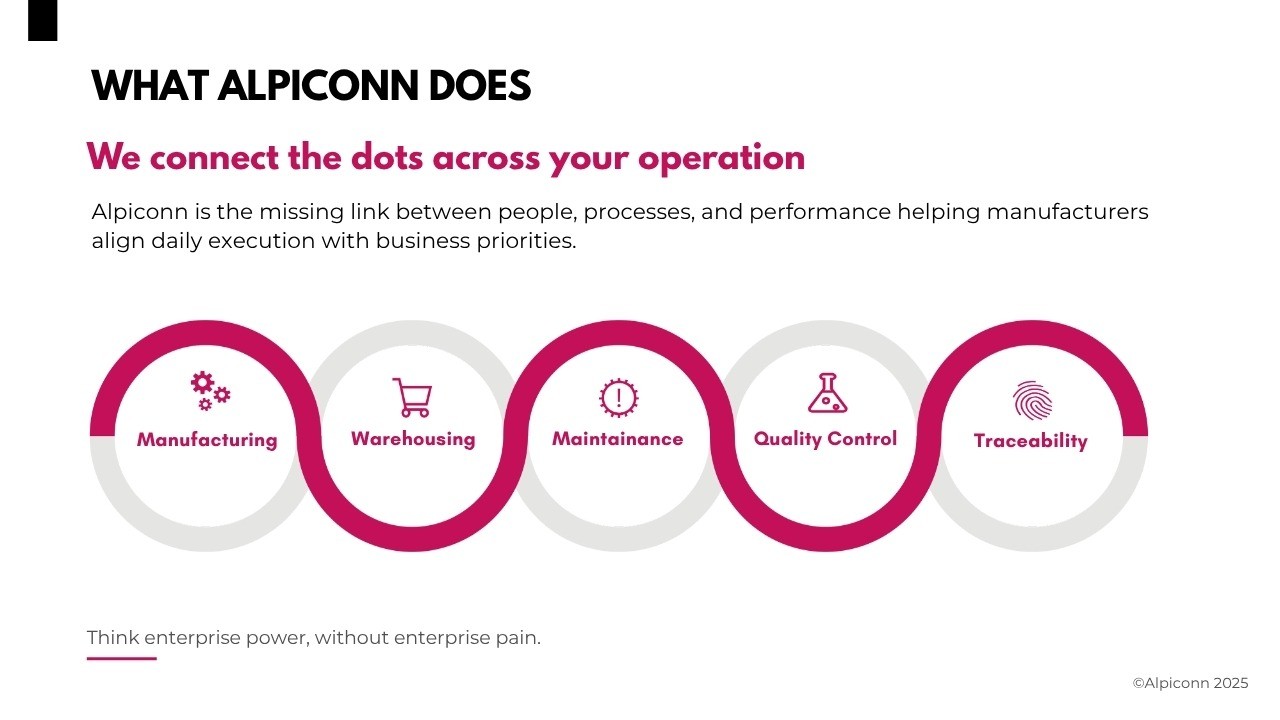
How can small and mid-size businesses (SMBs) - specifically manufacturers and warehouses - gain an operations digital thread that connects from materials movement through production and quality? Ideally, with well-integrated, easy-to-deploy software. Alpiconn has been delivering a combination of MES, WMS, CMMS, QMS, and traceability for the past decade. By focusing on practicality, flexibility, and depth, this company has served various companies from its headquarters in Athens, Greece. They are now ready to expand into the rest of Europe.
Breadth for Digital Continuity
Alpiconn enables a digital thread from production to quality to traceability, including the warehouse. The company started in 2008 and was rebranded as Alpiconn in 2014, so it has been building for over a decade. The Plantecho digital operations management system has four major components: MES, WMS, QC, and CMMS. From the beginning, the company’s vision was based on ISA-95. It includes all major elements of the Purdue Model’s Level 3 for seamless data flows. This end-to-end functionality is designed for small and midsize manufacturers to adopt as a digital transformation accelerator.
Plantecho is also hardware and ERP agnostic, aiming to integrate with existing systems. Minimizing the integration headache can accelerate value and enable smaller companies to adopt such a comprehensive software suite. Plantecho is designed to be a unified system that orchestrates all operations. They believe their job is to connect people, data, and processes in a way that turns complexity into clarity and sound decisions. The company has won numerous Greek awards for software, IoT, science in business, and services over the years, and seems to have loyal customers.

SMB Focused
To serve small and mid-size businesses (SMBs), Alpiconn says this system can go live in weeks, not quarters or years. They have also focused on making the system easy to use.
Alpiconn’s focus on smaller companies began to make advanced industrial technologies accessible and practical for companies that may not have the IT capacity or know-how to implement them on their own. By doing so, Alpiconn helps modernize and elevate SME operations by applying best practices and proven tools..
They have deployed Plantecho across a wide range of industries, including chemicals, aluminum and other construction materials, as well as food and beverages of many types. The foundational structures can work with any industry due to the ISA-95 basis.
However, Plantecho can serve larger multi-plant enterprises. Its multi-tenant (not cloud) approach can support multiple plants and partners. Customers have started small and grown, some using the system for over 10 years. Customer growth has also driven new capabilities and functionality in the software.
Another key factor is that Alpiconn is a turnkey provider. They enter into long-term partnerships with customers, delivering software, services, and hardware. They tend to become trusted advisors, helping customers model and optimize their business, both initially and as things change. Alpiconn also provides ongoing consulting and support services tailored to each customer’s evolving operational needs.

Beyond Basics
In addition to the broad Plantecho digital operations management system, Alpiconn offers Flexus, a low-code, event-based data and process automation platform. Customers can use Flexus to build custom workflows and business logic to respond to situations. This flexible tool has been used to develop:
- Alerts to the workforce when they should take action
- Machine control to prevent failure or quality issues
- Trigger ERP actions to pay a supplier or bill a customer based on material movement or weighing
- Access control and monitoring for a site for deliveries or pickups
Through technology partners, Alpiconn also offers connected industrial labelling from Loftware and AR-powered indoor navigation and guidance from Insider Navigation. Alpiconn is also an Independent Software Vendor (ISV) and Machine Vision partner of Zebra Technologies, integrating industrial-grade scanning, coding, labeling, and vision solutions into its systems for full visibility and control across shop floor operations. Alpiconn also has integration partners for more complex or specialized projects, such as robotic warehouses.
Looking Forward
The software is already available in English, and the company plans to expand more aggressively into the rest of Europe soon. Alpiconn regularly introduces major releases of Plantecho that include improvements and new features. It is exploring working with companies; this is logical, given its background in chemicals and regulated food and beverage.
AI is on the roadmap, but Alpiconn management is being conservative, ensuring they introduce AI solutions that address specific customer problems. SMBs typically balk at new technology that does not deliver clear business value.
Thank you, Theodore Papadopoulos and Athina Fysekidou, for explaining Alpiconn’s business and offerings to us. We look forward to following your expansion into the rest of Europe.
[post_title] => Alpiconn Ready to Deliver SMB Operations Software Beyond Greece [post_excerpt] => [post_status] => publish [comment_status] => open [ping_status] => open [post_password] => [post_name] => smb-operations-software [to_ping] => [pinged] => [post_modified] => 2025-10-02 23:00:42 [post_modified_gmt] => 2025-10-03 03:00:42 [post_content_filtered] => [post_parent] => 0 [guid] => https://tech-clarity.com/?p=22980 [menu_order] => 0 [post_type] => post [post_mime_type] => [comment_count] => 0 [filter] => raw ) [11] => WP_Post Object ( [ID] => 22900 [post_author] => 2572 [post_date] => 2025-09-25 11:10:44 [post_date_gmt] => 2025-09-25 15:10:44 [post_content] =>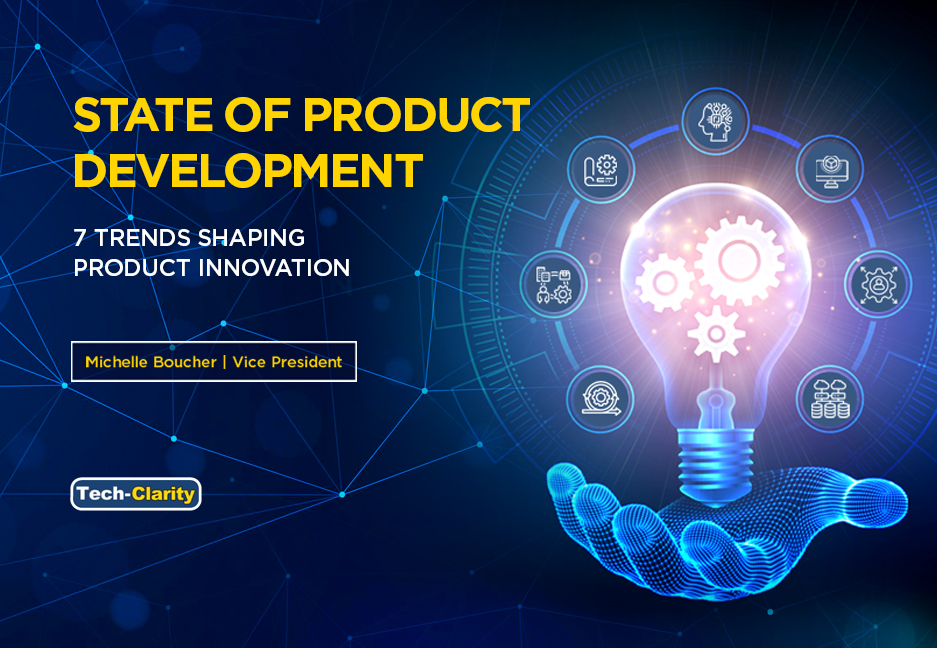 Is your approach to product development helping you compete or holding you back?
Product development teams today face growing pressure to respond to market volatility, supply chain disruptions, and global competition. At the same time, they’re dealing with long-standing challenges like manual inefficiencies, poor collaboration, disconnected systems, and workforce shortages. These issues cause costly delays, especially during engineering-to-manufacturing hand-offs. In the past, these inefficiencies were tolerated. But today’s market demands more agility, and the tools to support it are finally available. Advances in digitalization, simulation, and AI are helping teams move faster and smarter. These issues are shaping product development.
The research identifies seven trends that are reshaping product development as companies confront this new reality. Top Performers are leading the way in adapting to these trends to gain a competitive edge. What are they doing differently, and what can others learn?
This study is based on a survey of 233 professionals involved in product development across design, engineering, and manufacturing roles. The findings reveal the biggest challenges teams face today, the trends driving change, and the strategic moves Top Performers are making to reduce risk, accelerate innovation, and deliver better products faster.
Please enjoy the summary* below. For the full research, please visit our sponsor Dassault Systèmes SOLIDWORKS (registration required).
Is your approach to product development helping you compete or holding you back?
Product development teams today face growing pressure to respond to market volatility, supply chain disruptions, and global competition. At the same time, they’re dealing with long-standing challenges like manual inefficiencies, poor collaboration, disconnected systems, and workforce shortages. These issues cause costly delays, especially during engineering-to-manufacturing hand-offs. In the past, these inefficiencies were tolerated. But today’s market demands more agility, and the tools to support it are finally available. Advances in digitalization, simulation, and AI are helping teams move faster and smarter. These issues are shaping product development.
The research identifies seven trends that are reshaping product development as companies confront this new reality. Top Performers are leading the way in adapting to these trends to gain a competitive edge. What are they doing differently, and what can others learn?
This study is based on a survey of 233 professionals involved in product development across design, engineering, and manufacturing roles. The findings reveal the biggest challenges teams face today, the trends driving change, and the strategic moves Top Performers are making to reduce risk, accelerate innovation, and deliver better products faster.
Please enjoy the summary* below. For the full research, please visit our sponsor Dassault Systèmes SOLIDWORKS (registration required).
Table of Contents
- Executive Summary
- Why Product Development is Under Pressure
- Top Challenges Facing Product Development
- Identifying Top Performers
- 1. Rebuilding Supply Chain
- 2. Connecting Design-to-Manufacturing
- 3. Embracing AI in Product Development
- 4. Expanding Simulation
- 5. Addressing Talent Shortages
- 6. Unifying Tools Through Integrated Product Development Platforms
- 7. Adopting Agile Strategies
- Recommendations
- About the Research
- Acknowledgments
Executive Summary
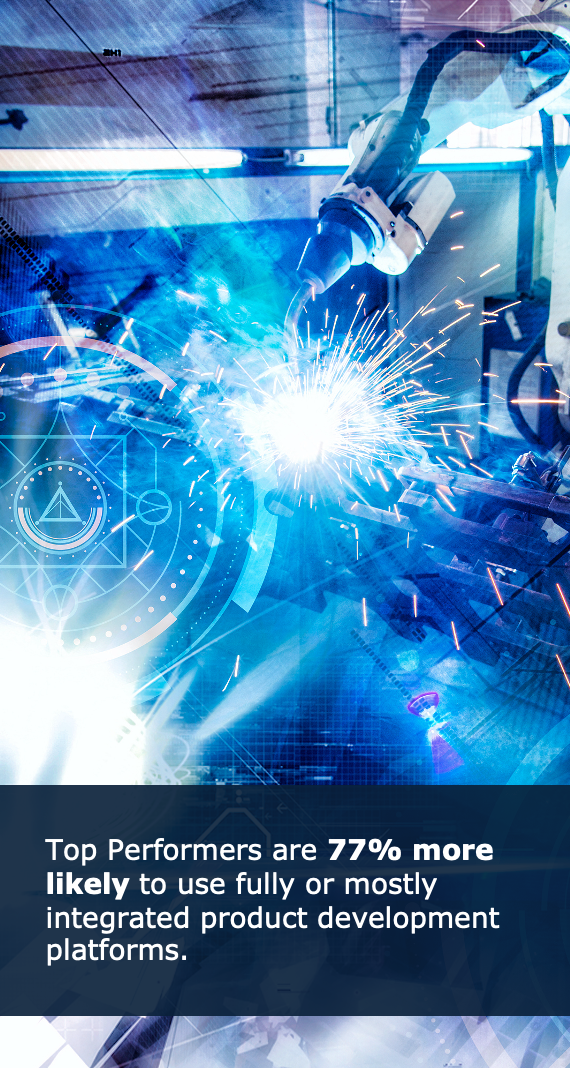 State of Product Development
Product development continues to face an era defined by growing complexity, shrinking margins for error, and accelerating market demands. This is exacerbated as companies are under increasingly pressure not only from traditional competitors, but also from nimble startups, vertically integrated disruptors, and offshore manufacturers. At the same time, they must manage ongoing supply chain volatility, shifting customer expectations, and a growing need for smarter, more connected products.
To remain competitive, companies must design faster, adapt to change more easily, and eliminate costly inefficiencies. Yet many are still burdened by manual tasks, disconnected tools, and poor collaboration, especially between engineering and manufacturing. These challenges are not just frustrating for employees; they lead to missed deadlines, higher costs, and compromised quality. In fact, 78% of respondents report increased manufacturing and development costs due to product development challenges.
Key Findings
Top Performers, companies that consistently meet or exceed product development goals, are leading the way. Compared to Others, they are:
State of Product Development
Product development continues to face an era defined by growing complexity, shrinking margins for error, and accelerating market demands. This is exacerbated as companies are under increasingly pressure not only from traditional competitors, but also from nimble startups, vertically integrated disruptors, and offshore manufacturers. At the same time, they must manage ongoing supply chain volatility, shifting customer expectations, and a growing need for smarter, more connected products.
To remain competitive, companies must design faster, adapt to change more easily, and eliminate costly inefficiencies. Yet many are still burdened by manual tasks, disconnected tools, and poor collaboration, especially between engineering and manufacturing. These challenges are not just frustrating for employees; they lead to missed deadlines, higher costs, and compromised quality. In fact, 78% of respondents report increased manufacturing and development costs due to product development challenges.
Key Findings
Top Performers, companies that consistently meet or exceed product development goals, are leading the way. Compared to Others, they are:
- 77% more likely to use fully or mostly integrated product development platforms
- Nearly two times more likely to be using AI in development
- Significantly more likely to involve design engineers in simulation and to support supplier collaboration with real-time data
Why Product Development Is Under Pressure
Today's Market Product development has always been complex, but many companies are feeling more pressure than ever before. They are navigating a perfect storm of disruption, driven by market shifts, increasing technical complexity, and organizational misalignment. As a result, engineering and manufacturing teams must achieve more with less time, fewer resources, and greater risk. A New Wave of Competition Adding to the pressure, competition is coming from all directions. In addition to long-standing rivals, companies now face other sources of competition (see graph). With competition intensifying, businesses must move faster and differentiate through innovation, product performance, quality, and customer experience. As competition arises from various fronts, companies need to work harder to set themselves apart. Strong product development is essential for achieving that differentiation. How to Respond Given these challenges, companies should evaluate the top obstacles facing product development teams and address them to empower them to deliver effectively. While many operate under the belief of "if it ain't broke, don't fix it," they may underestimate how much these common challenges can harm the business. Thankfully, technological advancements have created new opportunities to overcome these challenges and develop efficiencies that can enhance a company's competitiveness.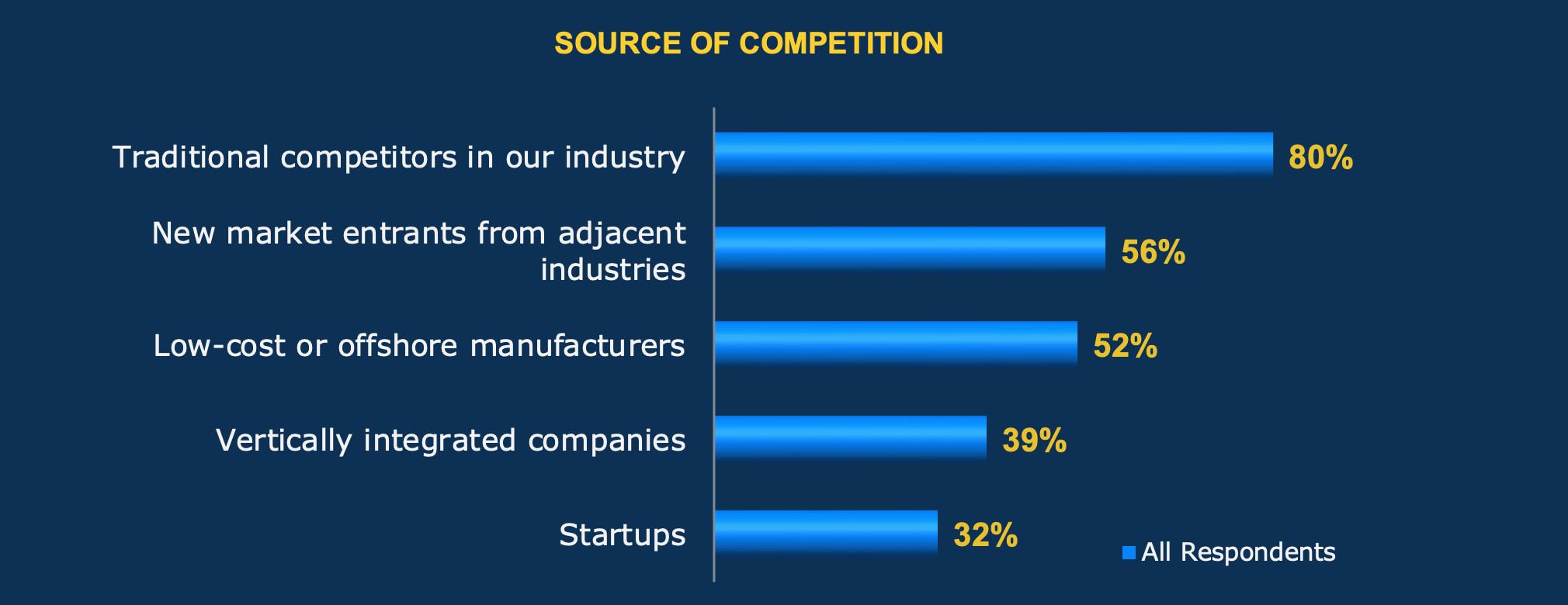
Identifying Top Performers
How Top Performers Were Defined To define Top Performers, Tech-Clarity identified the top 25% of companies that outperform their competitors in metrics that indicate product development success. These metrics are the ability to:- Develop products efficiently
- Design high-quality products
- Develop innovative products
- Meet product cost targets
- Meet release deadlines
Recommendations and Next Steps
Based on industry experience and research for this report, Tech-Clarity offers the following recommendations for product development teams:- Integrate disconnected tools: Consolidate design, engineering, and manufacturing systems into a unified platform to reduce errors, rework, and delays. Top Performers are 77% more likely than Others to use a fully or mostly integrated product development solution.
- Eliminate manual tasks: Automate repetitive, low-value work to boost productivity and allow engineers to focus on innovation. Overall, 61% of respondents cite manual tasks as the most demotivating part of their job, prompting 48% of Top Performers to implement a strategy to automate manual tasks.
- Strengthen design-to-manufacturing collaboration: Align teams with shared, real-time data to improve communication and reduce costly hand-off errors. Sixty-five percent cite miscommunication between design and manufacturing as a top cause of delays, and 73% of Top Performers have strategies to align engineering and manufacturing.
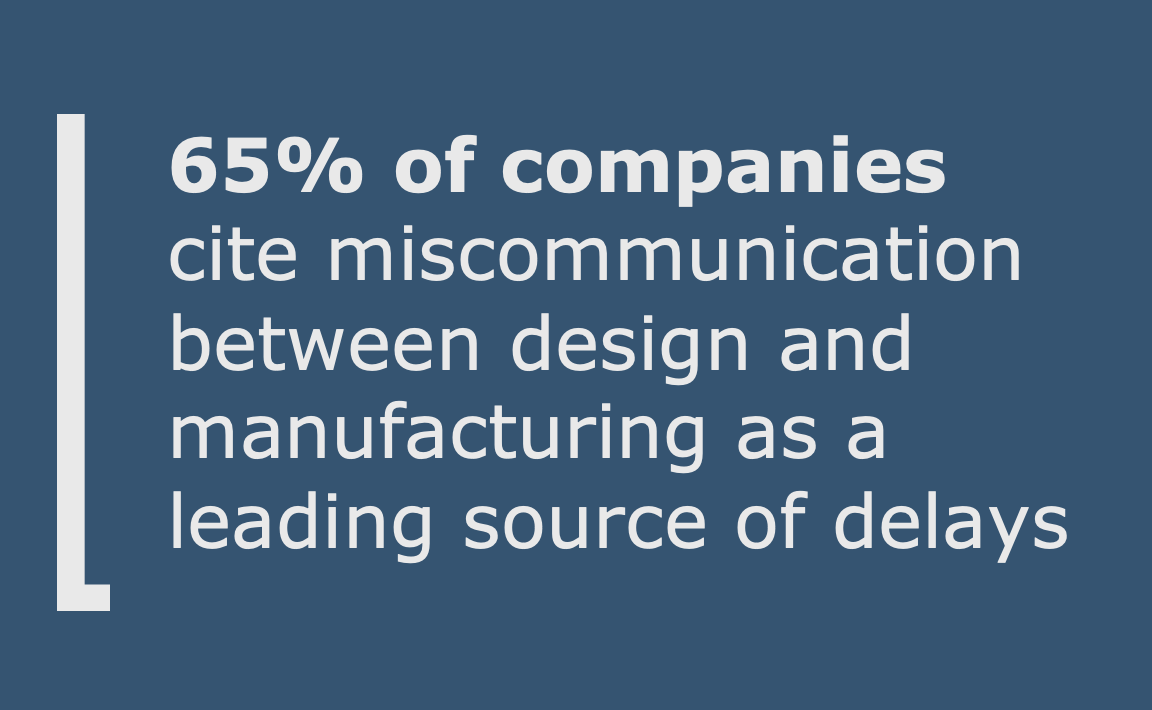 Expand simulation usage: Use simulation earlier and across more roles to cut physical prototyping, identify issues sooner, and improve design quality. Seventy-four percent of Top Performers use simulation to optimize performance.
Expand simulation usage: Use simulation earlier and across more roles to cut physical prototyping, identify issues sooner, and improve design quality. Seventy-four percent of Top Performers use simulation to optimize performance.- Embrace AI and automation: Invest in AI tools, especially generative AI, to accelerate ideation, improve accuracy, and reduce manual workflows. Top Performers are nearly twice as likely as Others to use AI during development already.
- Prepare for workforce shifts: Make engineering and manufacturing roles more rewarding by reducing frustration with manual tasks, recognizing contributions, and offering growth opportunities tailored to generational preferences. Forty-eight percent say hiring and retaining technical talent is a top challenge, making it critical to keep existing staff motivated.
- Support supplier collaboration: Share real-time data with local suppliers to reduce miscommunications, rework, and delays. This will help you adapt to supply chain shifts and nearshoring trends. Respondents say supplier collaboration issues add 30% more time to their development cycles. Avoiding these issues will improve productivity.
 How can MedTech companies accelerate digital transformation?
On Thursday, October 23 at 10:00 am EDT, please join Tech-Clarity’s Michelle Boucher for an interactive discussion with Christian Vogelei of Fresenius Medical Care and René Zoelfl of PTC as they discuss this.
They will explore topics like:
How can MedTech companies accelerate digital transformation?
On Thursday, October 23 at 10:00 am EDT, please join Tech-Clarity’s Michelle Boucher for an interactive discussion with Christian Vogelei of Fresenius Medical Care and René Zoelfl of PTC as they discuss this.
They will explore topics like:
- Why MedTech companies should consider digital transformation
- The benefit MedTech companies can realize by supporting a digital thread
- Practical advice to achieve digital transformation
 [post_title] => Accelerating MedTech Transformation
[post_excerpt] =>
[post_status] => publish
[comment_status] => open
[ping_status] => open
[post_password] =>
[post_name] => medtech-transformation
[to_ping] =>
[pinged] =>
[post_modified] => 2025-09-25 09:41:42
[post_modified_gmt] => 2025-09-25 13:41:42
[post_content_filtered] =>
[post_parent] => 0
[guid] => https://tech-clarity.com/?p=22878
[menu_order] => 0
[post_type] => post
[post_mime_type] =>
[comment_count] => 0
[filter] => raw
)
[13] => WP_Post Object
(
[ID] => 22853
[post_author] => 2572
[post_date] => 2025-09-23 10:35:49
[post_date_gmt] => 2025-09-23 14:35:49
[post_content] => How
[post_title] => Accelerating MedTech Transformation
[post_excerpt] =>
[post_status] => publish
[comment_status] => open
[ping_status] => open
[post_password] =>
[post_name] => medtech-transformation
[to_ping] =>
[pinged] =>
[post_modified] => 2025-09-25 09:41:42
[post_modified_gmt] => 2025-09-25 13:41:42
[post_content_filtered] =>
[post_parent] => 0
[guid] => https://tech-clarity.com/?p=22878
[menu_order] => 0
[post_type] => post
[post_mime_type] =>
[comment_count] => 0
[filter] => raw
)
[13] => WP_Post Object
(
[ID] => 22853
[post_author] => 2572
[post_date] => 2025-09-23 10:35:49
[post_date_gmt] => 2025-09-23 14:35:49
[post_content] => How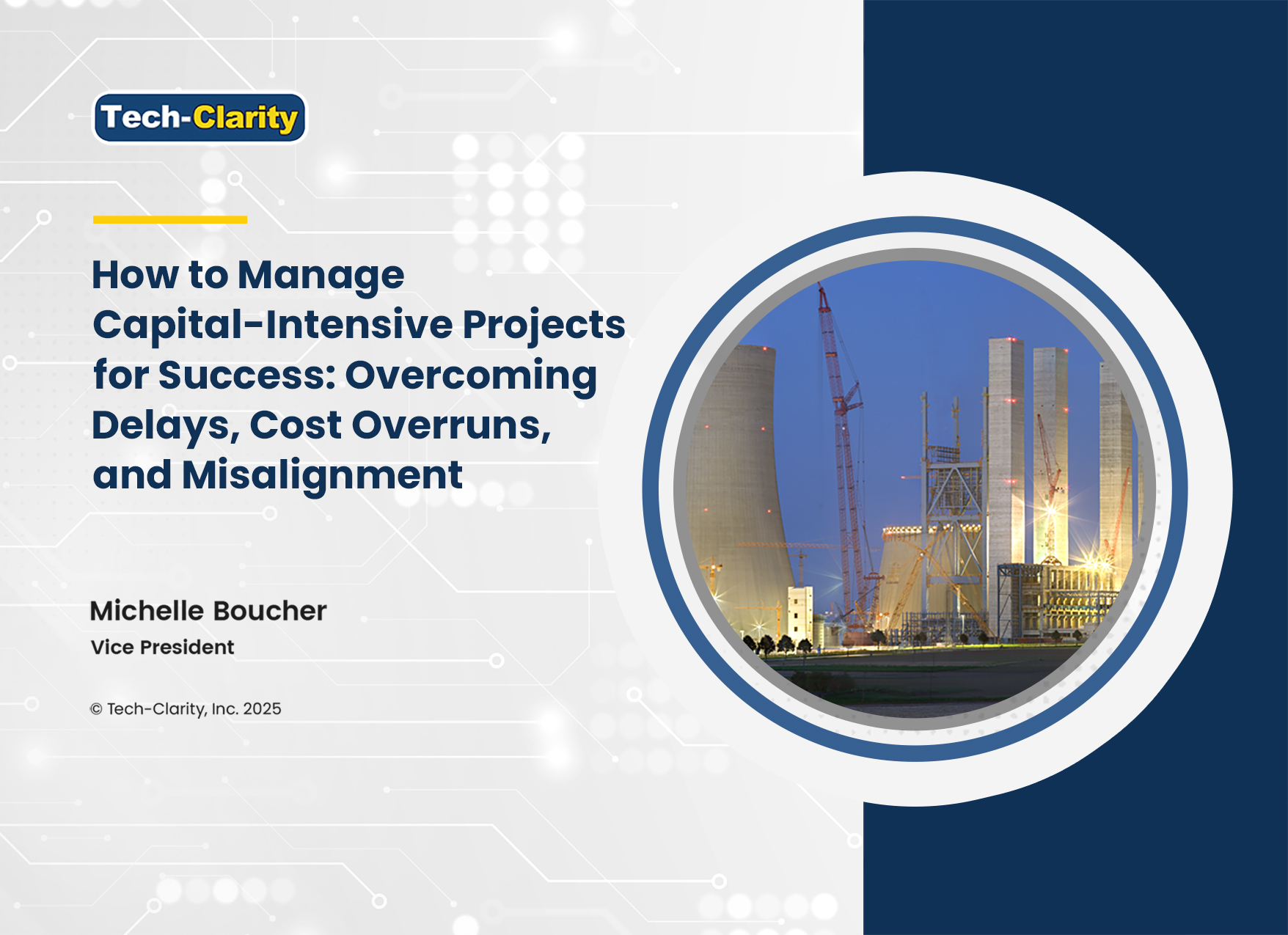 can companies managing capital-intensive projects, such as factories, nuclear facilities, offshore platforms, rail infrastructure, and data centers, avoid delays and cost overruns? What leads to successful projects?
Significant growth is expected in the number of capital-intensive projects over the next few years. However, many of these projects will face delays, cost overruns, and execution inefficiencies. In today's climate of economic volatility, labor shortages, and complex regulations, the pressure to complete projects on time and within budget has never been higher. Still, some companies consistently outperform their competitors. What are they doing differently?
This research study explores project management strategies using a survey of 201 professionals working on capital-intensive projects. The study identifies the primary challenges companies face when managing these projects, including the underlying causes of delays and cost overruns. The findings highlight three key strategies that Top Performers use to manage risk, enhance predictability, and achieve better outcomes in today’s most complex and high-stakes projects.
Please enjoy the summary* below. For the full research, please visit our sponsor, Dassault Systèmes (registration required).
can companies managing capital-intensive projects, such as factories, nuclear facilities, offshore platforms, rail infrastructure, and data centers, avoid delays and cost overruns? What leads to successful projects?
Significant growth is expected in the number of capital-intensive projects over the next few years. However, many of these projects will face delays, cost overruns, and execution inefficiencies. In today's climate of economic volatility, labor shortages, and complex regulations, the pressure to complete projects on time and within budget has never been higher. Still, some companies consistently outperform their competitors. What are they doing differently?
This research study explores project management strategies using a survey of 201 professionals working on capital-intensive projects. The study identifies the primary challenges companies face when managing these projects, including the underlying causes of delays and cost overruns. The findings highlight three key strategies that Top Performers use to manage risk, enhance predictability, and achieve better outcomes in today’s most complex and high-stakes projects.
Please enjoy the summary* below. For the full research, please visit our sponsor, Dassault Systèmes (registration required).
Table of Contents
- Executive Summary
- Investment Drivers
- Business Challenges Undermining Success
- Identifying Top Performers
- Strategies for Capital-Intensive Projects
- Improved Collaboration
- Adopt a Digitalization Strategy
- Establish a Single Source of Truth
- A Single Integrated Platform
- Conclusion
- Recommendations
- About the Research
- Acknowledgments
Executive Summary
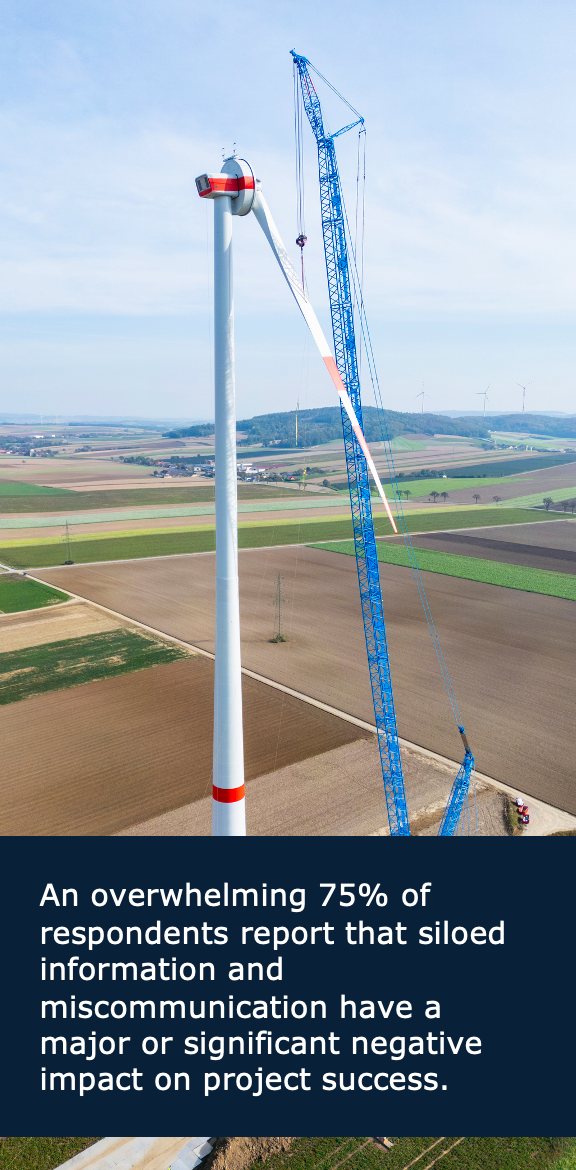 Capital-Intensive Project Challenges
Capital-intensive projects represent some of the most complex and costly initiatives a business can undertake. As global economic volatility, supply chain disruption, skilled labor shortages, and other uncertainties continue to intensify, organizations must figure out how to deliver these on time, more predictably, and with greater financial control.
The research reveals that while there is a strong need for these capital-intensive projects, their execution continues to be hindered by outdated processes, fragmented tools, and collaboration breakdowns. An overwhelming 75% of respondents report that siloed information and miscommunication have a major or significant negative impact on project success.
Overcoming Challenges
To overcome these challenges, skilled labor shortages, and financial risk, companies are investing in capabilities to improve project predictability, increase on-time completion, strengthen regulatory compliance, and become more agile in response to market shifts.
Best Practices
The research revealed three strategies that Top Performers, the most successful companies, implement to manage capital-intensive projects more effectively:
Capital-Intensive Project Challenges
Capital-intensive projects represent some of the most complex and costly initiatives a business can undertake. As global economic volatility, supply chain disruption, skilled labor shortages, and other uncertainties continue to intensify, organizations must figure out how to deliver these on time, more predictably, and with greater financial control.
The research reveals that while there is a strong need for these capital-intensive projects, their execution continues to be hindered by outdated processes, fragmented tools, and collaboration breakdowns. An overwhelming 75% of respondents report that siloed information and miscommunication have a major or significant negative impact on project success.
Overcoming Challenges
To overcome these challenges, skilled labor shortages, and financial risk, companies are investing in capabilities to improve project predictability, increase on-time completion, strengthen regulatory compliance, and become more agile in response to market shifts.
Best Practices
The research revealed three strategies that Top Performers, the most successful companies, implement to manage capital-intensive projects more effectively:
- Improve collaboration
- Adopt a digitalization strategy
- Establish a single source of truth
- Reduce cost overruns
- Improve on-time completion
- Support regulatory compliance
- Become more agile
Business Challenges Undermining Success
Overcome Challenges In addition to meeting business goals, companies also need to address the core challenges that hinder capital-intensive project success. These issues (see graph) should be prioritized when investing in project management. Skilled Worker Shortage The shortage of skilled workers is a significant challenge. Companies struggle to fill positions like engineering, construction, and project management, particularly as experienced professionals retire following the COVID pandemic. This talent gap means:- Slower project execution
- More errors and rework
- Difficulty transferring institutional knowledge
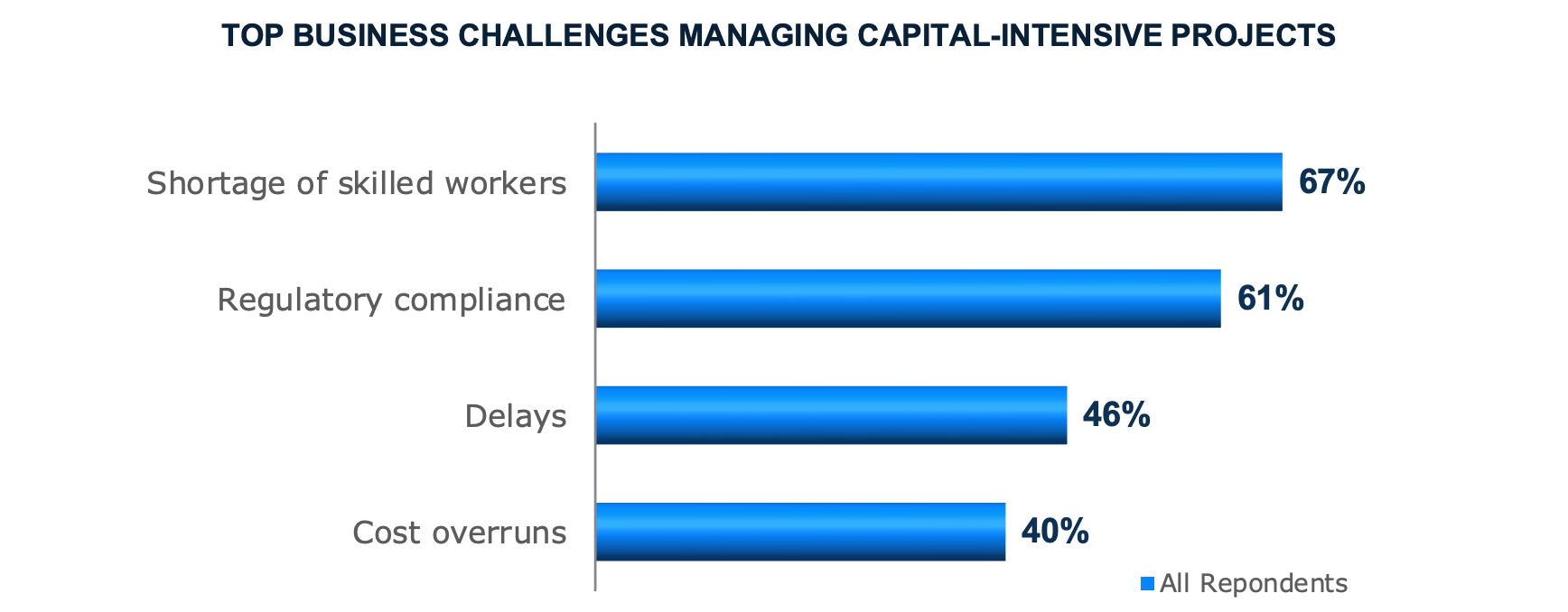 Regulatory Compliance
Evolving regulations, especially in energy, infrastructure, and life sciences, often cause delays and rework. Teams must monitor changes, document compliance, and respond to audits. Yet fragmented tools and siloed data make this a time-consuming, manual task.
Without accurate, traceable data, it’s difficult to:
Regulatory Compliance
Evolving regulations, especially in energy, infrastructure, and life sciences, often cause delays and rework. Teams must monitor changes, document compliance, and respond to audits. Yet fragmented tools and siloed data make this a time-consuming, manual task.
Without accurate, traceable data, it’s difficult to:
- Proactively identify compliance risks
- Respond quickly to changing regulations
- Demonstrate compliance during audits
Establish a Single Source of Truth
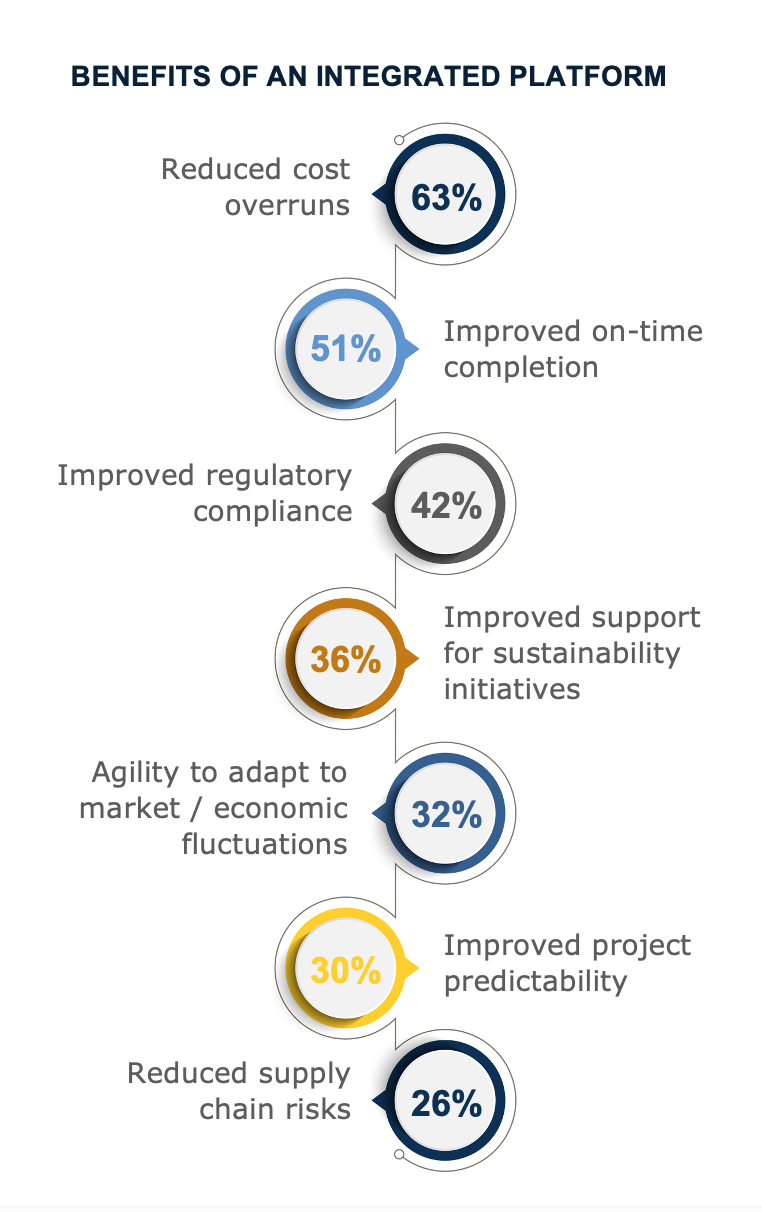 Too Many Disconnected Tools
Establishing a single source of truth is the most common strategy among Top Performers for improving capital-intensive project performance. This creates a centralized repository of project data accessible to all stakeholders. While most companies recognize the value of this approach, many struggle to implement it. Respondents report widespread reliance on multiple disconnected tools, creating fragmented data environments that hinder coordination, transparency, and decision making.
On average, respondents use 7.5 standalone tools to manage project data, with 46% relying on more than eight. These include spreadsheets and general tools for managing projects, collaboration, scheduling, supply chains, risk, costing, and more.
While each tool may be well-suited for its task, many disconnected solutions make it extremely difficult to get a consolidated view of project information. Respondents report spending an average of 4.8 hours preparing for a single status meeting, while 33% say it takes six or more hours just to gather needed information.
Another issue is that data stored in multiple locations can easily become outdated or conflicting, eroding trust in its accuracy. Team members then waste time searching for and validating data.
An Integrated Platform
These challenges are driving a strong preference for integrated solutions over many disconnected, best-of-breed tools. An overwhelming 85% realize significant benefits with an integrated platform. By consolidating data and workflows, companies can reduce the risk of errors, rework, and delays while increasing transparency for executives and stakeholders. This leads to improved data accuracy, faster decision making, clear audit trails, and more optimized resource allocation. Together, these advantages translate into measurable business value (see graphic).
Too Many Disconnected Tools
Establishing a single source of truth is the most common strategy among Top Performers for improving capital-intensive project performance. This creates a centralized repository of project data accessible to all stakeholders. While most companies recognize the value of this approach, many struggle to implement it. Respondents report widespread reliance on multiple disconnected tools, creating fragmented data environments that hinder coordination, transparency, and decision making.
On average, respondents use 7.5 standalone tools to manage project data, with 46% relying on more than eight. These include spreadsheets and general tools for managing projects, collaboration, scheduling, supply chains, risk, costing, and more.
While each tool may be well-suited for its task, many disconnected solutions make it extremely difficult to get a consolidated view of project information. Respondents report spending an average of 4.8 hours preparing for a single status meeting, while 33% say it takes six or more hours just to gather needed information.
Another issue is that data stored in multiple locations can easily become outdated or conflicting, eroding trust in its accuracy. Team members then waste time searching for and validating data.
An Integrated Platform
These challenges are driving a strong preference for integrated solutions over many disconnected, best-of-breed tools. An overwhelming 85% realize significant benefits with an integrated platform. By consolidating data and workflows, companies can reduce the risk of errors, rework, and delays while increasing transparency for executives and stakeholders. This leads to improved data accuracy, faster decision making, clear audit trails, and more optimized resource allocation. Together, these advantages translate into measurable business value (see graphic).
Conclusion
Addressing Capital-Intensive Project Complexity Capital-intensive projects are inherently complex, risky, and high-stakes. However, they also contribute to long-term business growth, improve societal infrastructure, and promote greater sustainability. This should drive many opportunities for these projects in the coming years. From gigafactories and wind farms to airports and life science facilities, these projects play a crucial role in shaping the future. Despite their importance, many struggle with delays, cost overruns, and collaboration breakdowns, often due to fragmented systems and outdated processes. Companies that successfully overcome these challenges will be well-positioned to execute projects on time and on budget, thereby establishing a strong reputation and gaining a competitive advantage for securing future contracts or increasing profitability. Top Performing Approach Our research shows that Top Performers share common strategies. They are actively transforming how they manage projects by adopting collaborative practices, establishing a single source of truth, and supporting digitalization, all enabled by an integrated platform. Rather than relying on disparate tools, Top Performers are transitioning to unified systems that offer real-time visibility, facilitate better decision making, and enhance productivity across teams, particularly through advanced capabilities such as AI-driven analytics. *This summary is an abbreviated version of the ebook and does not contain the full content. For the full research, please visit our sponsor, Dassault Systèmes.
If you have difficulty obtaining a copy of the research, please contact us.
[post_title] => How to Manage Capital-Intensive Projects
[post_excerpt] =>
[post_status] => publish
[comment_status] => open
[ping_status] => open
[post_password] =>
[post_name] => capital-intensive-projects
[to_ping] =>
[pinged] =>
[post_modified] => 2025-09-23 11:45:33
[post_modified_gmt] => 2025-09-23 15:45:33
[post_content_filtered] =>
[post_parent] => 0
[guid] => https://tech-clarity.com/?p=22853
[menu_order] => 0
[post_type] => post
[post_mime_type] =>
[comment_count] => 0
[filter] => raw
)
[14] => WP_Post Object
(
[ID] => 22971
[post_author] => 2581
[post_date] => 2025-09-22 22:39:21
[post_date_gmt] => 2025-09-23 02:39:21
[post_content] =>
*This summary is an abbreviated version of the ebook and does not contain the full content. For the full research, please visit our sponsor, Dassault Systèmes.
If you have difficulty obtaining a copy of the research, please contact us.
[post_title] => How to Manage Capital-Intensive Projects
[post_excerpt] =>
[post_status] => publish
[comment_status] => open
[ping_status] => open
[post_password] =>
[post_name] => capital-intensive-projects
[to_ping] =>
[pinged] =>
[post_modified] => 2025-09-23 11:45:33
[post_modified_gmt] => 2025-09-23 15:45:33
[post_content_filtered] =>
[post_parent] => 0
[guid] => https://tech-clarity.com/?p=22853
[menu_order] => 0
[post_type] => post
[post_mime_type] =>
[comment_count] => 0
[filter] => raw
)
[14] => WP_Post Object
(
[ID] => 22971
[post_author] => 2581
[post_date] => 2025-09-22 22:39:21
[post_date_gmt] => 2025-09-23 02:39:21
[post_content] => 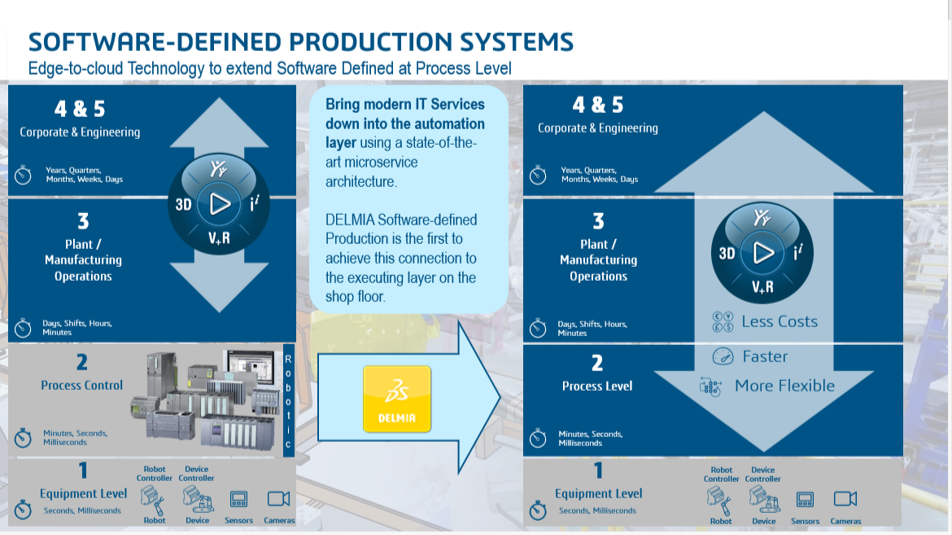
Can manufacturers gain an effective digital twin capability spanning from product concept to supply chain, production process, production execution, factory automation, and controls? Dassault Systèmes believes it can deliver that today. Their UNIV+RSES vision expanded deep into the plant floor with their July acquisition of Ascon’s Qube technology and team. This new edge-to-cloud platform complements the other rich elements of DELMIA’s digital manufacturing and manufacturing operations management software offering.
Dipping into Virtual Automation
This recent technology acquisition extends Dassault Systèmes' capabilities to replicate the real world in virtual form, all the way into equipment controls and automation. Dassault Systèmes has an extensive software portfolio to create digital twins of reality. The company grew initially as a product design and development leader, and the DELMIA brand has long focused on production and supply chain operations connecting the virtual and real worlds.
With the addition of Ascon technology, DELMIA aims to deliver software-defined production systems to improve highly automated manufacturing environments. Not just modeling, but replacing, vendor-specific programming of programmable logic controllers (PLCs) at level 2 of the Purdue model, would be a breakthrough. Challenges at the automation layer are many and cause huge costs and inefficiencies for large, highly automated manufacturers.
Vendor lock-in at the automation layer with proprietary hardware, software, and data formats is nearly universal. Initiatives like the Open Process Automation Forum (OPAF) are striving to break the lock; adding this virtual approach could accelerate the progress. Due to the low level of interoperability, the real-time data from these OT systems often cannot be easily accessed by the plant IT systems, such as MES. This harms decision-making speed and effectiveness. The DELMIA team rightly points out that automation setup is labor-intensive and often lacks efficiency and insights. This new technology will help alleviate these issues.

Based on early experience in automotive, DELMIA expects significant benefits for customers. Major areas include expanding transparency, improving agility to respond to changes on the shop floor, reducing line changeover and new product introduction time. They cite 30-50% reductions in line-level operating cost, changeover and downtime, to name a few.
Recipe Management and Tech Transfer
Batch process industries may be interested in the Virtual Twin of the Plant as a Service offering. In process industries, the production process determines the product, so this process twin is a foundation for quality, yield, costs and sustainability. Without the manufacturer needing to buy software, train people and create a digital twin of a plant, DELMIA will do it for them.
This process digital twin supports tech transfer in batch process industries as well. Moving from the R&D lab (where Dassault Systèmes’ BIOVIA brand is strong) to production typically presents significant challenges to optimize equipment, processes and people. As life sciences companies also create combination devices, R&D may encompass active ingredients, process development, hardware and software. All these ideally feed into a coherent package for tech transfer into scaled-up production.
And then there’s recipe management – not just developing, but managing recipes on an enterprise basis is an enormous challenge. Following the ISA88 transformation models is a start, but few have the software to enable those transformations from R&D formula to general recipe to site recipe to master recipe to control recipe. Using the 3DEXPERIENCE® platform on the cloud with an array of applications, DELMIA hopes to deliver improved efficiency and consistency to biopharma, pharmaceutical, and CPG customers.

Growth Across Industries
While the Ascon technology acquisition focuses on core complex discrete industries and the tech transfer and recipe management on batch industries, these are not DELMIA's full spectrum of customers. The DELMIA Apriso MES/MOM continues to win large multi-site deals across a wide array of industries.
They mentioned wins as a battery manufacturer, life sciences, metals and A&D companies. One was a win-back from another MES provider who got the first plant up but could not scale cost-effectively to other sites. The DELMIA Apriso multi-site advantage comes from a longstanding (at least 20 years) focus on enterprise deals and fine-tuning their rollout capabilities.
Looking Forward
Dassault Systèmes’ 3D UNIV+RSES vision focuses not only on modeling or simulating the real world but also on generating it. (See Jim Brown’s insight from the Dassault Systèmes analyst event for more on this concept.) Now, the ability to mirror and generate new products stretches from R&D through supply chain, manufacturing and digital automated controls.
Thank you, Eric Green, Michael Bradford, and Tom Muth, for the update briefing. We have watched the DELMIA portfolio grow, improve and be merged into the greater Dassault Systèmes solution set and we look forward to watching as more of the vision comes into reality.
[post_title] => Dassault Systèmes’ DELMIA Expands to Software-Defined Production, Tech Transfer, Recipes [post_excerpt] => [post_status] => publish [comment_status] => open [ping_status] => open [post_password] => [post_name] => delmia-software-defined-production [to_ping] => [pinged] => [post_modified] => 2025-10-02 22:39:54 [post_modified_gmt] => 2025-10-03 02:39:54 [post_content_filtered] => [post_parent] => 0 [guid] => https://tech-clarity.com/?p=22971 [menu_order] => 0 [post_type] => post [post_mime_type] => [comment_count] => 0 [filter] => raw ) [15] => WP_Post Object ( [ID] => 22956 [post_author] => 2581 [post_date] => 2025-09-18 23:58:31 [post_date_gmt] => 2025-09-19 03:58:31 [post_content] =>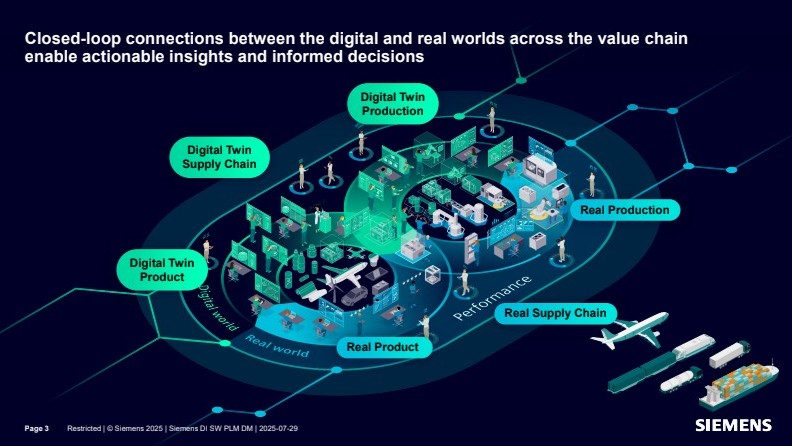
What if MES were fully natively integrated into an end-to-end suite across the product and production lifecycle? For years, industry analysts have remarked that Siemens had acquired all the pieces—if only they could put them together. We recently had a briefing that focused on the MES, Opcenter, and the progress made toward the end-to-end goal:
- Across all industrial markets (Discrete, Process, Hybrid, …)
- Everywhere in the industrial world
- Open to integrate with customers’ existing systems of record (ERP, etc.)
- Uniting: Design (Designcenter, Teamcenter, Dotmatics), Engineering (Simcenter, Tecnomatix), IT (Mendix, Rapidminer), production (Opcenter, Totally Integrated Automation Portal), IIoT (Insights Hub), Supply Chain (AX4, SupplyFrame), and Automation (Industrial Edge)
Siemens is moving toward this goal, leveraging capabilities such as their low-code application development environment (Mendix) and their Siemens Xcelerator digital business portfolio in conjunction with Opcenter. Another advantage is Siemens's 175+ year history as a manufacturer, including 200+ factories of its own today. A manufacturing environment that Siemens Digital Industries Software can leverage as an ‘in-house laboratory’ for testing and evaluating their software solutions, including AI innovations, as well as the automation hardware assets provided by Siemens Digital Industries.
The Opcenter X Journey

New this year is Opcenter X, combining MES, quality execution, scheduling, and LIMS on a new common cloud-native Opcenter platform.
The Opcenter brand was created in 2019 as an umbrella over several acquired/developed software products under the heading of MES/MOM. Initial development started with the user interface and data hub, allowing Siemens to market product sets for specific manufacturing industries. These early options used different underlying MES systems depending on the vertical industry.
In parallel, Siemens began the long and arduous process of creating a common platform, aided by some key technologies that they had available. The Opcenter Execution platform is moving rapidly from their two heritage MES products to a single modular, scalable, cloud native infrastructure with a lower TCO than traditional MES solutions.
We recall discussing the long-range plan with Siemens in 2023, where this migration from multiple applications to a single modular infrastructure was planned to be completed in 4 years. Now we are seeing the initial deliveries on this platform in 2025. Over the next two years, Siemens intends to deliver functionality for the remaining supported industries.
Focus on TCO, Configurability, and Scale

Companies, especially small and medium-sized manufacturers, need a more cost-compelling approach to MES. The total cost of ownership is more than the cost of the software. Other considerations include the time and expense of implementation, including configuration, training, and integration. Siemens has addressed these cost challenges in several ways:
- They have developed a new cloud-based common platform that supports individual applications, allowing customers to implement only what they need.
- They provide (driven by Mendix), low-code process and UI development based on customers’ business logic and individualized needs. Traditional MES implementations often cost more than double the cost of the software. Customers who leverage these tools can manage more of the deployment of the system in-house, choosing from 28 predefined templates, persona-based, industry-specific, and process-centric, that they claim have reduced implementation time and effort by 50 to 80%.
- They are committed to open connectivity, which eases integration with customers’ existing systems of record and reduces the time and effort required to build and maintain a digital thread.
- They are building closed-loop connections between product, production, supply chain planning, and execution.
Future Direction: Digital Thread, Service Lifecycle Maintenance, and AI

Siemens announced Teamcenter Service Lifecycle Management 2-3 years ago, and it is now becoming a cornerstone of their strategy for the Aerospace and Defense (A&D) market, while also serving multiple industries. As reported by Tech-Clarity in “Siemens Support for SLM Exceeded Our Expectations”, the combination of this SLM capability as part of the Siemens Xcelerator portfolio fills in key artifacts to the digital thread, enabling full lifecycle support from product design through services.
From an Opcenter perspective, they are betting on the assumption that service plan execution contains many fundamental similarities to production order execution. They are incorporating capabilities to build MRO into the Opcenter product as well. They are working with existing customers to capture the nuance required to provide an MRO solution for A&D, for example, planning is very different from using a Bill of Process (BOP) for production vs an MRO service plan, which involves not only quasi-production work, such as upgrading field-based equipment to the latest engineering changes, and scheduled maintenance, but also requires support for unplanned repairs.
The long-term key to SLM success is maintaining an unbroken digital thread between as-designed, as-planned, as-produced, and as-maintained for all product parts and assemblies. This is a tall order, though Siemens claims to be the only vendor that meets DoD needs for MBE to cover things like the overall flow from product design to execution regarding PMI and characteristics, as well as the flow back of that information. It will be interesting to see how meeting these requirements translates into actual success with DoD suppliers that have a lot of compartmentalized thinking and complex supply chains with varying levels of compliance and sophistication.
AI is the topic du jour across all of technology, and Siemens Digital Industries Software is no different (as reported by Tech-Clarity in “Siemens Realize LIVE 2025: A Vision for AI, Simulation, and Immersive Engineering in a Connected Digital Thread”). Siemens Opcenter is also adopting these capabilities. This involves Opcenter integration with Insights Hub (formerly Mindsphere). Insights Hub is dedicated to solving specific use cases and integrates with Opcenter to contextualize Opcenter data. Siemens, along with SIs and customers, uses Insights Hub with capabilities such as Copilot Studio to build their own queries and agentic AI.
In addition, they are collaborating with AI startups – Retrocausal, Cybord, Instrumental – on image recognition, defect detection, etc. They are also creating AI-infused applications with Mendix and its connectors. The UIs are based on Mendix so that they can embed AWS Bedrock, for example. A recipe copilot was created to compile documents, specifications, and other required artifacts from formulated designs for pharma and process industries in one recent case. Early customers have reported up to 3 months of productivity gain to get a drug to market.
Thank you Tobias Lange, Ignace Braem, and Shaun Ennis for this detailed and interesting briefing.
[post_title] => Siemens Opcenter's TCO and Scalability Help Fuel Digital Thread [post_excerpt] => [post_status] => publish [comment_status] => open [ping_status] => open [post_password] => [post_name] => siemens-opcenters-tco-and-scalability-help-fuel-digital-thread [to_ping] => [pinged] => [post_modified] => 2025-11-03 21:47:20 [post_modified_gmt] => 2025-11-04 02:47:20 [post_content_filtered] => [post_parent] => 0 [guid] => https://tech-clarity.com/?p=22956 [menu_order] => 0 [post_type] => post [post_mime_type] => [comment_count] => 0 [filter] => raw ) [16] => WP_Post Object ( [ID] => 22946 [post_author] => 2574 [post_date] => 2025-09-17 23:47:22 [post_date_gmt] => 2025-09-18 03:47:22 [post_content] =>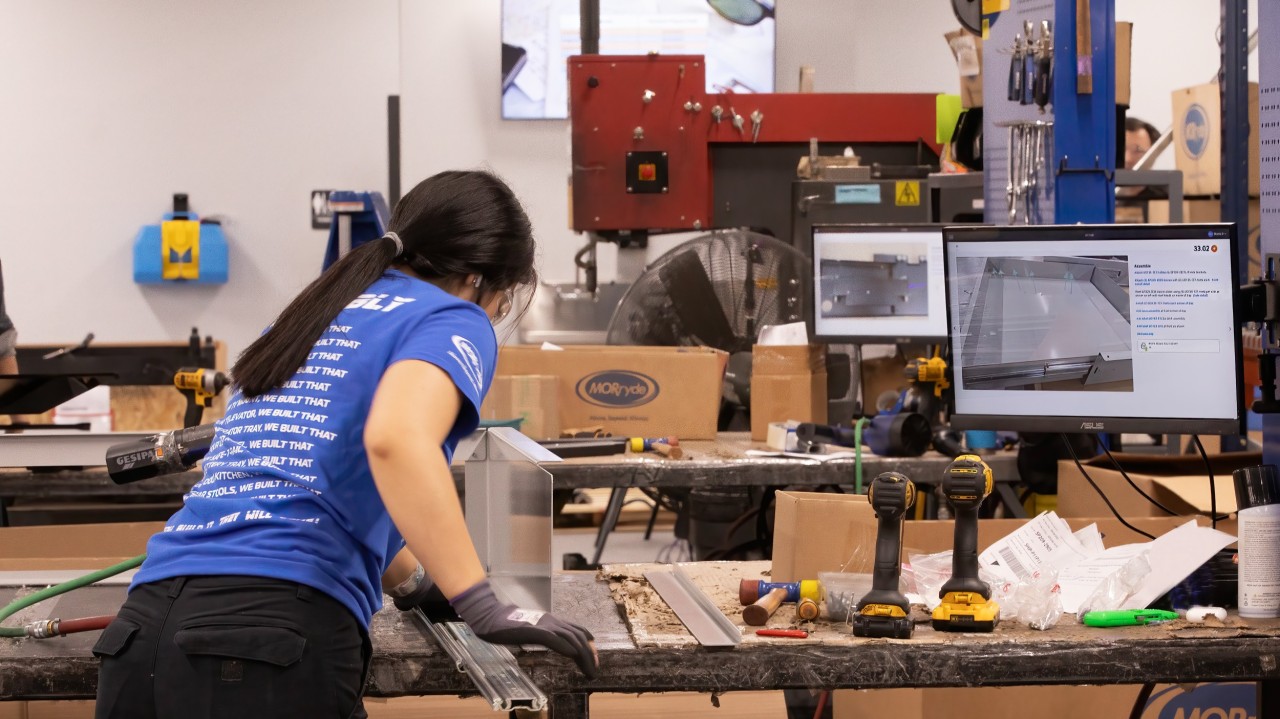
Can a discrete manufacturer get data from each tool, line, or piece of equipment into an MES and start using it in hours rather than weeks or months? PICO MES was founded to do that, and its Pico MES/IIoT software is now connected and in use at large, medium, and small manufacturers in automotive, aerospace, and other discrete industries.
Democratizing MES
Pico MES is unusual in the range of sizes of companies using it. Large OEMs with 100s of employees each shift use it, and very small companies with only a few dozen total employees are already using it, too. In 100-200-person automotive and aerospace suppliers, Pico MES can be the full plant floor technology stack. How Pico MES can scale from very small to huge stems from the architecture and the founders’ deep experience.
Telling a worker or machine what to do is central. Pico MES does this by authoring standard work, work instructions, and sequences. Process engineers do this easily using modern drag-and-drop workflows designed. The workflow builder is designed to handle both very simple and highly complex processes, such as nested assemblies. All data feeds into a unified model for context.
The resulting user interface works for both experienced and new workers. Using an opt-in strategy, the basics for anyone appear, and those needing more information can link to additional information or context, whether images or text.

Speedy Setup
Another element that helps Pico MES serve smaller companies is the speed and ease of connecting to equipment. Since many customers are high-volume, connecting to automation and equipment is crucial. Pico MES claims to have the most extensive library of no-code connections to assembly tools and machines on the market, with over 200 families pre-built. It is essentially a combination of MES with an IIoT platform.
Automation connections are quick and easy to set up. For example, to set up a torque tool, the manufacturer tells the software its IP address, name, header, configuration, how many of them they have, which one to use, where it is located, and whether it’s stationary or used at more than one station. Users can also add safety issues.
The system knows how to collect information and store it without coding. If it’s a new tool that’s never been used, it might take a while to get it connected to the network, but Pico MES says their side only takes five minutes. Based on what we saw, that seems feasible. They know how tools work and that logic works in the background without setup.
Pico MES also connects at the enterprise level to ERP and PLM, which is crucial as a best-of-breed software provider. With all its connectors and no-code workflows, this system can be the single information source for plant floor workers.

Speedy MES/IIoT Value
Part of the trick for achieving such rapid setup is that Pico MES is a hybrid deployment with a 3-edge architecture (station, factory, and cloud). This architecture with Pico MES running at the factory edge enhances security and resilience in the case of disconnection. The company also offers edge hardware. One edge Pico MES server per factory, plus as many Pico MES Hubs as needed, and the software can run effectively.
Pico MES automatically organizes and displays plant floor data in context. This is a foundation service of MES, but it often takes a long time to structure. In contrast, Pico MES’s unified data model does not need to be customized. Every system can grab all the data it needs from the model, which the founders’ expertise in both factory operations and software enabled them to build from the beginning.
Because of the fast setup, Pico MES offers instant improvement. Beyond the Hawthorne effect, when operators improve knowing they are observed, there’s also error-proofing. This is how they claim 10%-15% output improvements within the first 30 days of use. It also has built-in cycle time analytics to help understand where to focus on less stable processes.
Using Pico MES reduces training time and the potential for errors, which is common for MES. What is not so common is the statistic they cite that output increases 10-15% in the first 30 days. That rapid time to value is rare in the MES world!
Supply Chain Visibility
Pico MES is already a highly differentiated solution, but there’s more: it can also combine data sets in the cloud and provide supplier visibility for OEMs. Both buyers and suppliers benefit. The instantly available plant data enables a stronger set of data to move between suppliers and buyers instantly if they want.
Tracking and tracing can support higher quality, faster issue resolution, and more precise planning for all parties. Supplier-to-buyer visibility can help coordinate audits, planning, and logistics, track quality and scrap, and match parts to appropriate product uses based on their tolerances. Since 60% of a vehicle's cost comes from supplied parts, the savings can be significant.
OEMs get more value the more of their suppliers make data visible in the cloud through the Pico MES. A Tier 1 supplier can often implement Pico MES for $25,000. Larger implementations have lower per-station setup costs.

Company Growth
Pico MES is venture-backed, and the supply chain opportunity has helped fuel that. Their investors include Momenta (which Rockwell Automation has invested in), Congruent, and industrials such as Schneider Electric and Bosch. Having these outside funds has helped Pico MES expand rapidly to meet customer needs.
We suspect another factor in their growth has been the founders’ coming from running lean operations, not just software companies. They have a fundamental belief that plant people are smart and know what they need to do; they only need tools designed for them to do it. With their background, they understand how to make the software intuitive and low-friction for engineers, supervisors, and operators.
What’s Next
Pico MES’s instant data model will also help gain value quickly from GenAI. Pico MES can train the model on its own real-world data and deploy it to customer factories with no risk of security breaches. It is partnering with Google Gemini to develop a market-ready approach.
Thank you, Ryan Kuhlenbeck and Joyce Yeung, for briefing Julie Fraser on Pico MES. We agree that people in the plants are smart and need simpler tools. Your vision for MES, IIoT, and supply chain capabilities is exciting. We look forward to hearing more of your customers’ successes and value as you expand in the market.
[post_title] => Pico MES/IIoT for Scalable Rapid Digitalization [post_excerpt] => [post_status] => publish [comment_status] => open [ping_status] => open [post_password] => [post_name] => mes-iiot [to_ping] => [pinged] => [post_modified] => 2025-10-01 23:47:45 [post_modified_gmt] => 2025-10-02 03:47:45 [post_content_filtered] => [post_parent] => 0 [guid] => https://tech-clarity.com/?p=22946 [menu_order] => 0 [post_type] => post [post_mime_type] => [comment_count] => 0 [filter] => raw ) [17] => WP_Post Object ( [ID] => 22809 [post_author] => 2572 [post_date] => 2025-09-17 09:57:38 [post_date_gmt] => 2025-09-17 13:57:38 [post_content] => What will help MedTech companies stay competitive in an era marked by rapid innovation, rising regulatory complexity, and global disruption?
As the industry moves toward smarter, more personalized, and increasingly connected healthcare, MedTech manufacturers face mounting pressure to reduce time to market, improve patient outcomes, control costs, and ensure compliance without sacrificing quality or patient safety. Achieving success in this environment requires digital transformation. With it, MedTech companies can realize greater efficiencies while developing, building, and servicing products and devices across their lifecycle. What should companies consider to successfully select the right solution?
This buyer's guide outlines key buying criteria across four critical areas: software functionality, implementation support, vendor capabilities, and company-specific needs. Based on expert interviews and market research, it's designed to help MedTech leaders evaluate and invest in the tools that will drive innovation, efficiency, and compliance in the years ahead.
Please enjoy the summary* below. For the full research, please visit our sponsor, PTC (registration required).
What will help MedTech companies stay competitive in an era marked by rapid innovation, rising regulatory complexity, and global disruption?
As the industry moves toward smarter, more personalized, and increasingly connected healthcare, MedTech manufacturers face mounting pressure to reduce time to market, improve patient outcomes, control costs, and ensure compliance without sacrificing quality or patient safety. Achieving success in this environment requires digital transformation. With it, MedTech companies can realize greater efficiencies while developing, building, and servicing products and devices across their lifecycle. What should companies consider to successfully select the right solution?
This buyer's guide outlines key buying criteria across four critical areas: software functionality, implementation support, vendor capabilities, and company-specific needs. Based on expert interviews and market research, it's designed to help MedTech leaders evaluate and invest in the tools that will drive innovation, efficiency, and compliance in the years ahead.
Please enjoy the summary* below. For the full research, please visit our sponsor, PTC (registration required).
Table of Contents
- Executive Summary
- Business Needs Driving Development Investment
- MedTech Development Challenges
- The Value of a Digital Thread
- 1. Requirements Management
- 2. Hardware Development
- 3. Software Development
- 4. Smart Connected Products
- 5. Regulatory Compliance
- 6. Quality Management
- 7. Plan for Manufacturing
- 8. Service & Post-Market
- Adoption and Implementation
- Vendor Considerations
- Specific Company Needs
- Conclusions and Next Steps
- Acknowledgments
Executive Summary
MedTech Opportunities By 2030, one in six people worldwide will be over 60, which will lead to an increase in age-related disorders. Additionally, there has been a rise in chronic diseases, such as diabetes, among younger populations. Trends like this are leading to the development of novel treatment and therapy options. This significant surge in innovation is evident in the 19,100 submissions the FDA received in 2023, along with the record 167 breakthrough designations it granted. Artificial intelligence (AI) is driving even more innovation as the FDA has now authorized over 1,000 AI-enabled devices. Given these trends, the global MedTech market is projected to grow 6.5% annually through 2032.5 The companies that thrive will likely be those that prioritize novel innovations, as incremental improvements won’t be enough. R&D excellence will be essential for growth. Challenges to Overcome Despite the strong market potential, MedTech companies face increasing regulatory complexity, rising costs, and growing product complexity, all of which reduce R&D productivity. To succeed, manufacturers must look beyond minor process improvements. Life sciences leaders see digital transformation as critical to success. To support digital transformation, MedTech companies need an integrated product development solution that connects hardware, software, quality, manufacturing, and service. This solution should enable traceability, compliance, and collaboration, thereby reducing risk, accelerating innovation, and improving outcomes. How to Use This Guide This guide comprises four major sections covering software tool functionality, service requirements, vendor attributes, and special company considerations. Each section includes a checklist of key requirements to support your selection process. While it is not an all-encompassing requirements list, it provides a high-level overview of criteria considerations.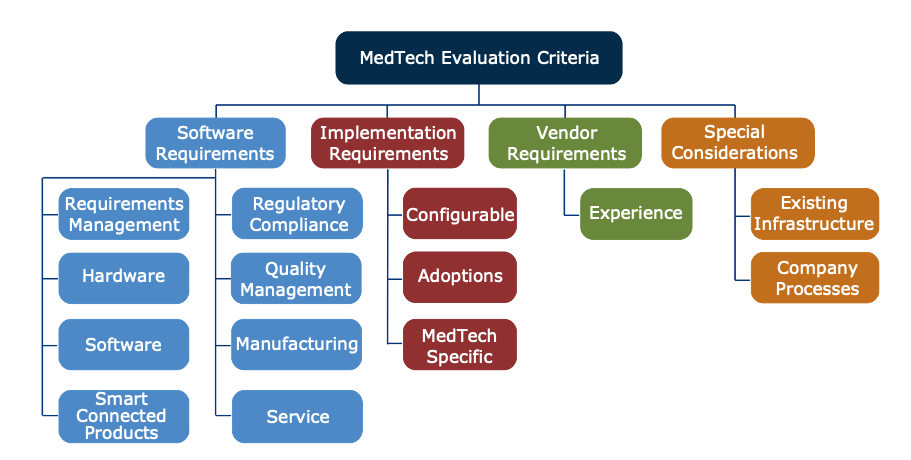
The Value of a Digital Thread
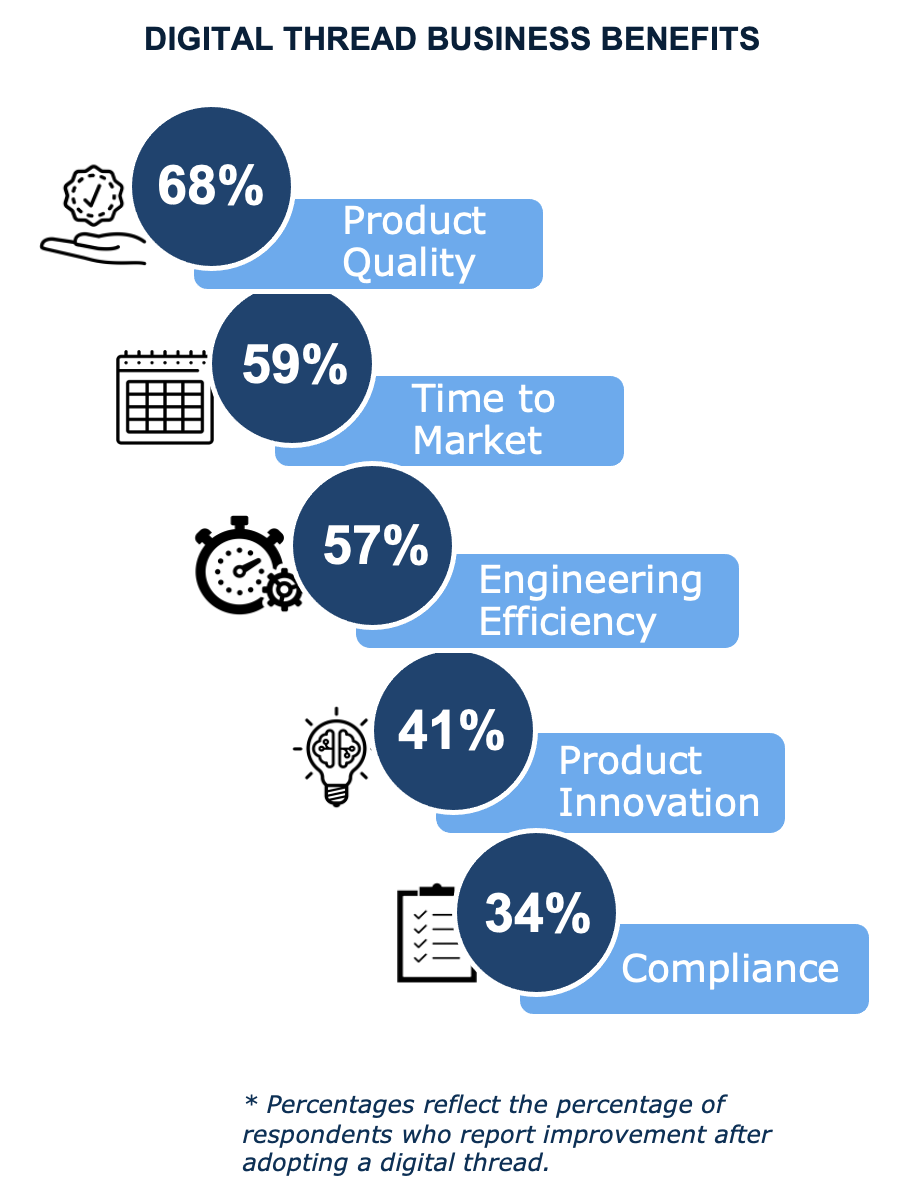 Operational Resilience
As regulations tighten and risks rise, full traceability has become critical. MedTech companies must demonstrate how decisions are made, how changes affect safety and performance, and maintain compliance from design to post-market support. Legacy systems cannot maintain this end-to-end visibility. A digital thread, enabled by an integrated solution, supports traceability, audit readiness, and proactive quality management.
Overcome Silos
A digital thread links requirements, design, engineering, manufacturing, quality, and service, making every decision traceable, every change visible, and every team aligned. Traceability accelerates root cause analysis, simplifies compliance, and improves first-time-right development. When requirements are linked to test results, quality and regulatory assurance become built-in.
By integrating Application Lifecycle Management (ALM), Product Lifecycle Management (PLM), Quality Management Systems (QMS), ERP, Manufacturing Execution Systems (MES), and Service Lifecycle Management (SLM), companies improve collaboration, manage requirements, plan for manufacturing, and leverage real-world service data in a shared digital environment. This integration yields numerous business benefits (see graphic).10
Prepare for the Future
This approach enables MedTech companies to transition from document-based processes to data-driven development, integrated quality systems, and connected service operations. It provides the agility needed to thrive in today's disruptive environment. The right solution will also support next-generation capabilities like AI, digital twins, and open interoperability.
Operational Resilience
As regulations tighten and risks rise, full traceability has become critical. MedTech companies must demonstrate how decisions are made, how changes affect safety and performance, and maintain compliance from design to post-market support. Legacy systems cannot maintain this end-to-end visibility. A digital thread, enabled by an integrated solution, supports traceability, audit readiness, and proactive quality management.
Overcome Silos
A digital thread links requirements, design, engineering, manufacturing, quality, and service, making every decision traceable, every change visible, and every team aligned. Traceability accelerates root cause analysis, simplifies compliance, and improves first-time-right development. When requirements are linked to test results, quality and regulatory assurance become built-in.
By integrating Application Lifecycle Management (ALM), Product Lifecycle Management (PLM), Quality Management Systems (QMS), ERP, Manufacturing Execution Systems (MES), and Service Lifecycle Management (SLM), companies improve collaboration, manage requirements, plan for manufacturing, and leverage real-world service data in a shared digital environment. This integration yields numerous business benefits (see graphic).10
Prepare for the Future
This approach enables MedTech companies to transition from document-based processes to data-driven development, integrated quality systems, and connected service operations. It provides the agility needed to thrive in today's disruptive environment. The right solution will also support next-generation capabilities like AI, digital twins, and open interoperability.
Adoption and Implementation
Accelerate Adoption To realize the expected value of the solution, it’s essential to drive adoption across teams, ensure systems integrate, and support long-term scalability. In a high-stakes, regulated environment, MedTech companies must transition with minimal disruption while transforming digitally. Why it Matters A modular, scalable architecture lets you start small and expand, minimizing disruption. A cloud-based deployment improves performance and global accessibility. Seamless integration with ERP, MES, and QMS reduces friction for cross-functional adoption. Flexible workflows and customizable UIs accommodate different process maturities and user roles, boosting usability. Low-code/no-code tools let admins adapt workflows, forms, and templates without heavy IT involvement. Combined with built-in analytics further supports adoption and performance. MedTech-specific templates, best-practice workflows, and structured onboarding all accelerate time to value. Validation-ready solutions simplify maintaining compliance under Computer Software Assurance (CSA).Conclusions and Next Steps
Prepare for the Future The MedTech sector is facing a perfect storm of challenges, including tightening regulations, geopolitical instability, rising costs, and constant pressure to innovate. To stay competitive, manufacturers must not only ensure product quality and patient safety, they must also build agility, resilience, and efficiency into their core processes for designing, developing, manufacturing, and servicing products. This requires a fundamental shift from fragmented systems and manual processes to a unified solution. These challenges jeopardize not only efficiency but also compliance, customer satisfaction, and even patient safety. The right solution can eliminate these bottlenecks by connecting every phase of the product lifecycle, integrating quality and compliance by design, and providing the digital agility that MedTech organizations need to thrive in a rapidly changing environment. Next Steps Use this buyer’s guide to define your organization’s priorities and must-have capabilities. Begin evaluating solution providers that offer integrated PLM, ALM, QMS, and service lifecycle tools tailored to the MedTech industry. Look for platforms that support regulatory compliance, multi-disciplinary collaboration, and scalable deployment. Engage cross-functional stakeholders early to align on goals and ensure a successful transformation. *This summary is an abbreviated version of the ebook and does not contain the full content. For the full report, please visit our sponsor PTC. If you have difficulty obtaining a copy of the research, please contact us. [post_title] => Buyer’s Guide for MedTech [post_excerpt] => [post_status] => publish [comment_status] => open [ping_status] => open [post_password] => [post_name] => medtech-buyers-guide [to_ping] => [pinged] => [post_modified] => 2025-09-17 09:57:38 [post_modified_gmt] => 2025-09-17 13:57:38 [post_content_filtered] => [post_parent] => 0 [guid] => https://tech-clarity.com/?p=22809 [menu_order] => 0 [post_type] => post [post_mime_type] => [comment_count] => 0 [filter] => raw ) [18] => WP_Post Object ( [ID] => 22937 [post_author] => 2572 [post_date] => 2025-09-16 23:35:29 [post_date_gmt] => 2025-09-17 03:35:29 [post_content] =>
Recently, we attended Realize LIVE 2025 events in both Detroit and Amsterdam. During these events, Siemens presented a clear and cohesive vision for helping customers manage increasing product complexity through digital transformation. This vision incorporates AI, cloud technology, a comprehensive digital twin, and an industry-tailored digital threads.
Across multiple presentations, starting with the vision shared by Siemens Digital Industries Software CEO Tony Hemmelgarn, Siemens positioned itself as a company dedicated to solving practical engineering challenges while embedding intelligence directly into workflows, integrating advanced simulation and AI, and closing the loop between design, manufacturing, and operations.
It was a wide-ranging program, but several consistent themes demonstrated how Siemens plans to realize this vision. While we can't cover everything discussed during the multi-day event, here are some highlights that stood out to us.
Key Themes
1. Tackling the Fundamentals
While new technologies like AI and immersive engineering draw attention, Tony Hemmelgarn reminded attendees that some of the most critical engineering challenges are deceptively "unsexy." He highlighted BOM management as an example. "It's not the most glamorous part of what we do," he said, "but if you can't manage your BOMs effectively, you can't make the right product, at the right time, at the right cost."
BOM management has become increasingly complex due to product variation, shorter cycles, and cross-domain dependencies. By embedding BOMs into the digital thread and connecting them to design, simulation, and manufacturing execution, service, and even supply chain, Siemens aims to prevent data mismatches and costly downstream errors. They highlighted several Teamcenter enhancements they’ve worked on:
- A 20x performance improvement over the past 18–24 months.
- A rules-based configurator that helps companies like GM validate buildable vehicle configurations.
- Out-of-the-box variant management tools replace years of costly customization in sectors such as mobile devices.
This focus on fundamental engineering execution indicates Siemens' commitment to solving core problems while also delivering next-generation technology.

2. AI as an Embedded Capability
Siemens positioned AI as an embedded capability that "works in the background," enhancing productivity without requiring process changes. Instead of being offered as a separate product line, AI is integrated throughout the Siemens Xcelerator portfolio, manifesting in generative design, automated simulation setup, manufacturability checks, and lifecycle intelligence, among many other areas.
We have been monitoring AI adoption, usage, and benefits through multiple studies. In our annual survey, Executive Strategies for Sustainable Business Success 2025, we found that since 2024, the percentage of companies reporting business value from AI has increased by an impressive 62%. In fact, AI was the technology most frequently cited as providing substantial value. Another research study, Making Manufacturing Analytics and AI Matter, indicated that AI is the technology most likely to yield a rapid time to benefit compared to others.

Tony shared an example of AI-enabled BOM management, "We asked Teamcenter to analyze warranty hotspots. AI interpreted severity and growth potential, pinpointed a problematic connector, created a change request, assessed supply chain risks, and found the best replacement, all automatically documented and visible to stakeholders."
This flow, from detection to resolution, demonstrates how Siemens is incorporating AI to accelerate decision-making, break down silos, and turn data into actionable insight. Joe Bohman further illustrated these capabilities by describing AI-assisted design optimization that happens in real time and design validation that flags production risks.
Tech-Clarity's research, The Business Value of Reducing Engineering Time Wasters, found that 96% of surveyed companies acknowledge that lost engineering productivity leads to significant business costs due to missed deadlines, higher expenses, decreased innovation, and poor quality. AI-embedded workflows like this show substantial potential for overcoming these challenges.
3. Simulation at the Core
Speakers repeatedly emphasized that simulation is central to Siemens’ comprehensive digital twin strategy, enabling companies to validate, optimize, and certify designs virtually, before committing to the physical product or prototype. The Simcenter portfolio supports multi-physics, system-level, high-fidelity simulation, with applications spanning multiple industries such as:
- Automotive: Thermal management and aerodynamics optimization with Simcenter Amesim and Simcenter STAR-CCM+ to validate EV powertrains.
- Aerospace: Structural and aerodynamic optimization for next-generation aircraft.
- Medtech: Simulating surgical device performance and fluid dynamics in medical instruments to validate compliance.
- Semiconductor: Thermal and structural analysis for chip packaging, ensuring reliability in high-density designs.
The recent Altair acquisition adds electromagnetic modeling and AI-driven process optimization, complementing Simcenter's existing capabilities. Altair SimSolid is a particularly exciting addition, as it eliminates the time-consuming geometry preparation and meshing process for analysis, providing design engineers with easier access to simulation for design guidance. During the Media and Analyst session, they also demonstrated simulation capabilities beyond Simcenter in EDA to support semiconductor lifecycle management and board design optimization.
4. The Digital Thread and the Comprehensive Digital Twin
At the core of Siemens' vision is the digital thread, an execution framework that links design, sourcing, simulation, manufacturing, supply chain, and service data in a cohesive flow. This framework also serves as the foundation for Siemens' comprehensive digital twin, which not only represents the product, but also encompasses production processes and operational behavior over time.
Siemens presented digital thread use cases spanning multiple industries, for example:
- Automotive: Thermal management and aerodynamics optimization with Simcenter Amesim and Simcenter STAR-CCM+ to validate EV powertrains.
- Aerospace: Structural and aerodynamic optimization for next-generation aircraft.
- Medtech: Simulating surgical device performance and fluid dynamics in medical instruments to validate compliance.
- Semiconductor: Thermal and structural analysis for chip packaging, ensuring reliability in high-density designs.
The key takeaway is that data should not merely be stored; it must be connected, contextualized, and utilized to inform better decisions throughout the product lifecycle.

5. Immersive Engineering and Human-Centered Design
During the NX keynote, Robert Haubrock introduced Immersive Engineering featuring a purpose-built Sony headset with "4K resolution per eye," which is available now. This resolution exceeds what the human eye typically perceives. Siemens views this technology as a tool for more intuitive design reviews, allowing engineers to walk through models, identify spatial issues, and collaborate in real-time. Bob emphasized, "The only way to understand it is to put it on your head." Beyond enhancing productivity, Siemens positions these immersive tools as appealing to the next generation of engineers, accustomed to interactive, high-fidelity experiences from the world of gaming. Our surveys and discussions with manufacturers show that AR/VR adoption is still low, but we believe it can provide significant value, especially as innovations around complementary technologies grow.
6. Modular Access and Broader Reach
Siemens highlighted the scalability of its design platform, Designcenter, which encompasses both NX and Solid Edge. For more on Designcenter, see our previous commentary in A Siemens NX Update: Extending Access and MBE. With this platform, the company is committed to making advanced capabilities more accessible by offering value-based licensing models. This approach allows customers to access features without investing in full enterprise suites.
Further, Siemens continues solidifying its position as a foundational technology provider, claiming that over 70% of the global solid modeling market relies on its PLM Components technology, including its kernel, Parasolid, also common across both Solid Edge and NX. This strategy promotes openness with third-party applications, facilitating seamless data flow between systems that use the same kernel. Additionally, this foundation supports AI-based applications that can leverage data across various platforms and tools.

7. Extending Value with Low-Code
Siemens continues to expand access to digital capabilities through Mendix, its low-code application development environment. Mendix enables non-IT specialists to create applications, adapt core applications, automate workflows, and integrate data. By doing so, low-code technology broadens the reach of the digital thread across the enterprise, accelerates transformation, and allows more stakeholders to participate in problem-solving. Mendix extends Siemens Xcelerator capabilities and promotes further adoption by allowing companies to develop purpose-built, composable applications to meet the unique needs of their people. For more of our analysis on Mendix please see Adapt and Extend Applications with Mendix.
8. Cloud Strategy
Siemens' cloud vision centers on delivering its Siemens Xcelerator portfolio as SaaS, with offerings such as NX X, Teamcenter X, and other "X" solutions. Their approach focuses on flexibility, scalability, and continuous updates, eliminating the IT overhead associated with traditional deployments. By hosting design, engineering, and manufacturing solutions in a secure, integrated cloud environment, Siemens aims to enhance collaboration, simplify adoption, and make emerging technologies like AI more readily available to customers. Tech-Clarity's research, The Business Value of Reducing Engineering Time Wasters, respondents reported that cloud-based solutions were implemented in nearly 50% less time than non-cloud alternatives. Further, 78% of those who described their implementation as "easy" had deployed a cloud-based solution.
Strategic Implications
In summary, here are some key strategic implications from the vision presented at the events:
- Embedded AI: This approach utilizes AI as an engineering tool to enhance existing workflows rather than replace them.
- Simulation-First Design: This strengthens Siemens' digital twin strategy, bolstered by the recent Altair acquisition.
- Attention to Fundamentals: Emphasizing basics like Bill of Materials (BOMs) helps reinforce credibility with engineering teams.
- Immersive Tools: These tools have the potential to accelerate collaboration and attract new talent; however, they will need to demonstrate proven return on investment (ROI).
- Digital Thread + Comprehensive Digital Twin: This combination creates a systems-of-systems advantage that may make it difficult for point solutions to compete.
- Cloud-First Delivery: This approach may facilitate faster adoption of AI and simulation technologies while minimizing IT friction.
Our Take
One of the notable aspects of Siemens' presentations was the balance between forward-looking innovation and the practical realities of day-to-day engineering. Exciting concepts like high-fidelity simulation, AI-assisted design, and immersive virtual reality (VR) were complemented by a strong emphasis on BOM management and the execution framework of the digital thread. This demonstrates Siemens' understanding that attention to fundamental aspects is just as important as pursuing breakthroughs.
We look forward to seeing how Siemens evolves its vision into mainstream engineering practices, especially with the exciting developments in physics AI that promise to make simulation tools even more accessible.
Tech-Clarity's research, How to Engineer Innovation, found that an overwhelming 99% of respondents find benefits in using simulation to explore design ideas to innovate and optimize designs in less time. Still, most agree that they could leverage simulation more effectively than they currently do. Integrating AI could be a key factor in unlocking even greater value from simulation.
Thanks
Thank you to Shaun Ennis, Heike Hofmann, and Julia Martin for the invitation and all the coordination to ensure we made the most of our time at the event. We'd also like to extend a special thanks to Brenda Discher, George Rendell, Tom Spangler, S. Ravi Shankar, Jean Claude Ercolanelli, and Jennifer Ferello for their thoughtful discussions and meeting with us one-on-one to answer our questions.
[post_title] => Siemens Realize LIVE 2025: A Vision for AI, Simulation, and Immersive Engineering in a Connected Digital Thread [post_excerpt] => [post_status] => publish [comment_status] => open [ping_status] => open [post_password] => [post_name] => siemens-realize-live-2025 [to_ping] => [pinged] => [post_modified] => 2025-10-01 23:37:00 [post_modified_gmt] => 2025-10-02 03:37:00 [post_content_filtered] => [post_parent] => 0 [guid] => https://tech-clarity.com/?p=22937 [menu_order] => 0 [post_type] => post [post_mime_type] => [comment_count] => 0 [filter] => raw ) [19] => WP_Post Object ( [ID] => 22467 [post_author] => 2572 [post_date] => 2025-09-16 09:06:29 [post_date_gmt] => 2025-09-16 13:06:29 [post_content] =>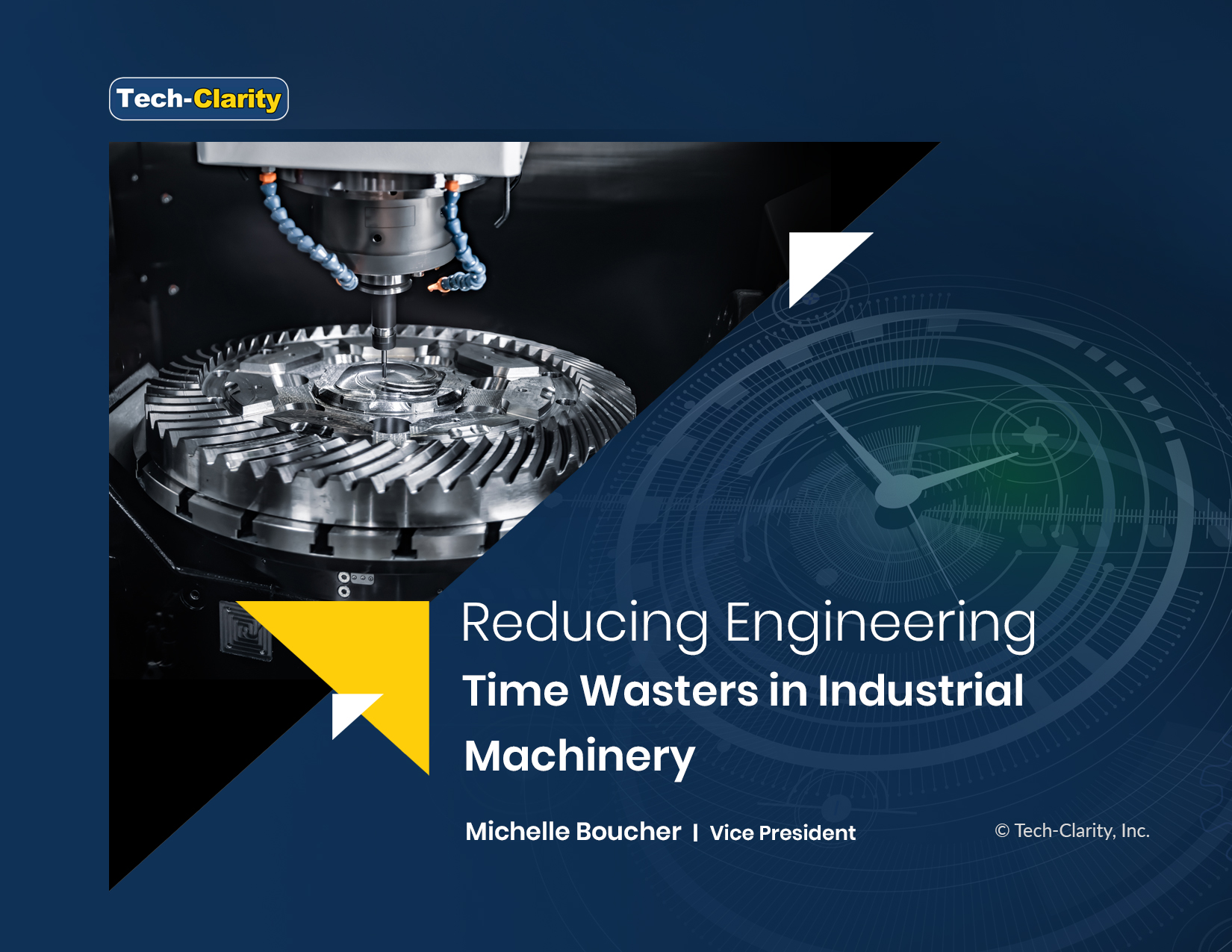 How can machine builders improve engineering productivity?
Industrial machinery has become increasingly complex, with even more mechanical components, electronics, and software. Customer needs for improved maintainability, increased automation, and better efficiency have driven this complexity further. Engineers are critical to successfully meet these requirements. Yet, engineers regularly lose productivity to non-value-add tasks that not only rob them of their ability to innovate, but also threaten their company’s ability to compete, differentiate, and grow. Imagine the potential of identifying and removing the most common non-value-add activities engineers face and empowering them to focus on designing better machines.
This research examines how engineers spend their time, where they lose productivity, and the impact on the business. It then identifies solutions and approaches to reduce time wasters. Based on a survey of 228 manufacturers across industries, this report shares the results of the industrial equipment industry and looks at their challenges and opportunities from the perspective of industrial machinery companies.
Please enjoy the summary* below. For the full research, please visit our sponsor, Siemens (registration required).
This report is based off the research published in The Business Value of Reducing Engineering Time Wasters which takes a look across all industries.
For other industry-specific related research, read:
How can machine builders improve engineering productivity?
Industrial machinery has become increasingly complex, with even more mechanical components, electronics, and software. Customer needs for improved maintainability, increased automation, and better efficiency have driven this complexity further. Engineers are critical to successfully meet these requirements. Yet, engineers regularly lose productivity to non-value-add tasks that not only rob them of their ability to innovate, but also threaten their company’s ability to compete, differentiate, and grow. Imagine the potential of identifying and removing the most common non-value-add activities engineers face and empowering them to focus on designing better machines.
This research examines how engineers spend their time, where they lose productivity, and the impact on the business. It then identifies solutions and approaches to reduce time wasters. Based on a survey of 228 manufacturers across industries, this report shares the results of the industrial equipment industry and looks at their challenges and opportunities from the perspective of industrial machinery companies.
Please enjoy the summary* below. For the full research, please visit our sponsor, Siemens (registration required).
This report is based off the research published in The Business Value of Reducing Engineering Time Wasters which takes a look across all industries.
For other industry-specific related research, read:
- Reducing Engineering Time Wasters in Aerospace & Defense
- Reducing Engineering Time Wasters in Heavy Equipment
- Reducing Engineering Time Wasters in Consumer Products
- Reducing Engineering Time Wasters in Shipbuilding
Table of Contents
- Executive Summary
- Product Development Is Critical to Business Strategies
- The Time Wasters
- Implications of Time Wasters to the Business
- A Solution to Avoid Time Wasters
- Business Value from PLM
- Extending PLM Use Results in Greater Satisfaction
- How Companies Implement PLM
- Additional Values Due to the Cloud
- Conclusions
- Recommendations
- About the Research
- Acknowledgments
Executive Summary
Engineers Impact Business Success Engineering is critical to exceptional machine design. Likewise, engineers are crucial to ensure designs incorporate customer requirements, stay within budget, and meet delivery dates. Therefore, empowering engineers is key to the successful execution of business strategies. Too Many Time Wasters Unfortunately, engineers report spending too much time on non-value-added work with too many interruptions, taking them away from critical innovation work. Furthermore, 96% of surveyed equipment companies say this loss in engineering productivity comes at a significant business cost due to missed deadlines, higher costs, and less innovation. To overcome productivity losses, one approach is to manage product data better and make it accessible to those who need it, when they need it. Reclaiming Wasted Time This report identifies substantial engineering time wasters in the industrial machinery industry by examining survey results of industrial equipment manufacturers. The analysis focuses on these results from the perspective of an industrial machinery company. This report explores how companies of all sizes reclaim lost time by examining the use and value of PLM (Product Lifecycle Management) solutions to centralize data across multiple domains, manage processes, and collaborate better. Incidentally, PLM users reported fewer changes due to outdated information and errors, significantly reducing non-value-added work and shortening development times. This report also examines how companies select and use PLM solutions, including cloud-based implementations.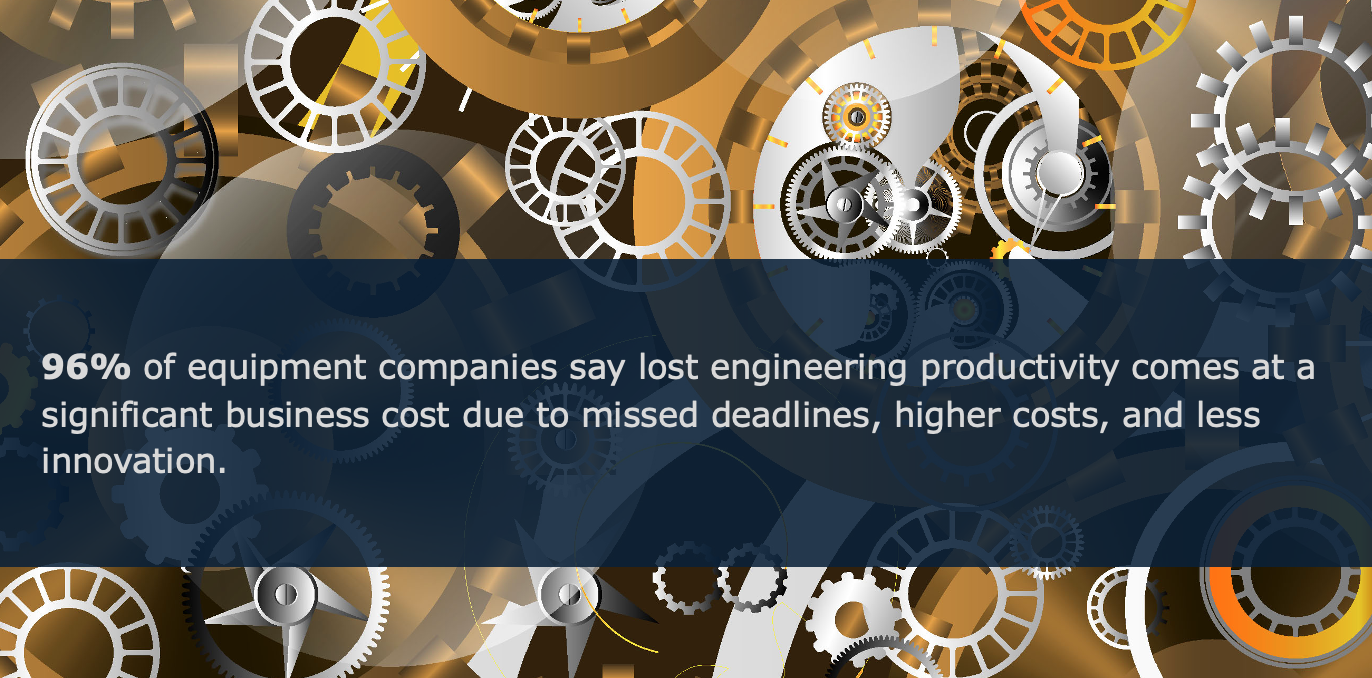 Product Development Is Critical to Business Strategies
Product Development Is Critical to Business Strategies
Business Strategies for Equipment Manufacturers of All Sizes
To understand what’s most important to equipment manufacturers of all sizes, Tech-Clarity asked about their business strategies (see graph). No matter the approach, the focus is on better equipment, either developing new offerings, improving them, or expanding their appeal.
Equipment companies are more likely to differentiate through product quality, performance, and innovation rather than compete on cost. From an industrial machinery company’s perspective, it is better to have superior offerings with a predictable cost rather than undercut competing bids with the lowest price. Winning a bid that is priced too low will only cut into margins, compromising profitability. Instead, high quality and performance can justify a higher price that provides more cushion to maintain profitable margins. Their brand differentiation also relies on meeting customer requirements and promised delivery dates as a reputation for quality and reliability is one of the best strategies for winning future bids. However, to achieve this, industrial machinery companies must empower their engineers to support a predictable process at the time of the bid to deliver what's promised on time and on budget.
Why Engineering Time Wasters?
As industrial machinery companies strive to differentiate through greater automation, improved energy efficiency, and new service offerings, equipment continues to evolve into complex interconnected systems of mechanical components, electronics, and software. This complexity increases the risk of errors. Plus, the "one-off" nature to meet unique customer needs within a tight timeline puts even more pressure on engineers. Any delay or error may result in disappointed customers, putting future business at risk.
While there's a lot to manage, supply chain disruptions can create opportunities for suppliers as OEMs look for new sources for components and subsystems. However, engineers need to be ready to respond to the increased demand. In other cases, machine designers must quickly adapt when supplied components come from a different supplier. Regardless of the opportunity, industrial machinery companies must empower their engineers to deliver value by strengthening the company's product development capabilities to win customer loyalty.
The Time Wasters
What Slows Engineers Down? The graph identifies the top engineering time wasters equipment manufacturers face. The findings highlight how much time engineers waste on non-value-added work. They need better ways to automate tedious tasks so engineers can focus more energy on ensuring customer requirements are met. Another top-ranking time waster, too many manual processes/bottlenecks, emphasizes this further. Interruptions Similarly, constant interruptions to answer questions, share data, and provide updates to others also slows engineers down. These interruptions break an engineer's train of thought and take them away from the work they need to focus on. Yet, exchanging data is critical to prevent engineers across domains from working with outdated data. Poor Collaboration Along with interruptions, equipment manufacturers find that poor collaboration also wastes time. The findings reveal that poor collaboration is a challenge for small, medium, and large companies alike. However, the integrated nature of machine design components, mechanisms, and systems requires good collaboration so that everyone on the development team, across all disciplines is aware of changes that impacts them. Otherwise, they waste time searching for needed data or redoing work. Difficulties consolidating engineering information across disciplines further complicates this. Redoing Work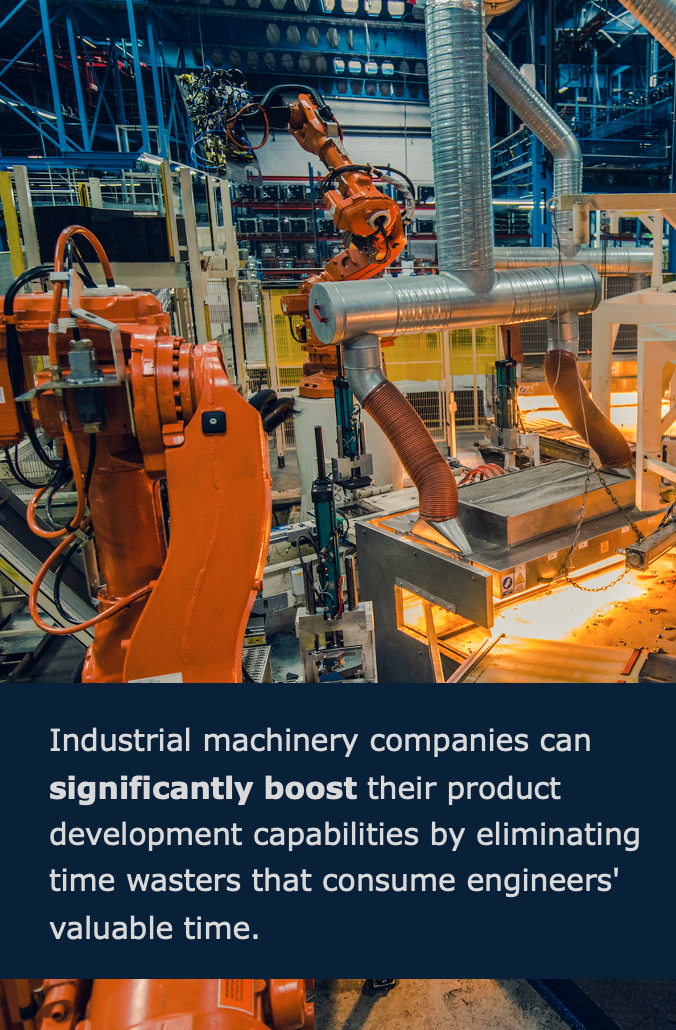 Machine designers also waste efforts redoing work. They waste time recreating what they can’t find or fixing errors due to outdated or conflicting information. Better methods to centralize access to data would help get that time back.
Machine designers also waste efforts redoing work. They waste time recreating what they can’t find or fixing errors due to outdated or conflicting information. Better methods to centralize access to data would help get that time back.
Conclusions
Reclaiming Lost Time Industrial machinery companies prioritize their future growth and sustained success on winning in the marketplace with better, differentiated equipment. To support this, they can significantly boost their product development capabilities by eliminating time wasters that consume engineers' valuable time. Equipment manufacturers find that PLM can empower their engineers to innovate by significantly reducing engineers' time on non-value-added tasks. As a result, they can enjoy a competitive advantage. In addition, technological advances, such as cloud-based offerings, can reduce implementation time, cost, and difficulty, making PLM more accessible. *This summary is an abbreviated version of the ebook and does not contain the full content. For the full report, please visit our sponsor Siemens. If you have difficulty obtaining a copy of the research, please contact us. [post_title] => Industrial Machinery: Reducing Engineering Time Wasters [post_excerpt] => [post_status] => publish [comment_status] => open [ping_status] => open [post_password] => [post_name] => industrial-machinery [to_ping] => [pinged] => [post_modified] => 2025-09-16 09:06:30 [post_modified_gmt] => 2025-09-16 13:06:30 [post_content_filtered] => [post_parent] => 0 [guid] => https://tech-clarity.com/?p=22467 [menu_order] => 0 [post_type] => post [post_mime_type] => [comment_count] => 0 [filter] => raw ) ) [post_count] => 20 [current_post] => -1 [before_loop] => 1 [in_the_loop] => [post] => WP_Post Object ( [ID] => 23169 [post_author] => 2581 [post_date] => 2025-11-19 10:49:52 [post_date_gmt] => 2025-11-19 15:49:52 [post_content] =>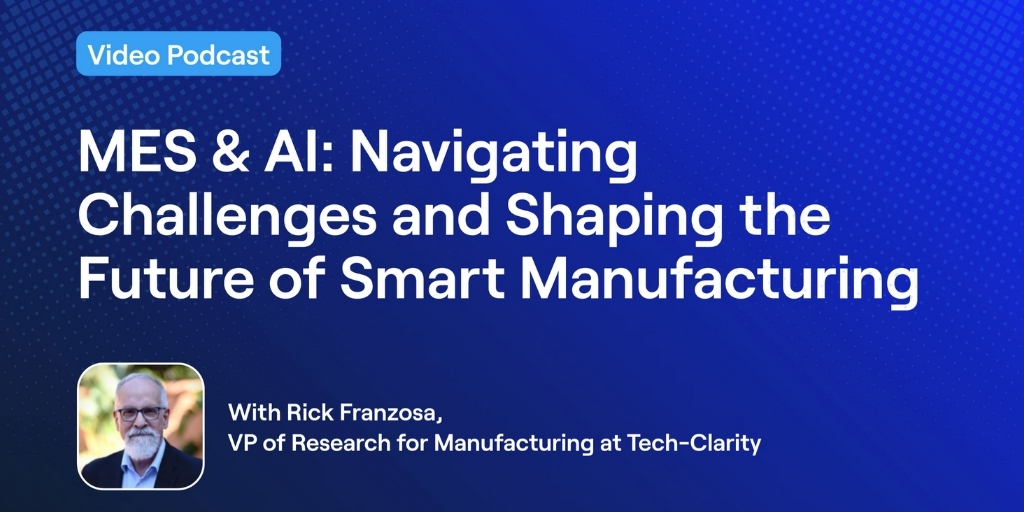 Is your manufacturing organization ready for AI? In this conversation David J. Jacq, CEO of Mapex, and Rick Franzosa, VP of Research for Manufacturing at Tech-Clarity, Inc., will bring their deep expertise in digital transformation, operations, and advanced manufacturing to explore the challenges and opportunities in smart manufacturing in the age of AI.
Listen as David asks Rick about what companies should prioritize in this fast-changing world. Rick shares his view of top challenges and the evolving perceptions of MES, including when it became more strategic. They also explore MES implementation wisdom, including common mistakes and what companies need to do before an implementation. Even implementation failures come into the session.
They wrap up with a discussion of how AI has changed the role of MES – shallow or deep? Is AI a differentiating factor for MES already? How to avoid false starts when adding AI to MES. And a look ahead at what industrial companies should be doing now to prepare their operations for unknown future realities. Watch the full video podcast here.
[post_title] => Inaugural Mapex International Smart Industry Podcast on Digital Manufacturing and AI
[post_excerpt] =>
[post_status] => publish
[comment_status] => open
[ping_status] => open
[post_password] =>
[post_name] => smart-industry-podcast-on-digital-manufacturing-and-ai
[to_ping] =>
[pinged] =>
[post_modified] => 2025-11-19 10:52:06
[post_modified_gmt] => 2025-11-19 15:52:06
[post_content_filtered] =>
[post_parent] => 0
[guid] => https://tech-clarity.com/?p=23169
[menu_order] => 0
[post_type] => post
[post_mime_type] =>
[comment_count] => 0
[filter] => raw
)
[comment_count] => 0
[current_comment] => -1
[found_posts] => 799
[max_num_pages] => 40
[max_num_comment_pages] => 0
[is_single] =>
[is_preview] =>
[is_page] =>
[is_archive] =>
[is_date] =>
[is_year] =>
[is_month] =>
[is_day] =>
[is_time] =>
[is_author] =>
[is_category] =>
[is_tag] =>
[is_tax] =>
[is_search] =>
[is_feed] =>
[is_comment_feed] =>
[is_trackback] =>
[is_home] => 1
[is_privacy_policy] =>
[is_404] =>
[is_embed] =>
[is_paged] =>
[is_admin] =>
[is_attachment] =>
[is_singular] =>
[is_robots] =>
[is_favicon] =>
[is_posts_page] =>
[is_post_type_archive] =>
[query_vars_hash:WP_Query:private] => 2cea57cc955f0bdca63519b345c52717
[query_vars_changed:WP_Query:private] => 1
[thumbnails_cached] =>
[allow_query_attachment_by_filename:protected] =>
[stopwords:WP_Query:private] =>
[compat_fields:WP_Query:private] => Array
(
[0] => query_vars_hash
[1] => query_vars_changed
)
[compat_methods:WP_Query:private] => Array
(
[0] => init_query_flags
[1] => parse_tax_query
)
[query_cache_key:WP_Query:private] => wp_query:370ba7466be266bdc5cf7eb72c1b48bb:0.65533400 17635675720.66497300 1763567572
)
Is your manufacturing organization ready for AI? In this conversation David J. Jacq, CEO of Mapex, and Rick Franzosa, VP of Research for Manufacturing at Tech-Clarity, Inc., will bring their deep expertise in digital transformation, operations, and advanced manufacturing to explore the challenges and opportunities in smart manufacturing in the age of AI.
Listen as David asks Rick about what companies should prioritize in this fast-changing world. Rick shares his view of top challenges and the evolving perceptions of MES, including when it became more strategic. They also explore MES implementation wisdom, including common mistakes and what companies need to do before an implementation. Even implementation failures come into the session.
They wrap up with a discussion of how AI has changed the role of MES – shallow or deep? Is AI a differentiating factor for MES already? How to avoid false starts when adding AI to MES. And a look ahead at what industrial companies should be doing now to prepare their operations for unknown future realities. Watch the full video podcast here.
[post_title] => Inaugural Mapex International Smart Industry Podcast on Digital Manufacturing and AI
[post_excerpt] =>
[post_status] => publish
[comment_status] => open
[ping_status] => open
[post_password] =>
[post_name] => smart-industry-podcast-on-digital-manufacturing-and-ai
[to_ping] =>
[pinged] =>
[post_modified] => 2025-11-19 10:52:06
[post_modified_gmt] => 2025-11-19 15:52:06
[post_content_filtered] =>
[post_parent] => 0
[guid] => https://tech-clarity.com/?p=23169
[menu_order] => 0
[post_type] => post
[post_mime_type] =>
[comment_count] => 0
[filter] => raw
)
[comment_count] => 0
[current_comment] => -1
[found_posts] => 799
[max_num_pages] => 40
[max_num_comment_pages] => 0
[is_single] =>
[is_preview] =>
[is_page] =>
[is_archive] =>
[is_date] =>
[is_year] =>
[is_month] =>
[is_day] =>
[is_time] =>
[is_author] =>
[is_category] =>
[is_tag] =>
[is_tax] =>
[is_search] =>
[is_feed] =>
[is_comment_feed] =>
[is_trackback] =>
[is_home] => 1
[is_privacy_policy] =>
[is_404] =>
[is_embed] =>
[is_paged] =>
[is_admin] =>
[is_attachment] =>
[is_singular] =>
[is_robots] =>
[is_favicon] =>
[is_posts_page] =>
[is_post_type_archive] =>
[query_vars_hash:WP_Query:private] => 2cea57cc955f0bdca63519b345c52717
[query_vars_changed:WP_Query:private] => 1
[thumbnails_cached] =>
[allow_query_attachment_by_filename:protected] =>
[stopwords:WP_Query:private] =>
[compat_fields:WP_Query:private] => Array
(
[0] => query_vars_hash
[1] => query_vars_changed
)
[compat_methods:WP_Query:private] => Array
(
[0] => init_query_flags
[1] => parse_tax_query
)
[query_cache_key:WP_Query:private] => wp_query:370ba7466be266bdc5cf7eb72c1b48bb:0.65533400 17635675720.66497300 1763567572
)
All Results for "All"
ISE MV2 Provides MES Functionality for an Underserved Market
The market for MES in mid-sized manufacturers has traditionally been underserved. Major MES vendors find it unsuitable, as it conflicts with their direct sales model and complex product offerings. However, mid-sized manufacturers have the same MES needs as larger companies but lack the IT resources necessary to implement and support these systems. Decades of Service…
Tech Soft 3D Introduces HOOPS AI for Accelerated AI Adoption
Software Components and AI Developing 3D engineering applications is seldom fast or easy. One way to ease development is to use commercially available software components. Software components are developer toolkits that provide standard application capabilities such as modeling, visualization, and data exchange. By using components, development resources can focus on the secret sauce that makes…
TwinThread Adds Advisor, Centerline Solution
Once you have a digital twin of a plant that includes predictive and prescriptive AI capabilities, how could you improve it? TwinThread is doing that by adding genAI and agentic AI in Advisor to help accelerate model interpretation, as well as a new solution aptly named Perfect Centerline to help manage and stabilize the…
Five Keys to Bring ECAD into the Digital Thread
Product innovation today is driven by an orchestration of mechanical, electrical, and software components working together as a system. So why hasn’t ECAD data management gotten the attention compared to MCAD data management with PDM? ECAD designs have gone uncontrolled in most engineering organizations for too long. It’s time for manufacturers to modernize how they…
Solving the Design Data Dilemma
How can manufacturers manage their complex design data, including both MCAD and ECAD files, to streamline design, eliminate wasted time looking for design data, and improve collaboration? Jim Brown will moderate a webinar, From Chaos to Collaboration: Solving the Design Data Dilemma, to hear from Propel and their partners on how they can seamlessly manage…
Fuuz Doubles Down on Enterprise for Industrial DataOps and Level 3 Apps
How far can large enterprises go in consolidating their software stack from IIoT and data foundations to apps? Could a startup EV OEM run its business on just two pieces of software? Fuuz, by MFGx, aims to answer that second question with a yes, using just Fuuz and Oracle NetSuite. We recently had an update…
Manufacturing Operations Digital Assessment
How mature is your digital approach to manufacturing operations? What are the next steps you need to take on your journey to improve digital support for the plant floor and support teams? Take our Manufacturing Operations Digital Maturity Assessment to find out. The assessment leverages our research to assess your company’s digitalization progress in manufacturing…
Four Ways Unmanaged CAD/CAM Hurts Job Shops
Why is managing CAD/CAM important to job shops? How does poor manufacturing data management negatively impact job shop performance and profits? More importantly, what lessons learned can they from managing product data to add control without burdening already busy resources? Read the full report here, or download the full PDF, courtesy of Siemens. You can…
Leucine Pharma MES for Efficient Compliance Grows with Ecolab
What do pharmaceutical manufacturers most need? To be compliant with government regulations without wasting time and effort. Leucine set out to deliver that with its SaaS software suite, which includes hubs for Manufacturing, Quality, and, most recently, Laboratory, with Intelligence (including AI) serving it all. The company launched in 2019 and joined forces with Ecolab…
Alpiconn Ready to Deliver SMB Operations Software Beyond Greece
How can small and mid-size businesses (SMBs) – specifically manufacturers and warehouses – gain an operations digital thread that connects from materials movement through production and quality? Ideally, with well-integrated, easy-to-deploy software. Alpiconn has been delivering a combination of MES, WMS, CMMS, QMS, and traceability for the past decade. By focusing on practicality, flexibility, and…
State of Product Development
Is your approach to product development helping you compete or holding you back? Product development teams today face growing pressure to respond to market volatility, supply chain disruptions, and global competition. At the same time, they’re dealing with long-standing challenges like manual inefficiencies, poor collaboration, disconnected systems, and workforce shortages. These issues cause costly delays,…
Accelerating MedTech Transformation
How can MedTech companies accelerate digital transformation? On Thursday, October 23 at 10:00 am EDT, please join Tech-Clarity’s Michelle Boucher for an interactive discussion with Christian Vogelei of Fresenius Medical Care and René Zoelfl of PTC as they discuss this. They will explore topics like: Why MedTech companies should consider digital transformation The benefit MedTech…
How to Manage Capital-Intensive Projects
How can companies managing capital-intensive projects, such as factories, nuclear facilities, offshore platforms, rail infrastructure, and data centers, avoid delays and cost overruns? What leads to successful projects? Significant growth is expected in the number of capital-intensive projects over the next few years. However, many of these projects will face delays, cost overruns, and execution…
Dassault Systèmes’ DELMIA Expands to Software-Defined Production, Tech Transfer, Recipes
Can manufacturers gain an effective digital twin capability spanning from product concept to supply chain, production process, production execution, factory automation, and controls? Dassault Systèmes believes it can deliver that today. Their UNIV+RSES vision expanded deep into the plant floor with their July acquisition of Ascon’s Qube technology and team. This new edge-to-cloud platform complements…
Siemens Opcenter’s TCO and Scalability Help Fuel Digital Thread
What if MES were fully natively integrated into an end-to-end suite across the product and production lifecycle? For years, industry analysts have remarked that Siemens had acquired all the pieces—if only they could put them together. We recently had a briefing that focused on the MES, Opcenter, and the progress made toward the end-to-end goal:…
Pico MES/IIoT for Scalable Rapid Digitalization
Can a discrete manufacturer get data from each tool, line, or piece of equipment into an MES and start using it in hours rather than weeks or months? PICO MES was founded to do that, and its Pico MES/IIoT software is now connected and in use at large, medium, and small manufacturers in automotive, aerospace,…
Buyer’s Guide for MedTech
What will help MedTech companies stay competitive in an era marked by rapid innovation, rising regulatory complexity, and global disruption? As the industry moves toward smarter, more personalized, and increasingly connected healthcare, MedTech manufacturers face mounting pressure to reduce time to market, improve patient outcomes, control costs, and ensure compliance without sacrificing quality or patient…
Siemens Realize LIVE 2025: A Vision for AI, Simulation, and Immersive Engineering in a Connected Digital Thread
Recently, we attended Realize LIVE 2025 events in both Detroit and Amsterdam. During these events, Siemens presented a clear and cohesive vision for helping customers manage increasing product complexity through digital transformation. This vision incorporates AI, cloud technology, a comprehensive digital twin, and an industry-tailored digital threads. Across multiple presentations, starting with the vision shared…
Industrial Machinery: Reducing Engineering Time Wasters
How can machine builders improve engineering productivity? Industrial machinery has become increasingly complex, with even more mechanical components, electronics, and software. Customer needs for improved maintainability, increased automation, and better efficiency have driven this complexity further. Engineers are critical to successfully meet these requirements. Yet, engineers regularly lose productivity to non-value-add tasks that not only…


